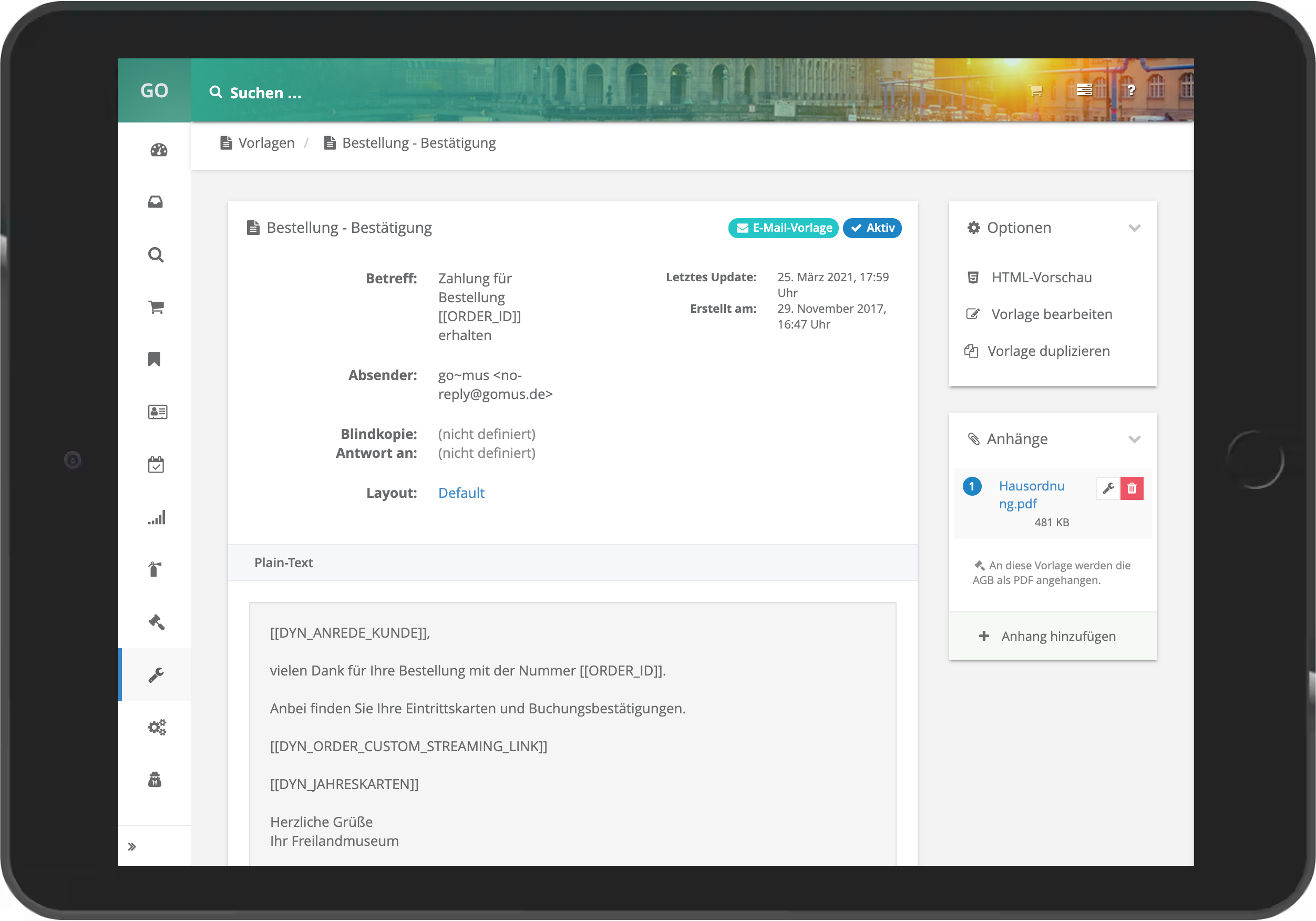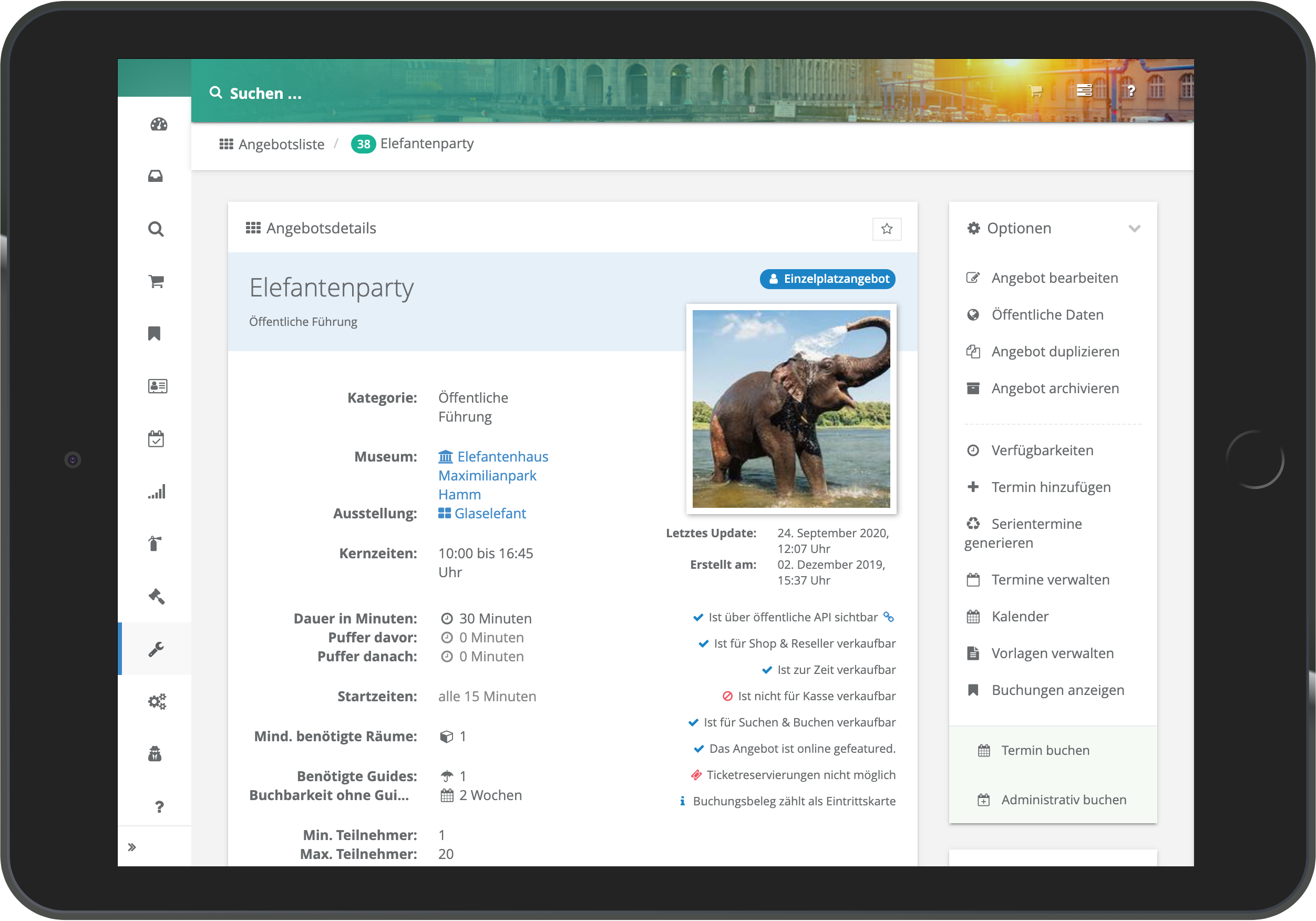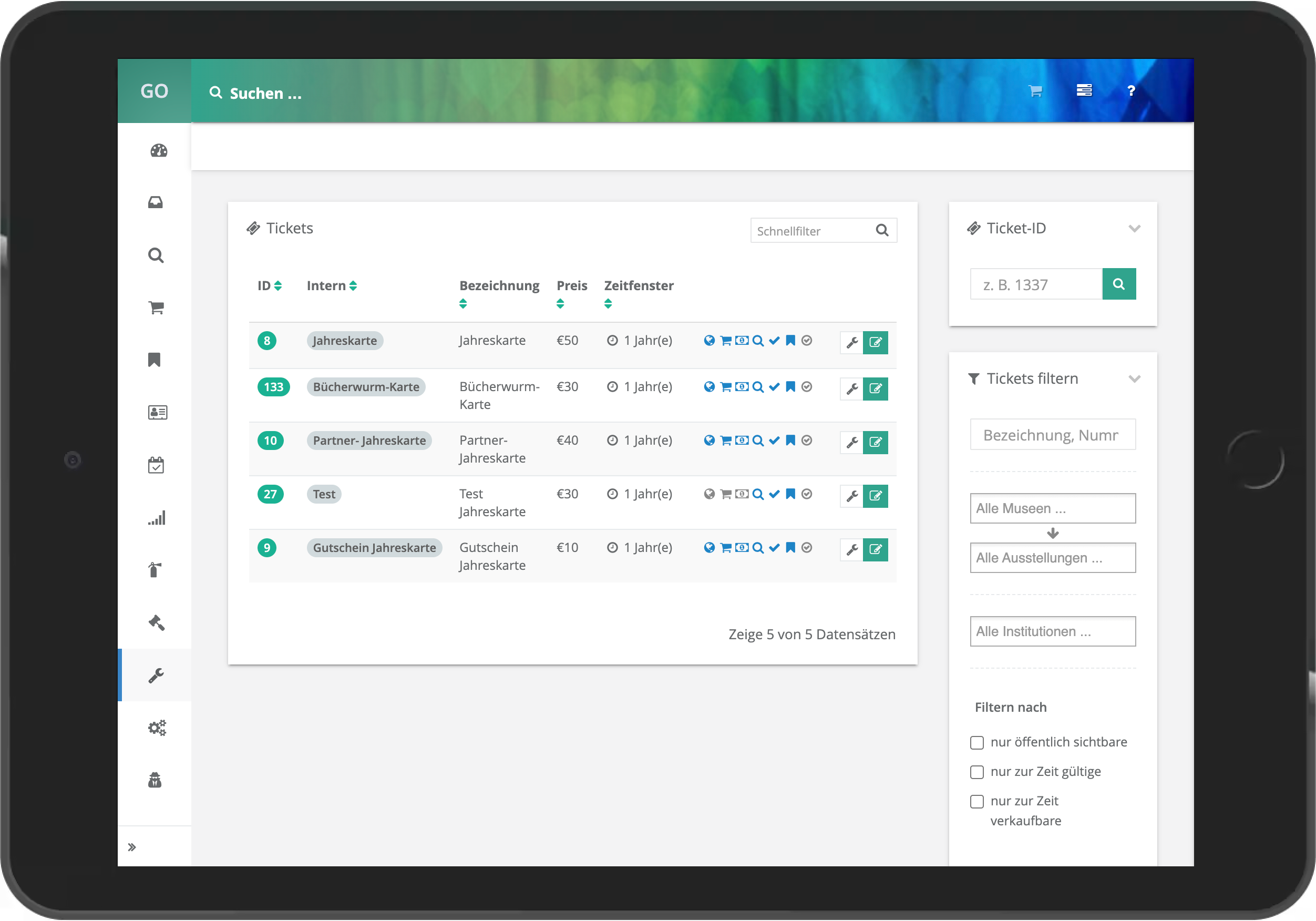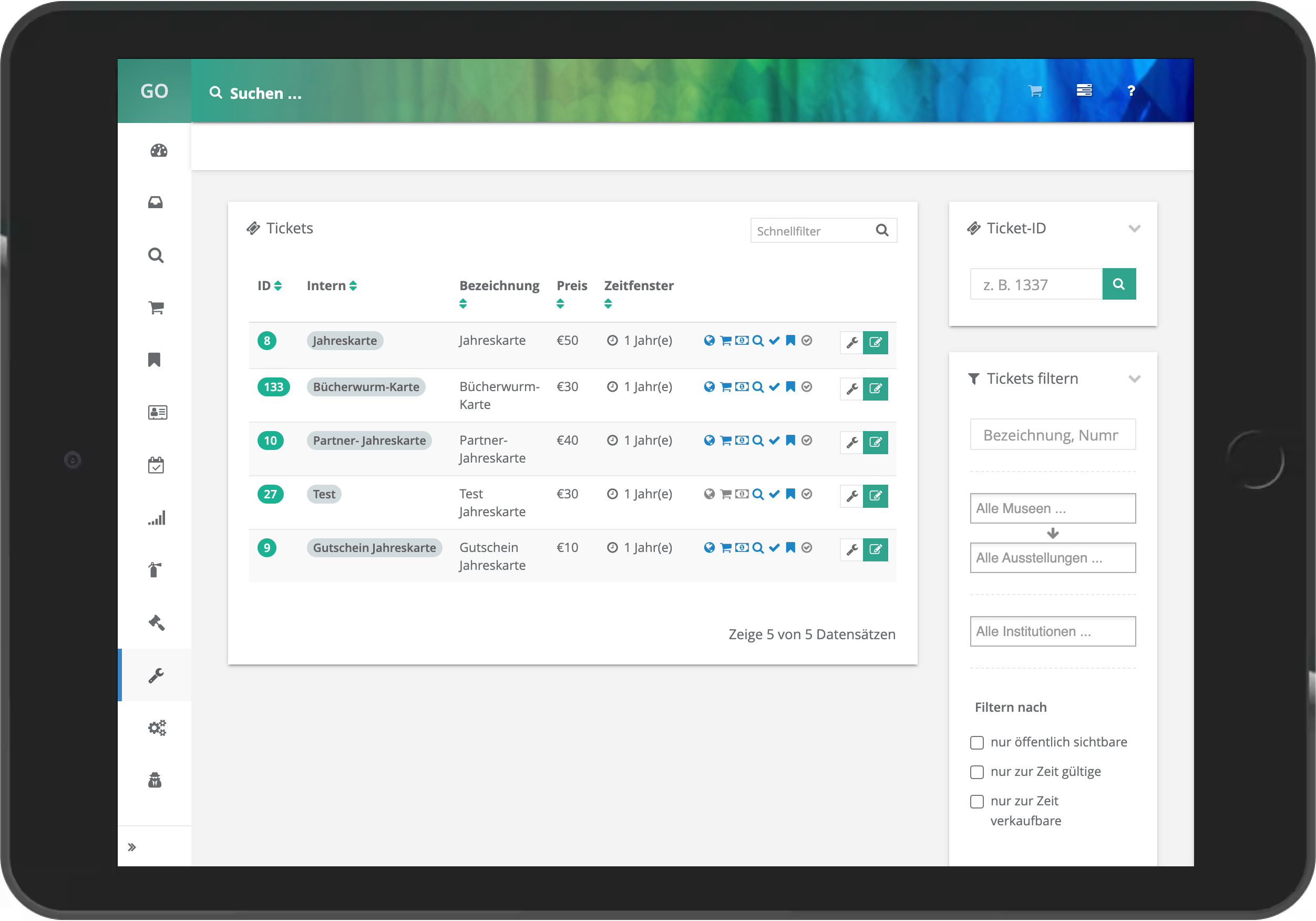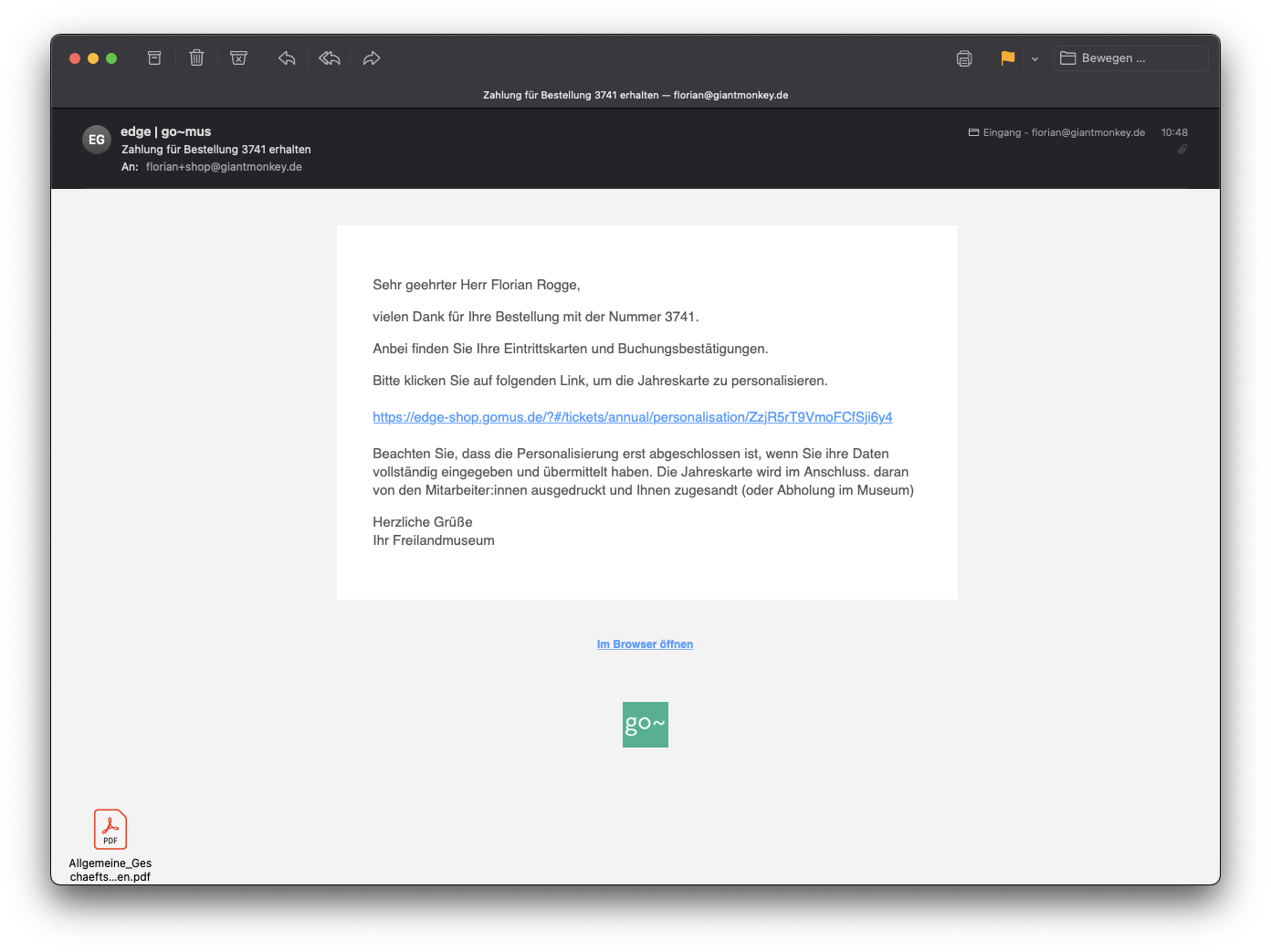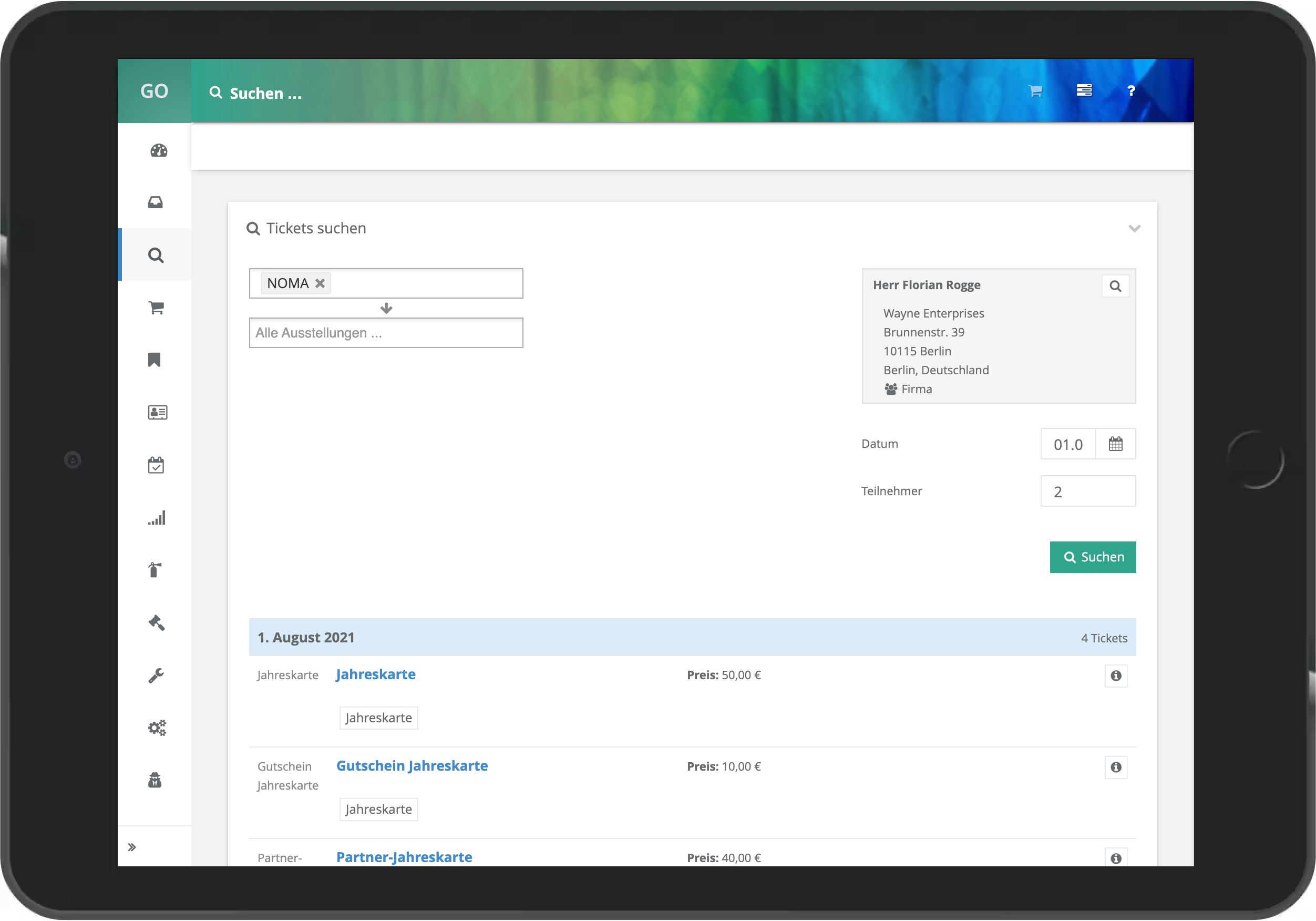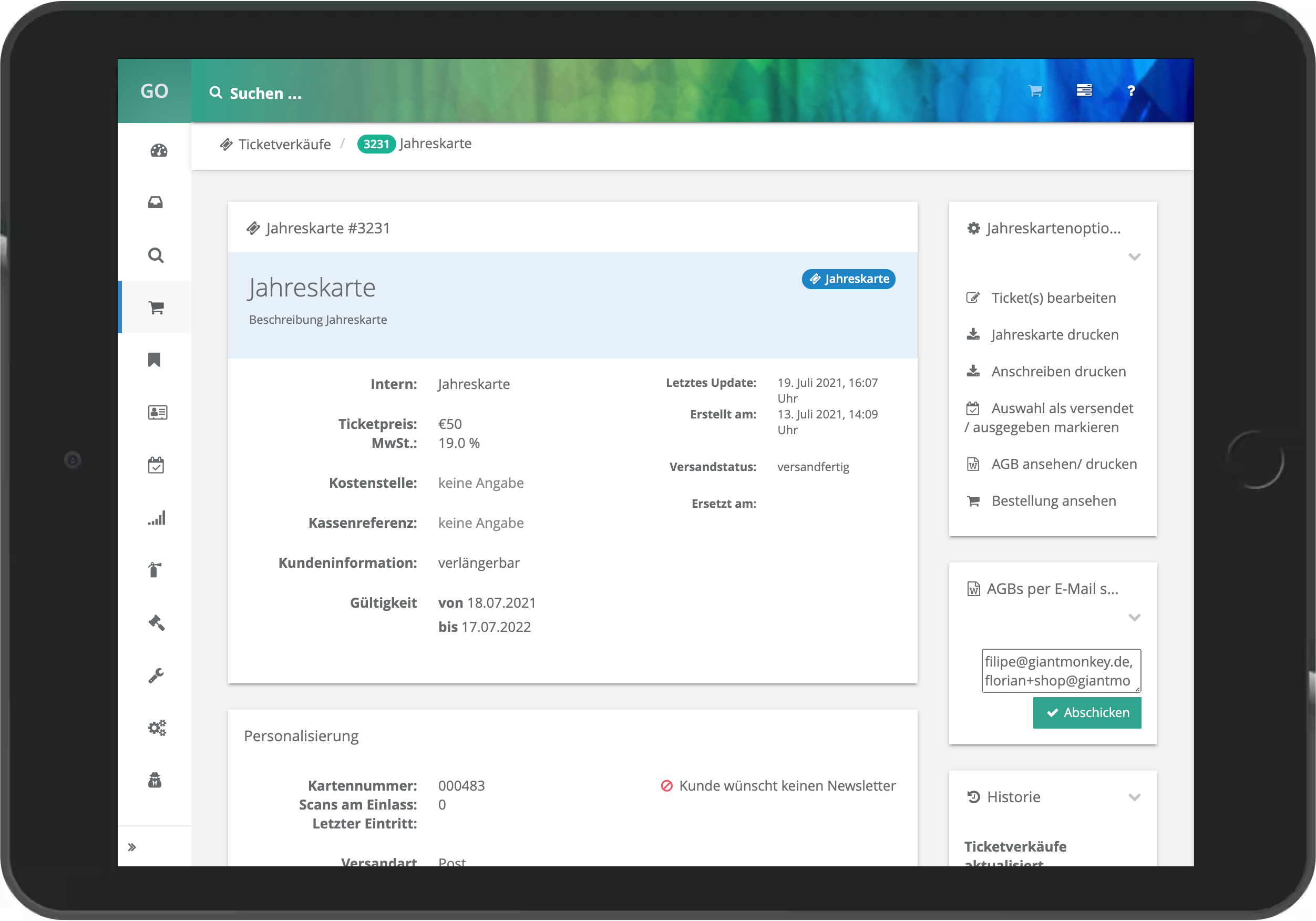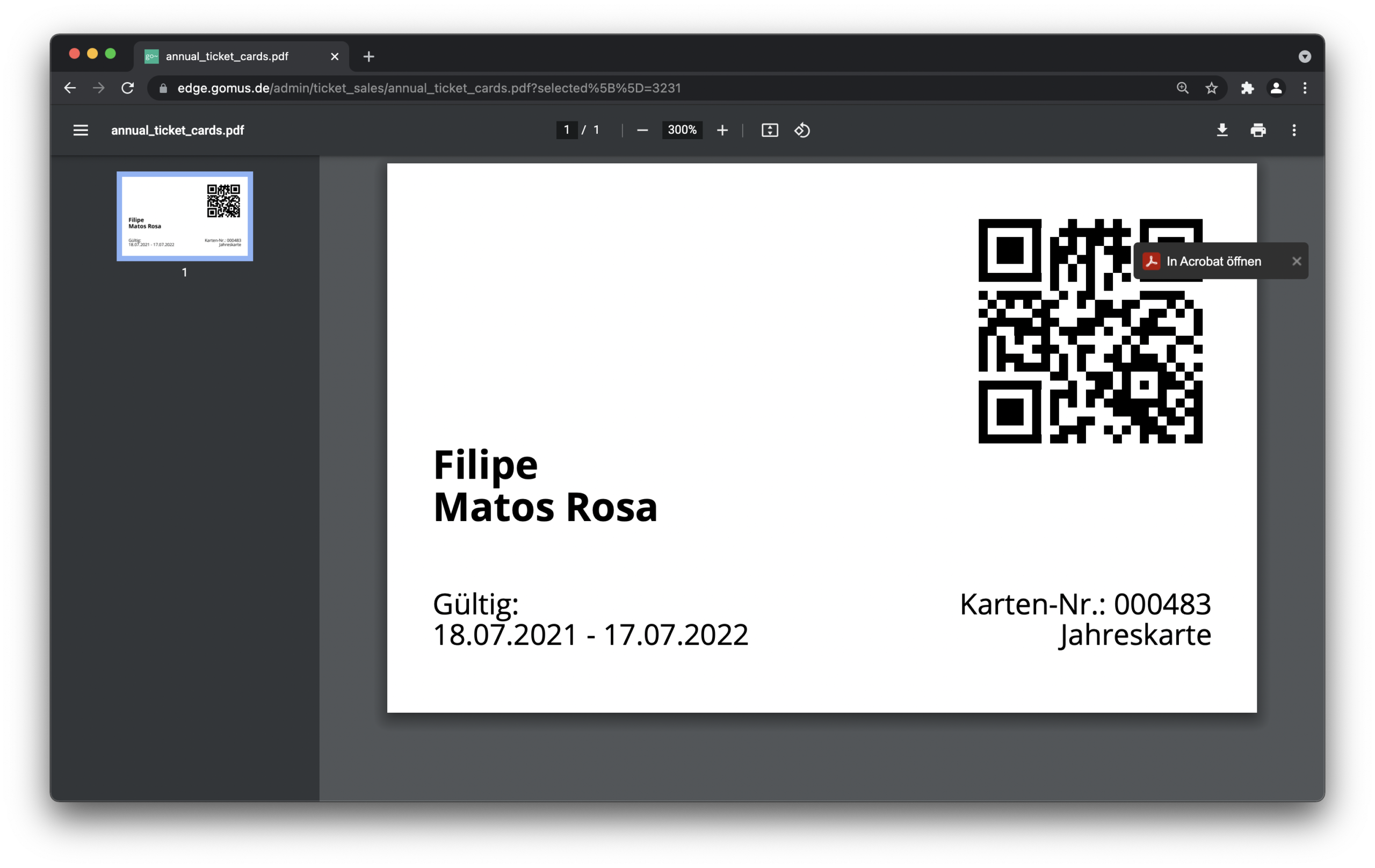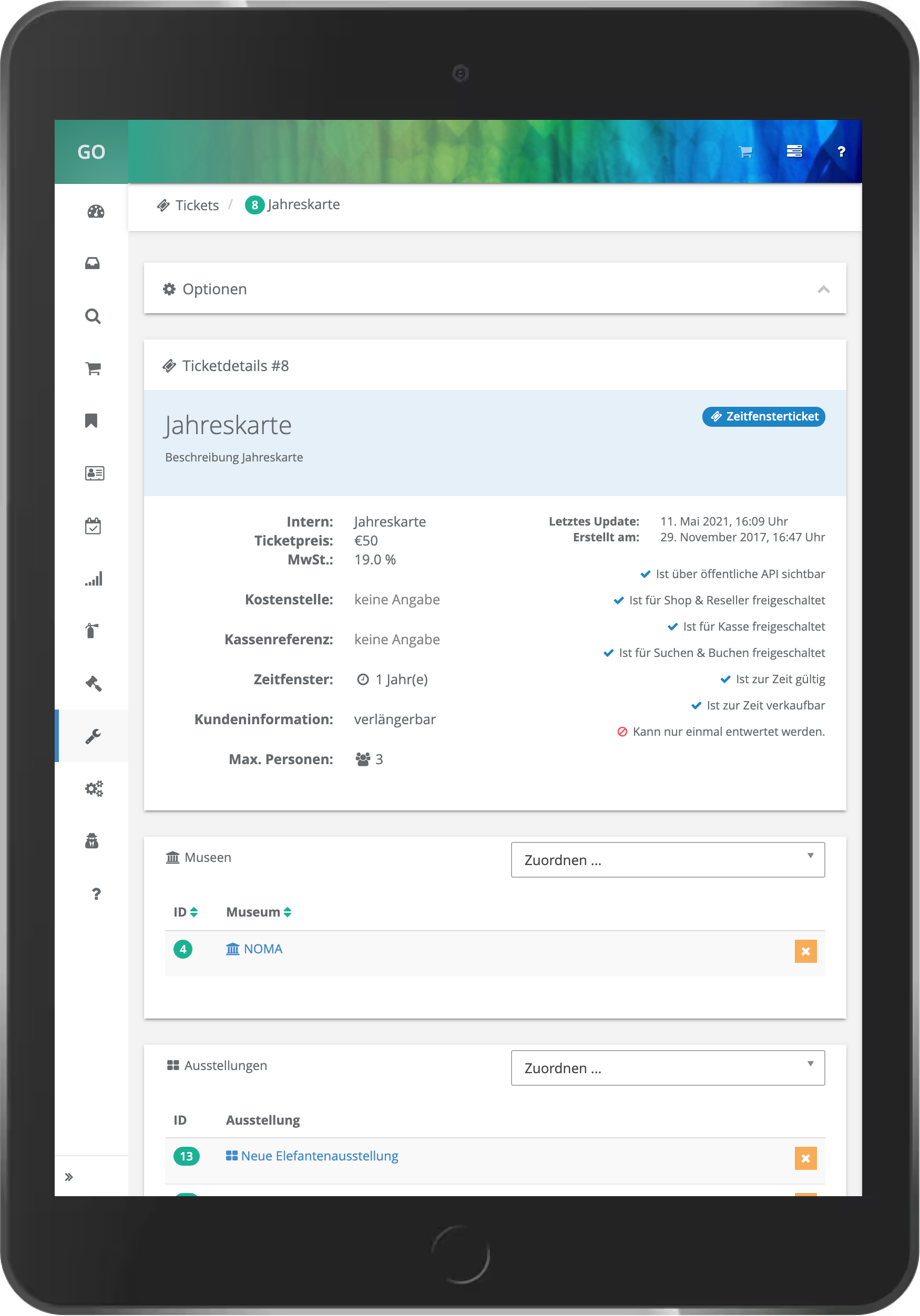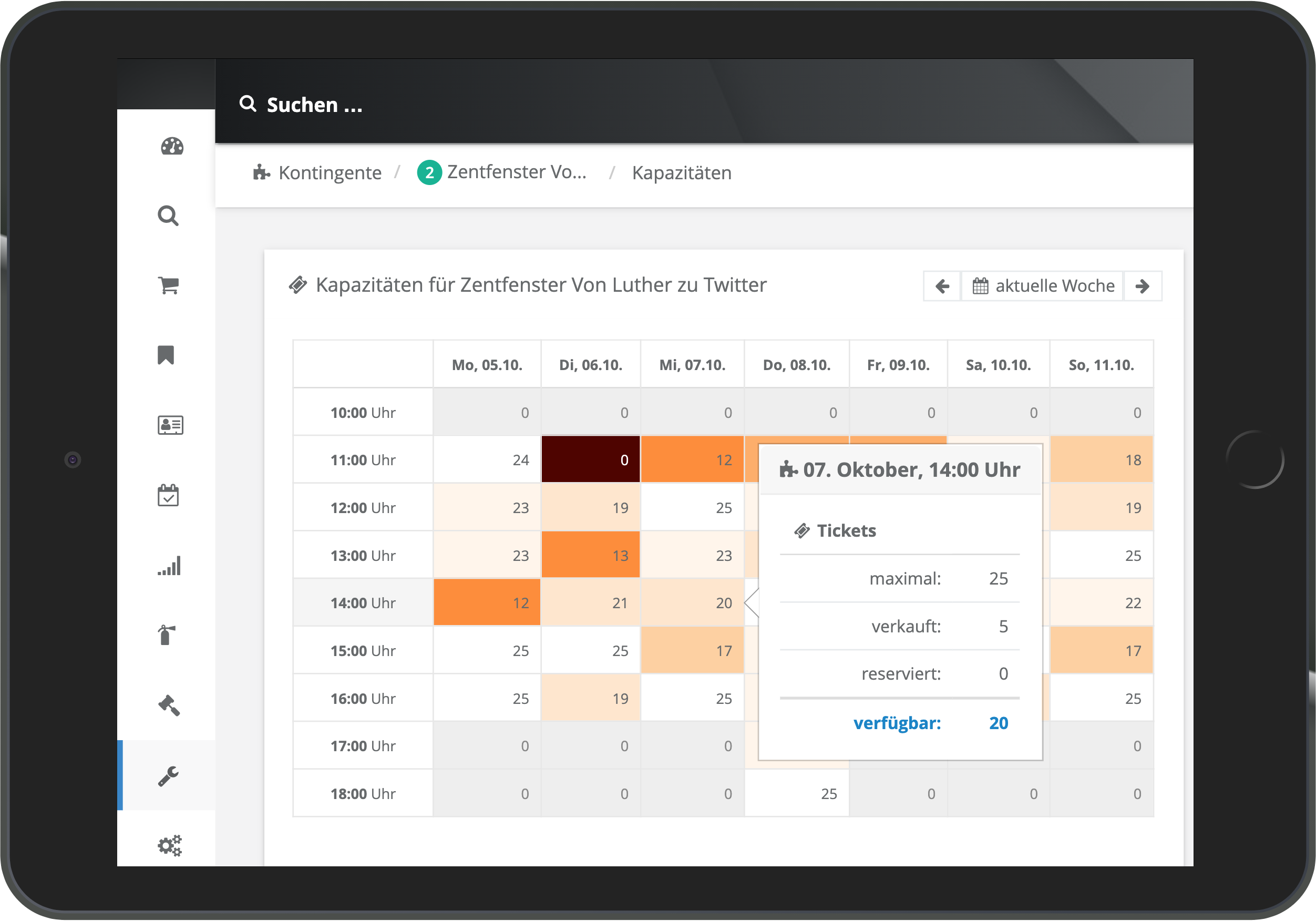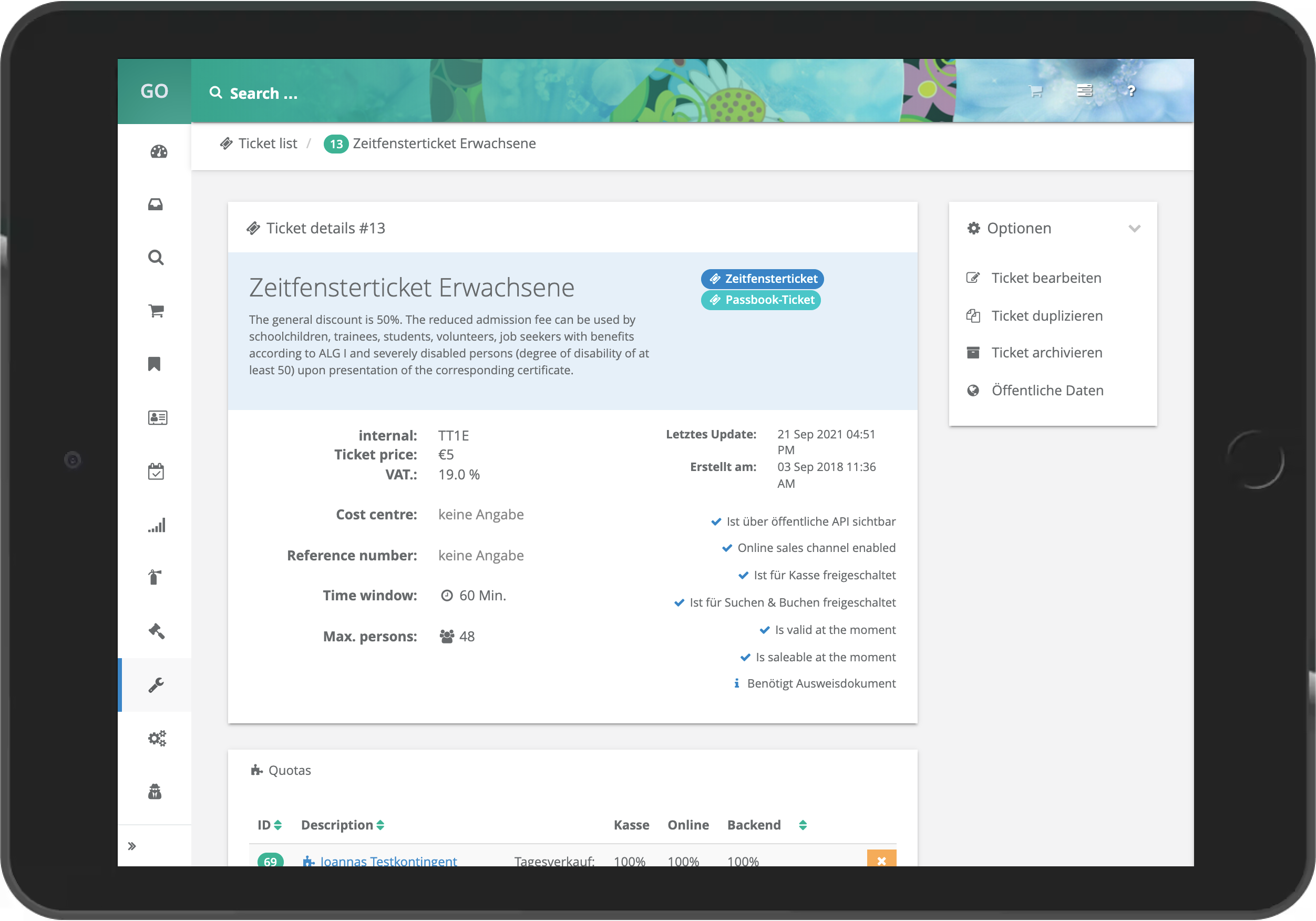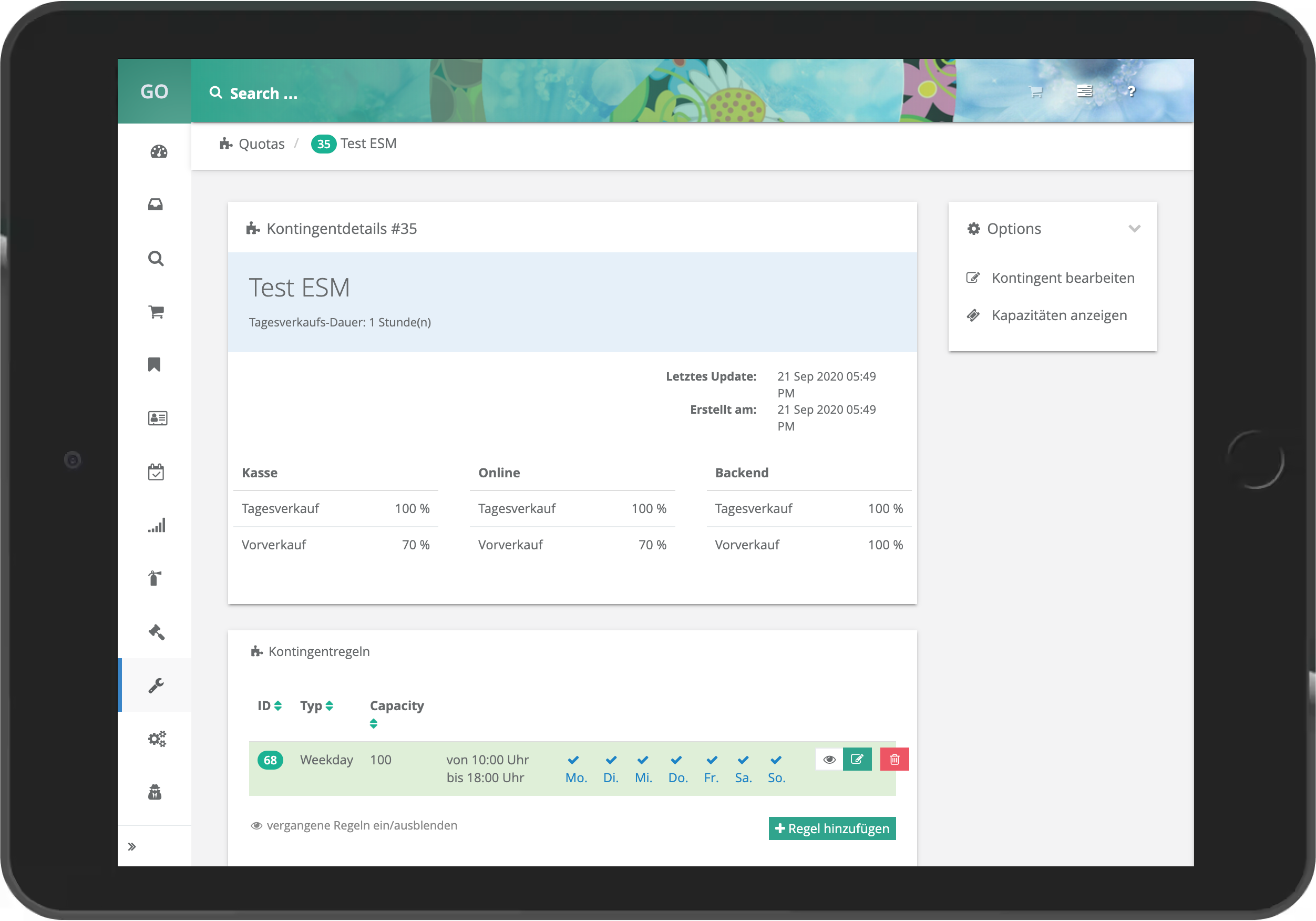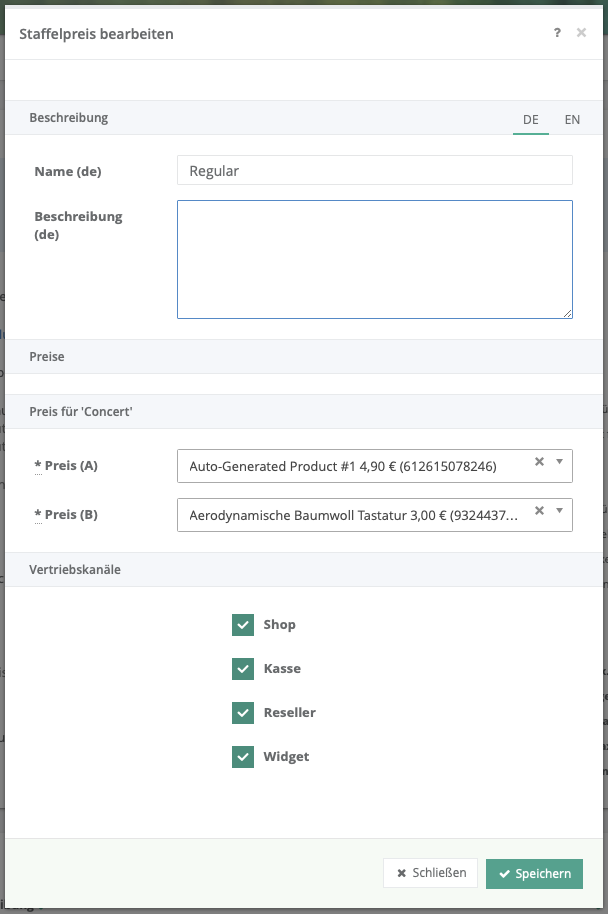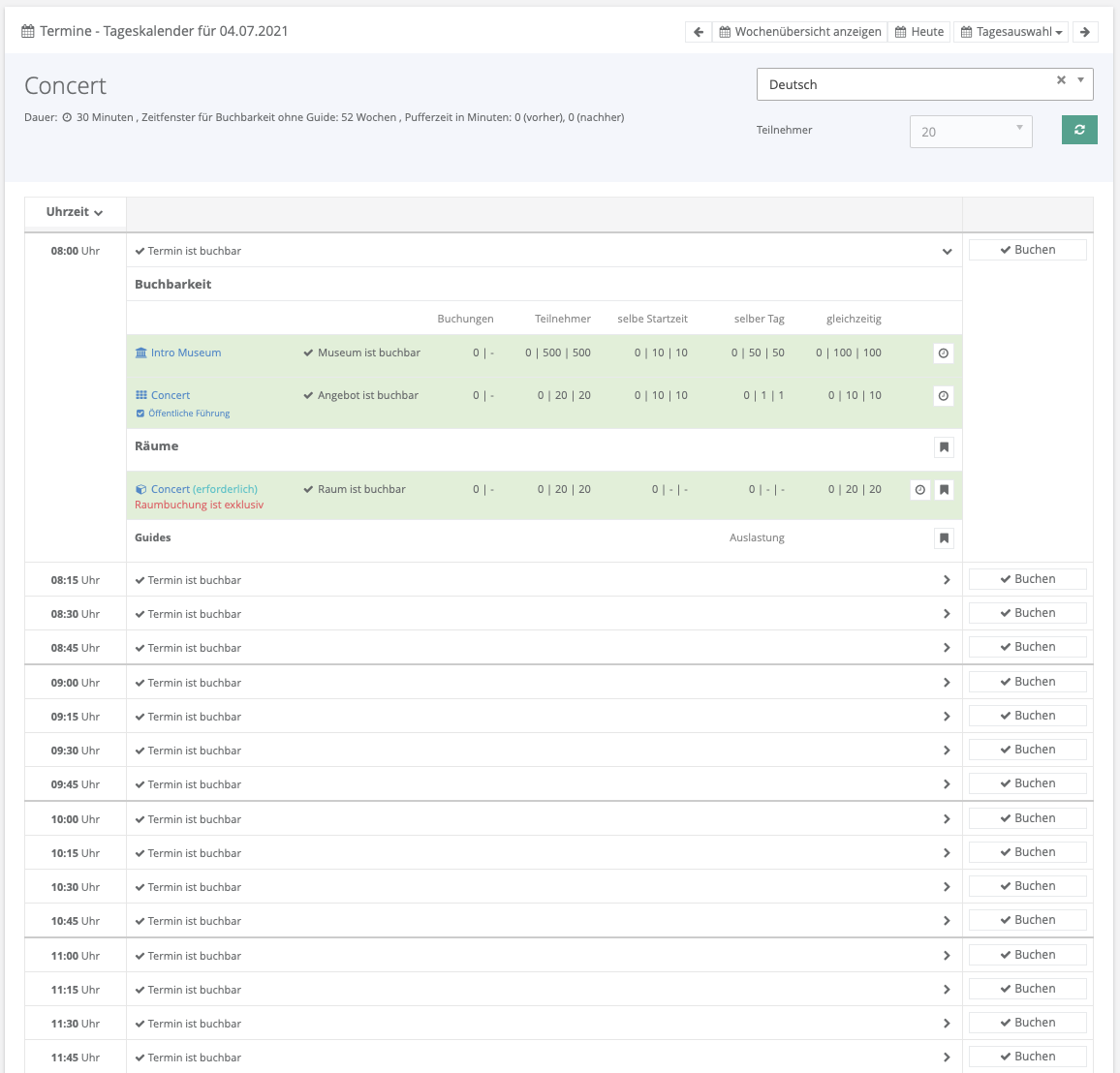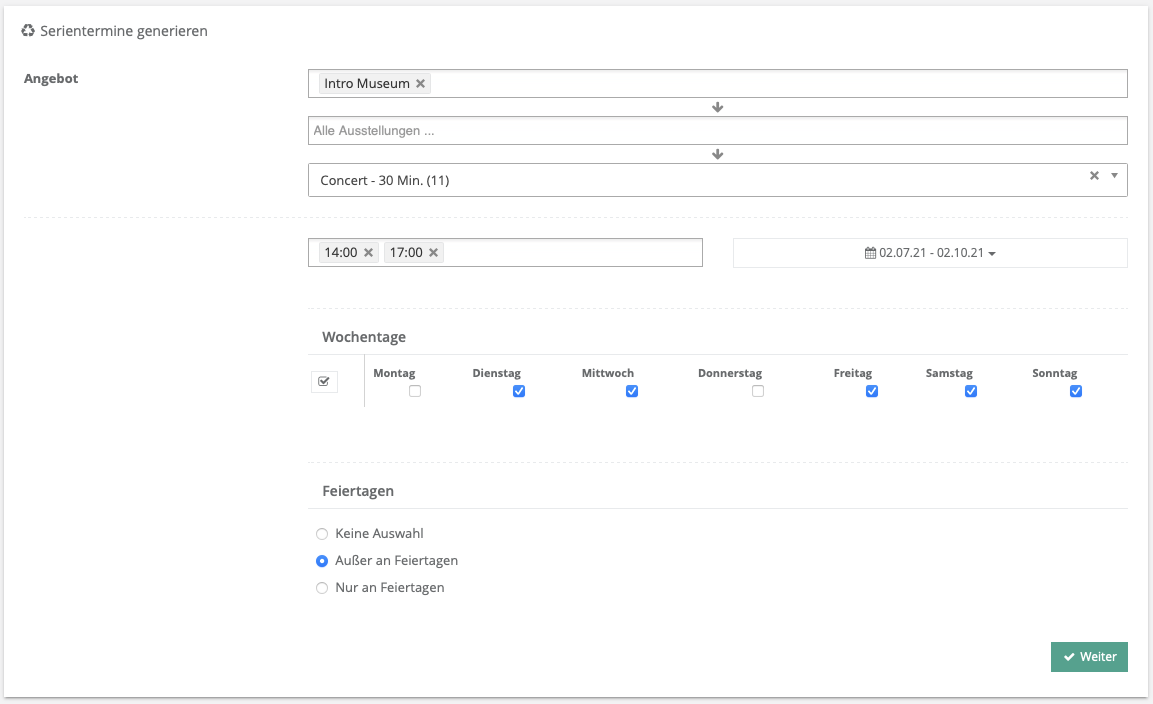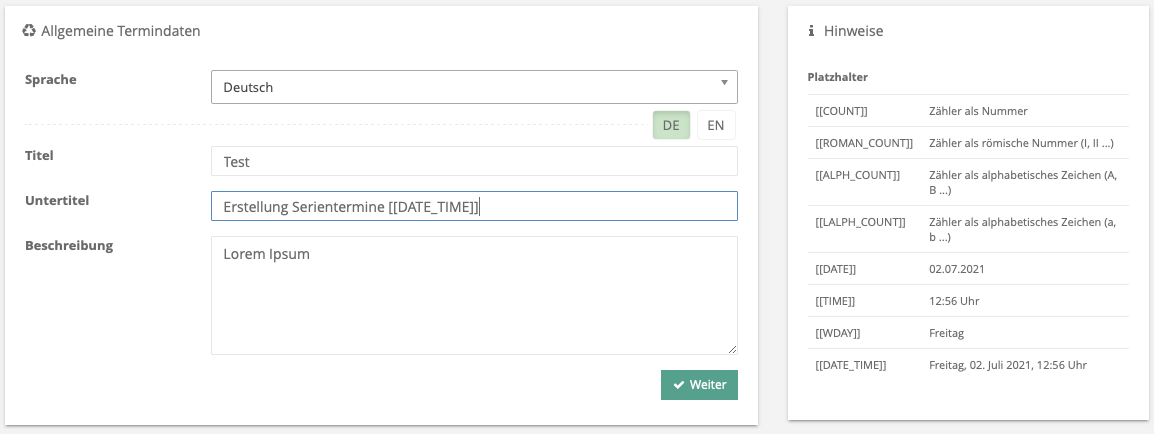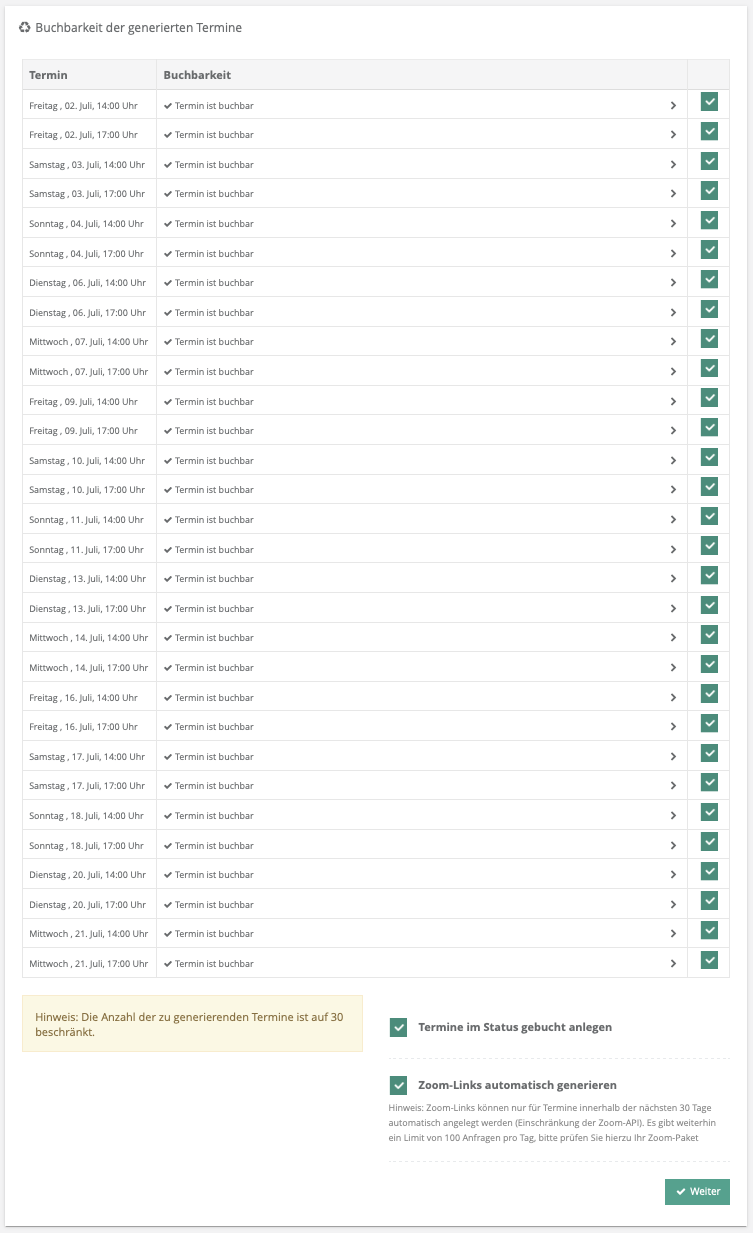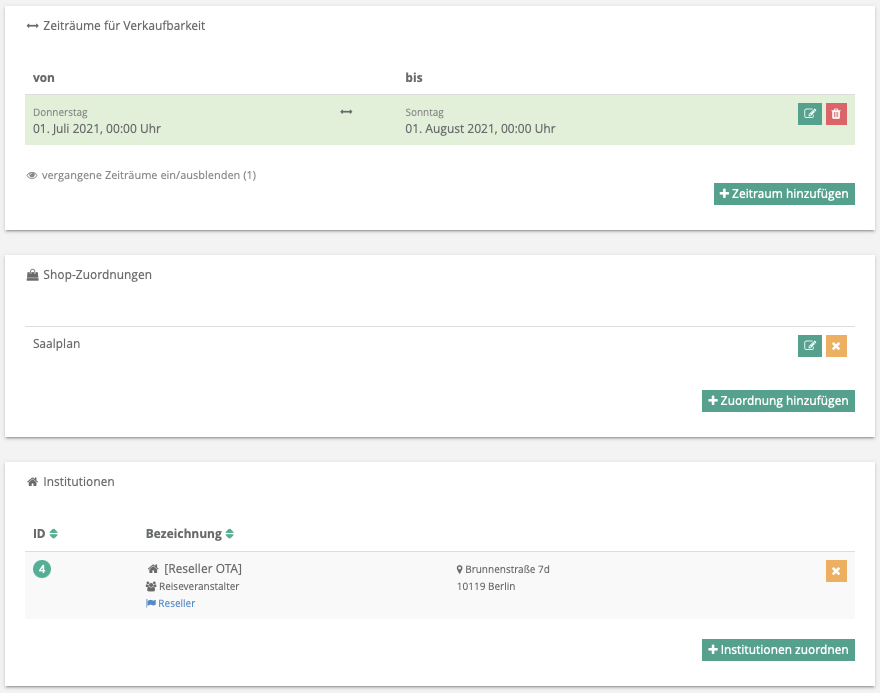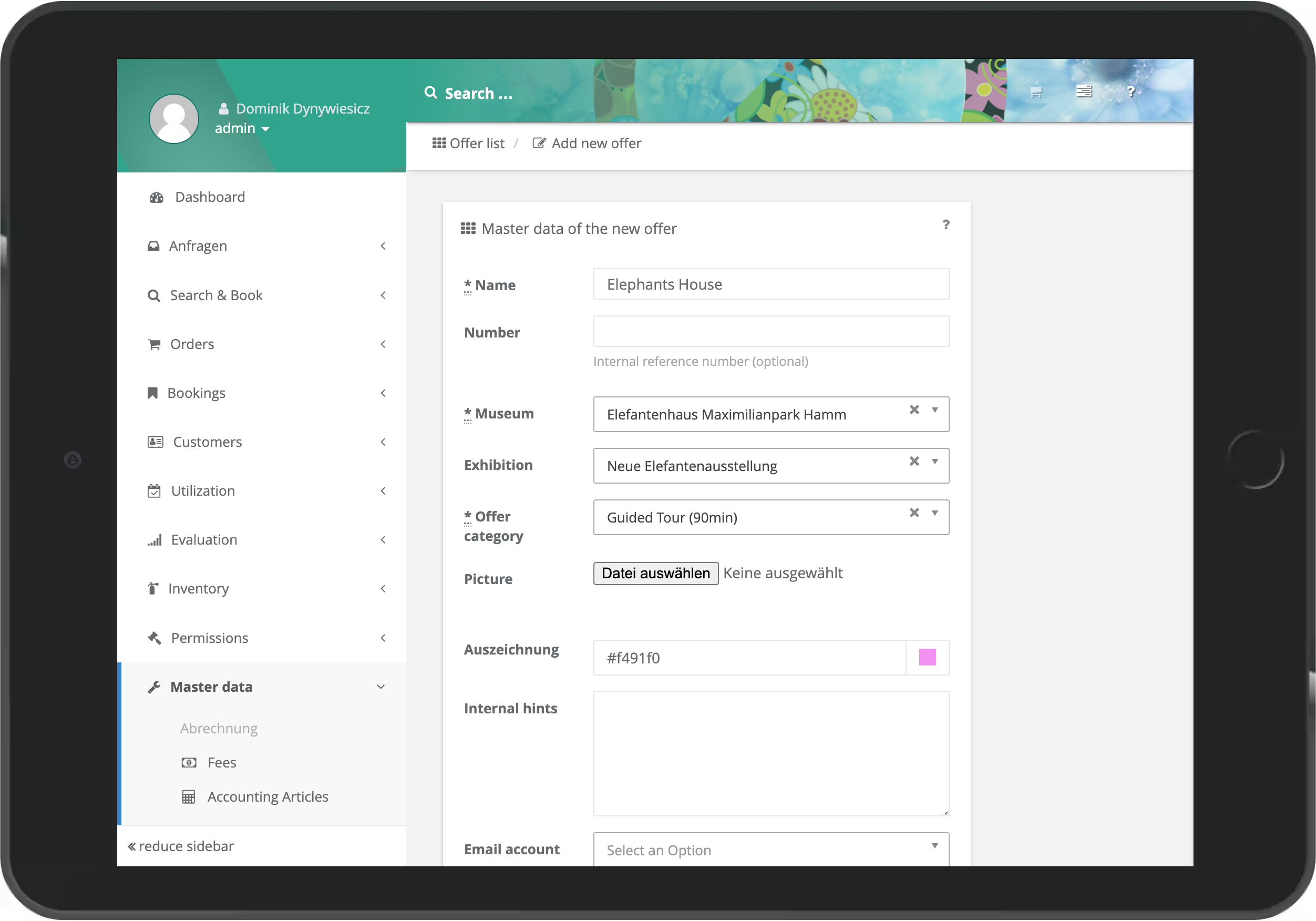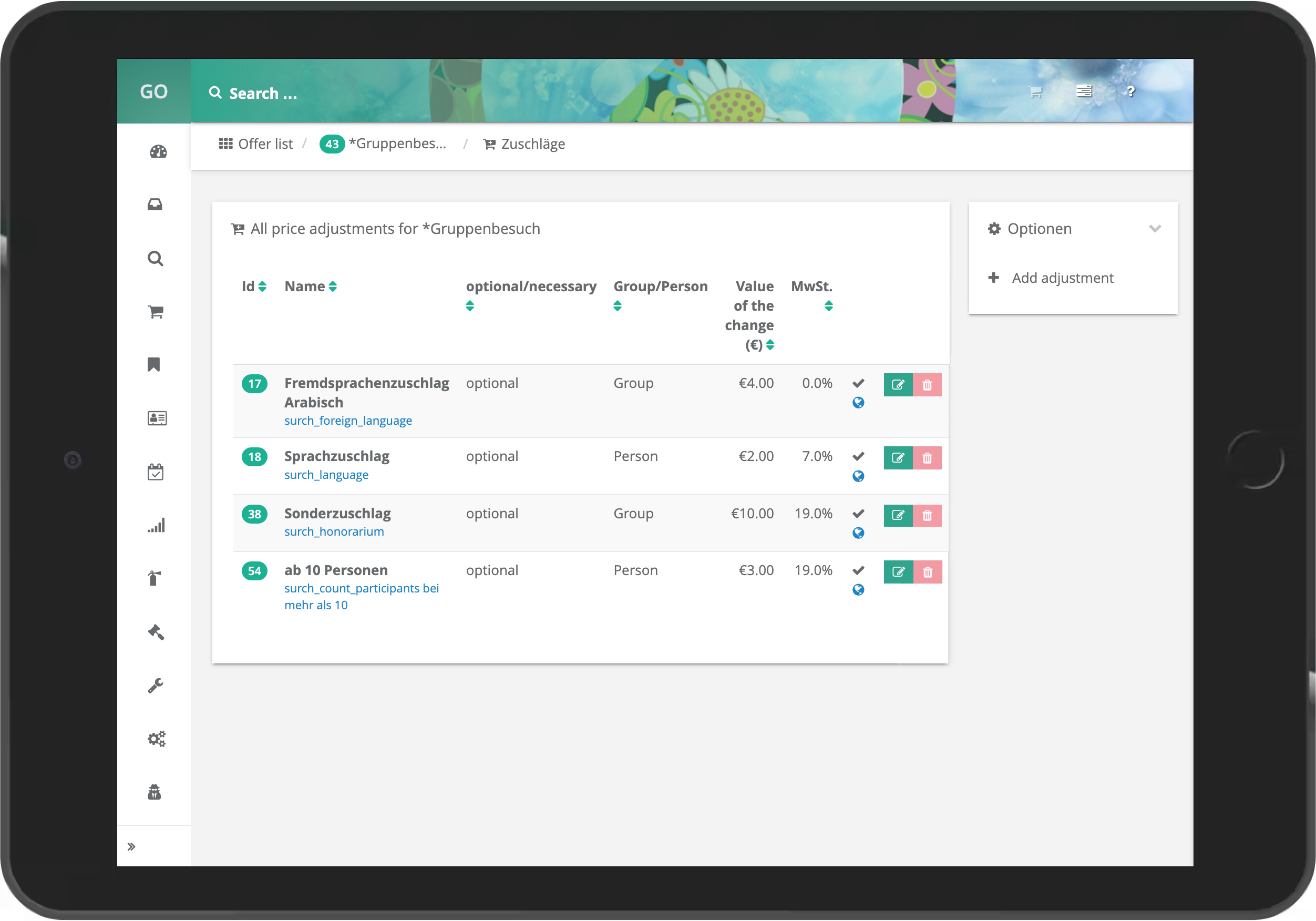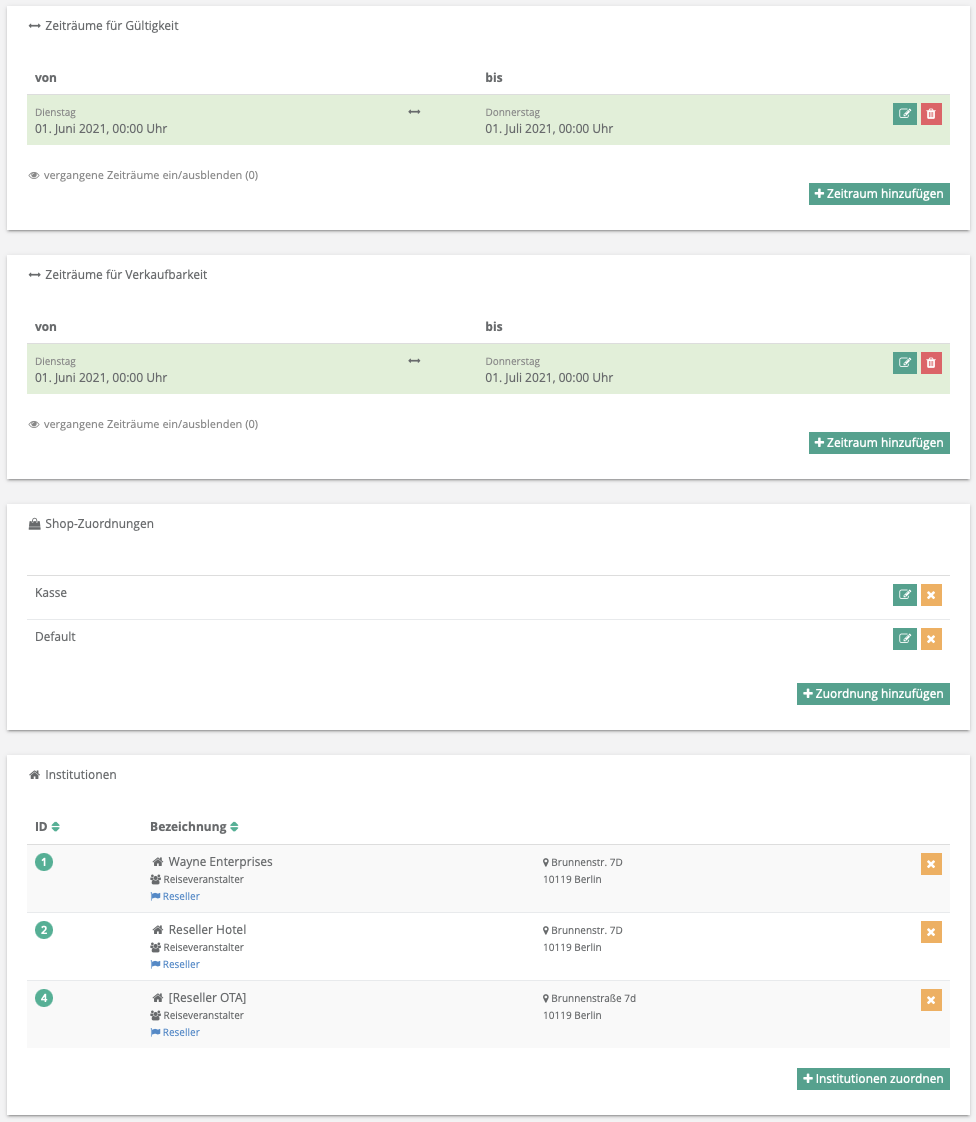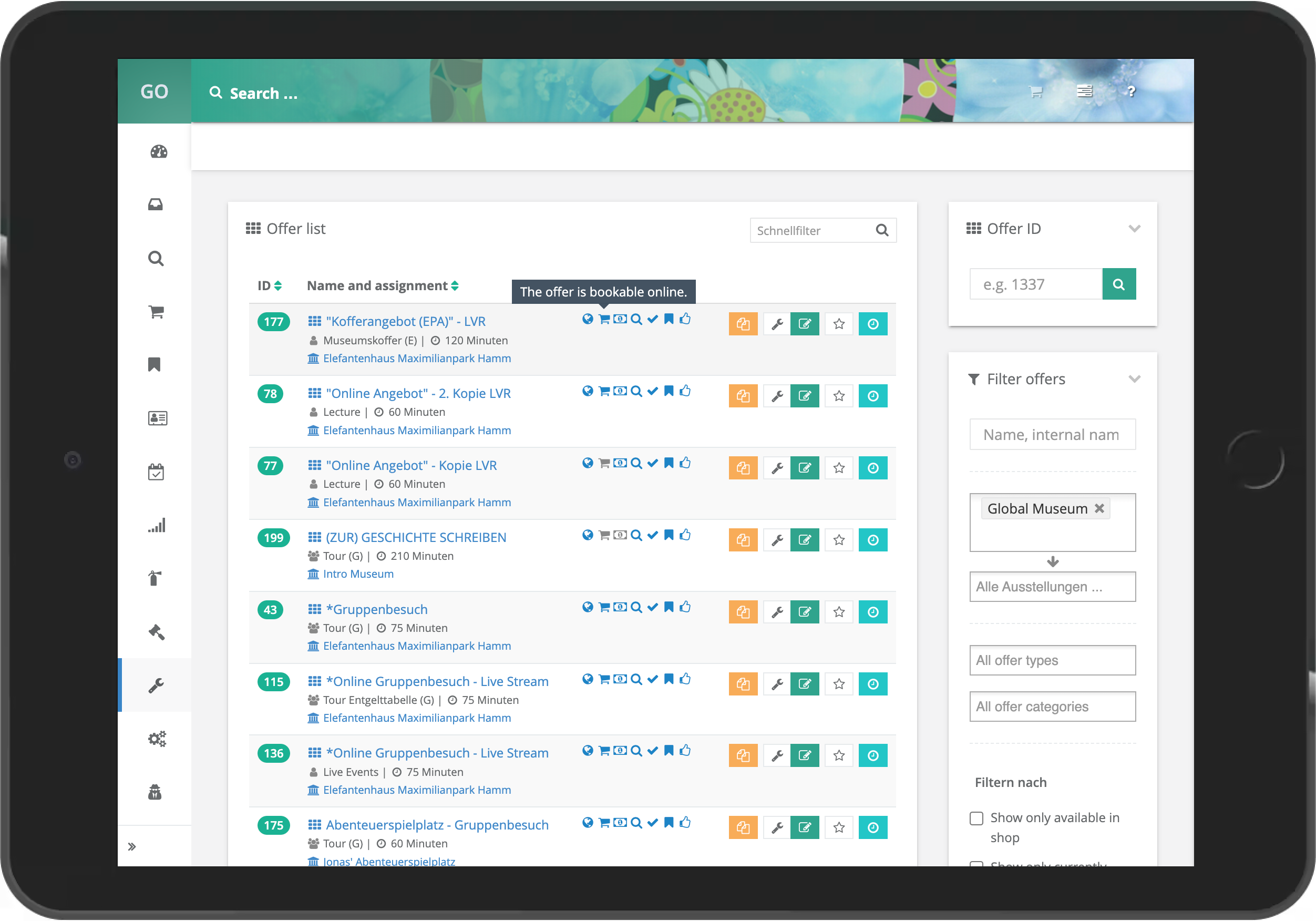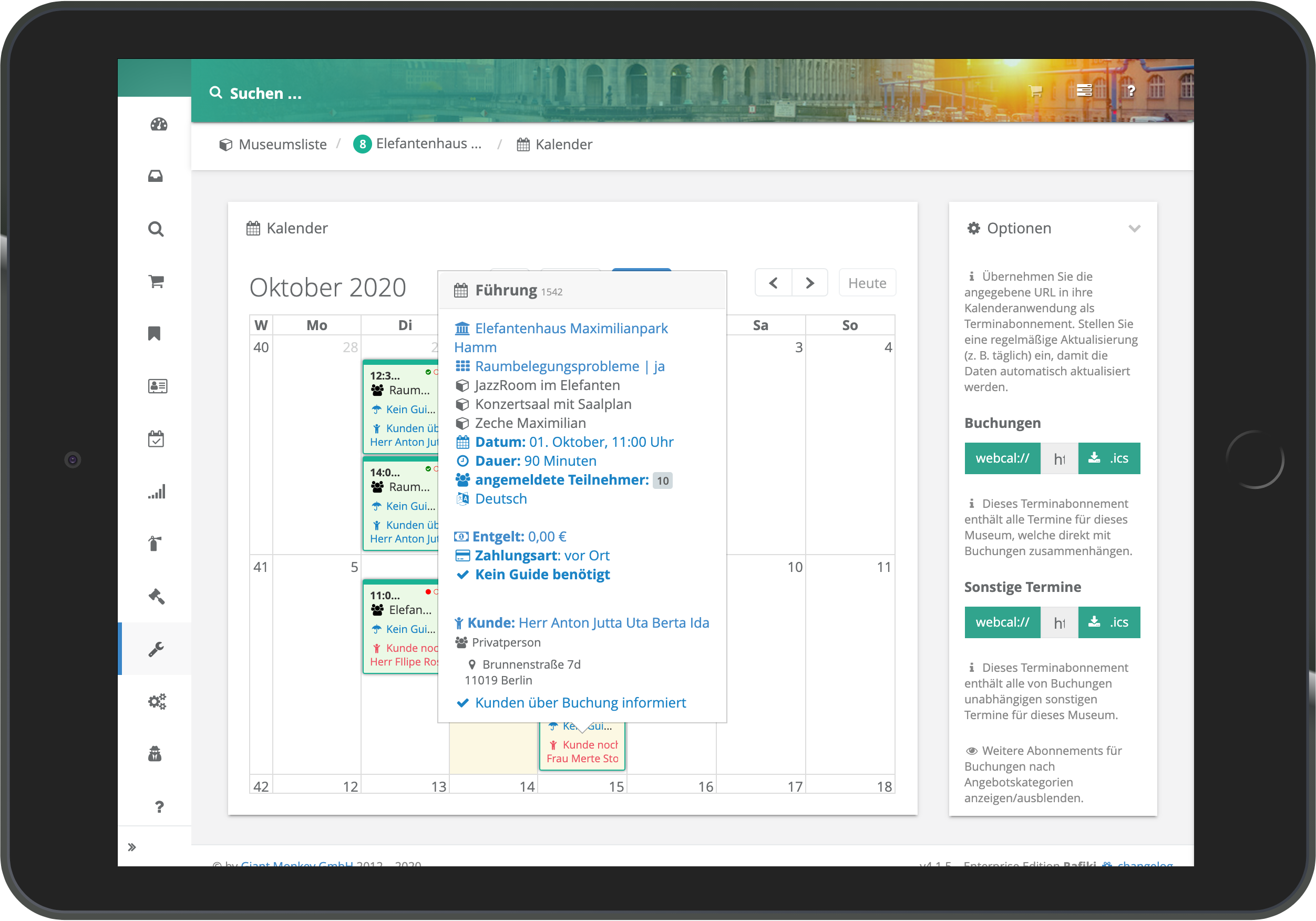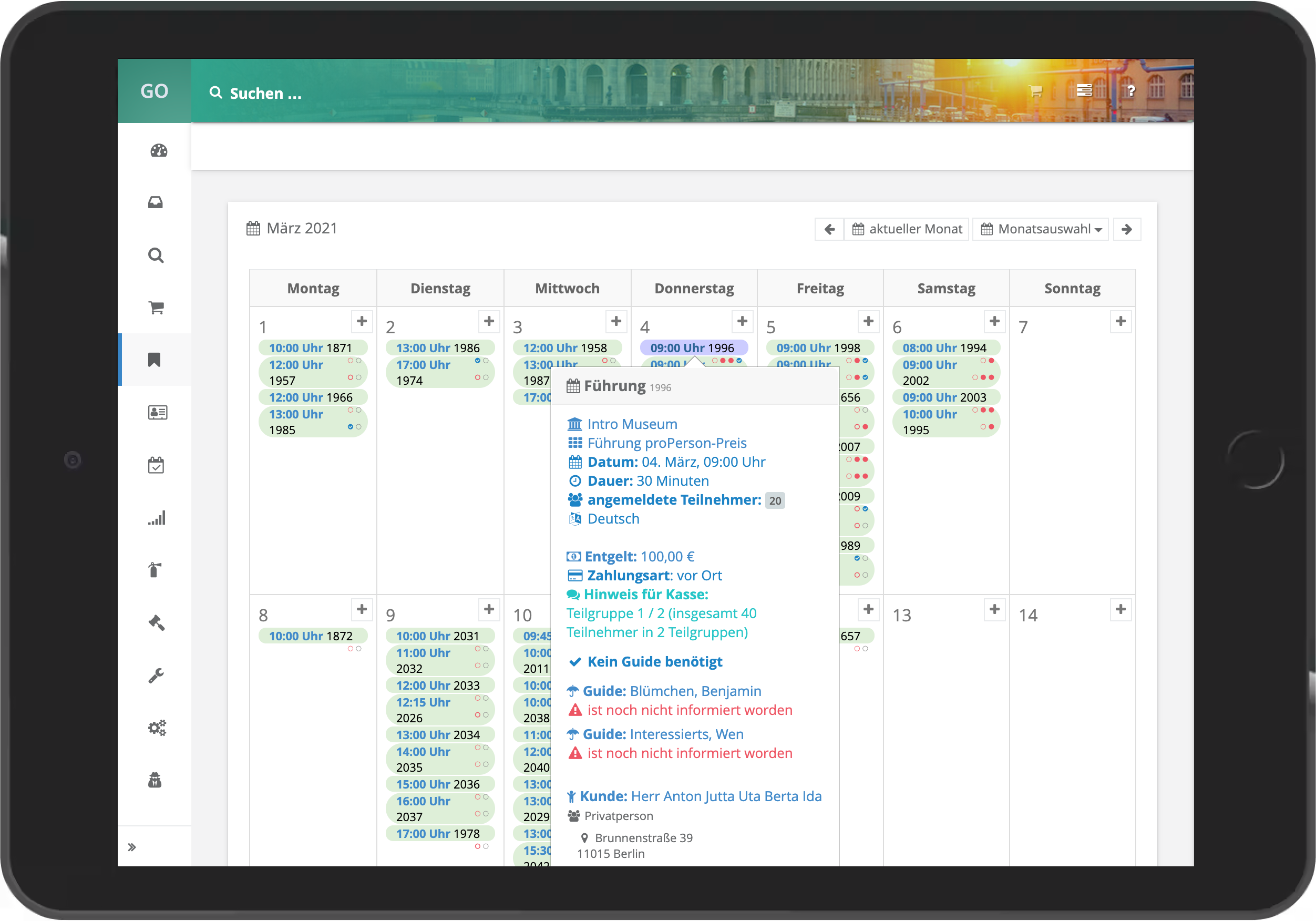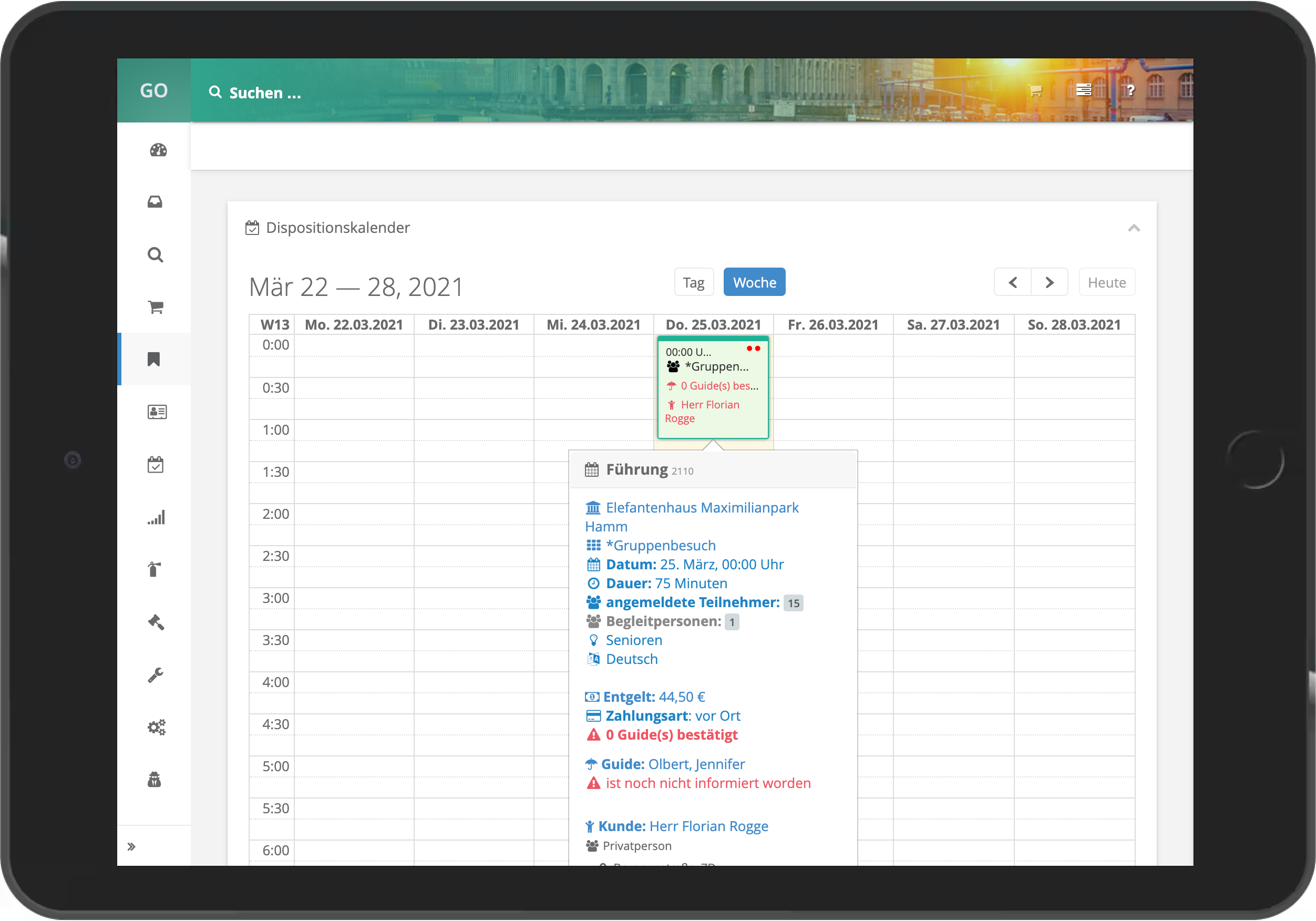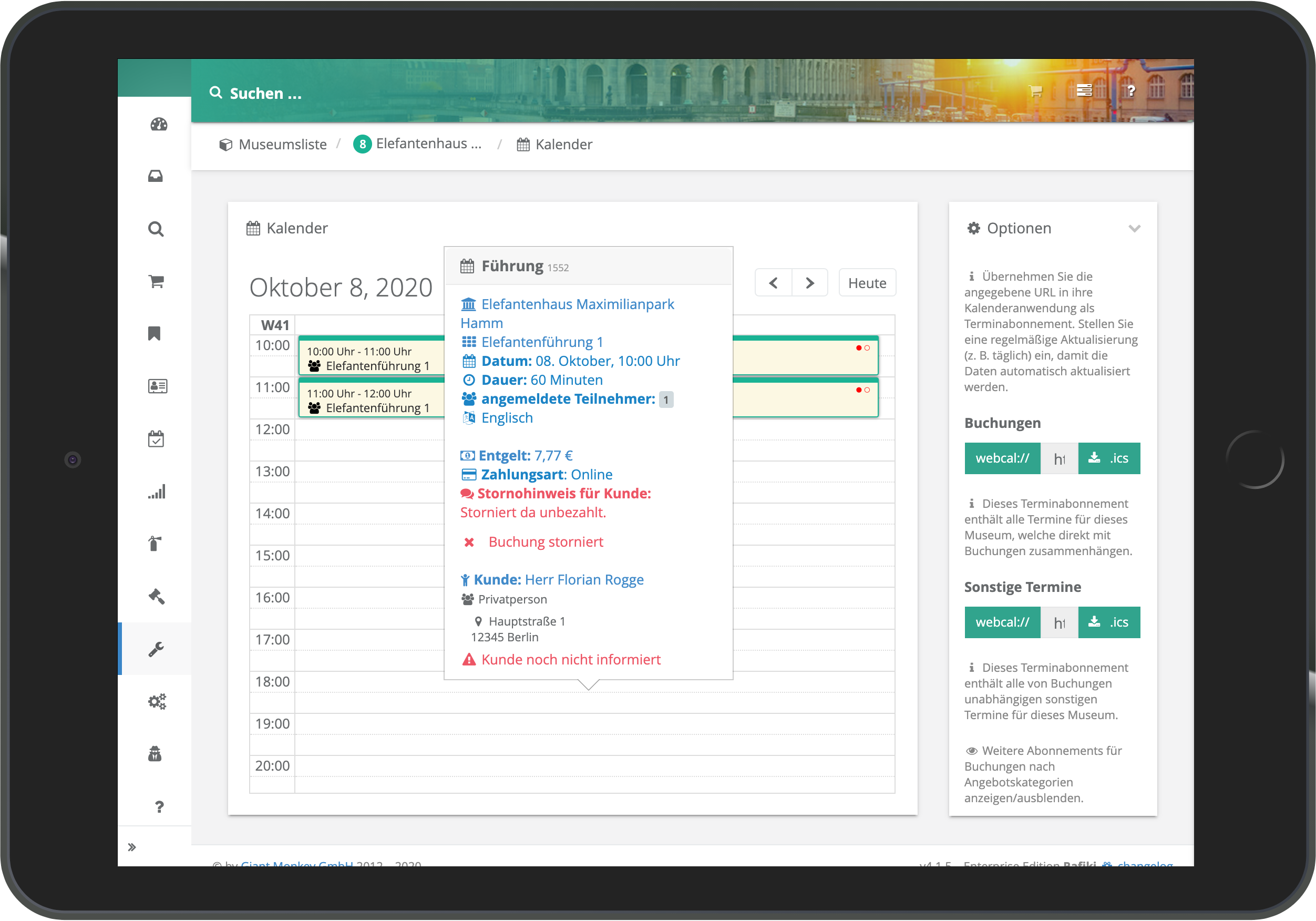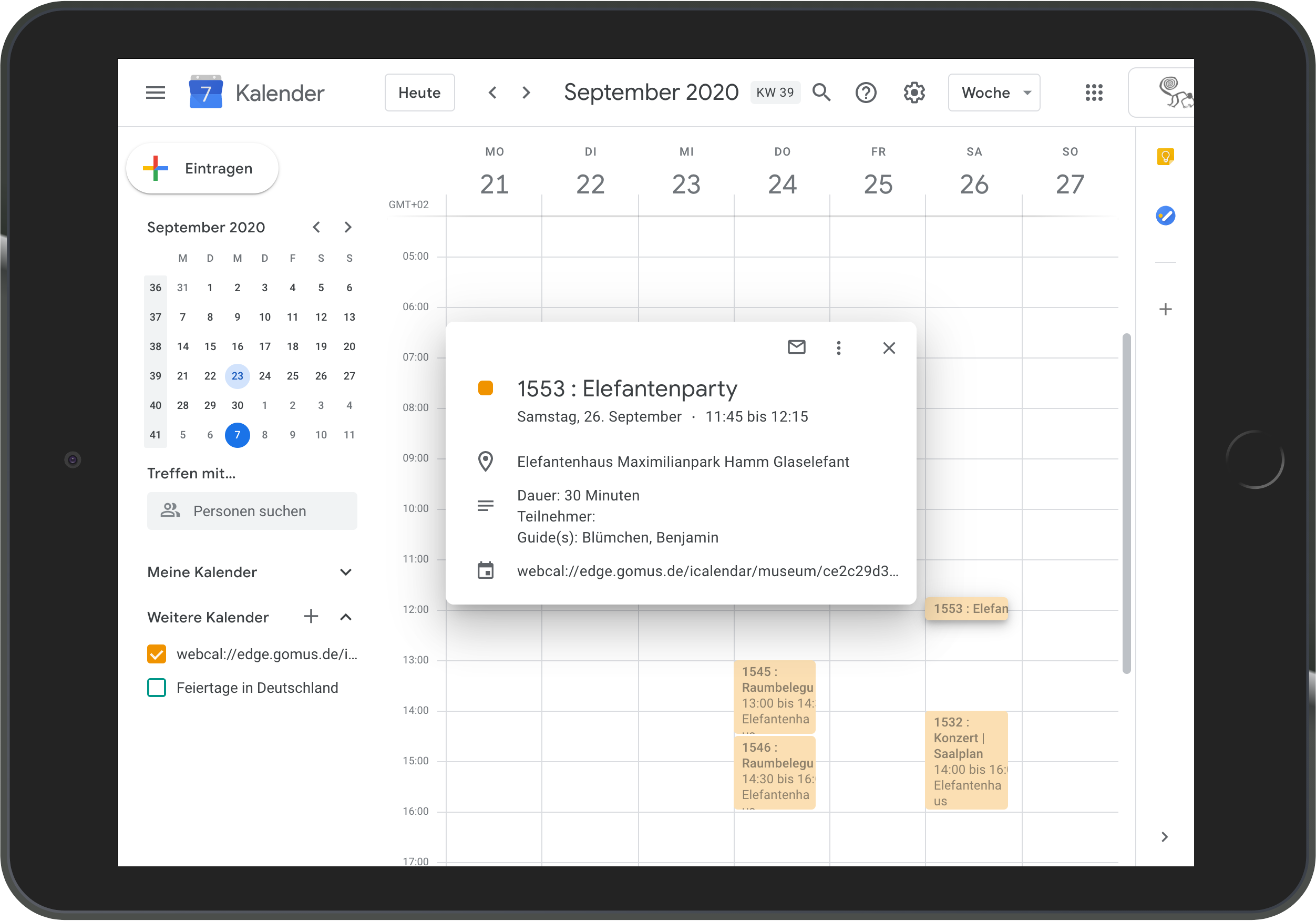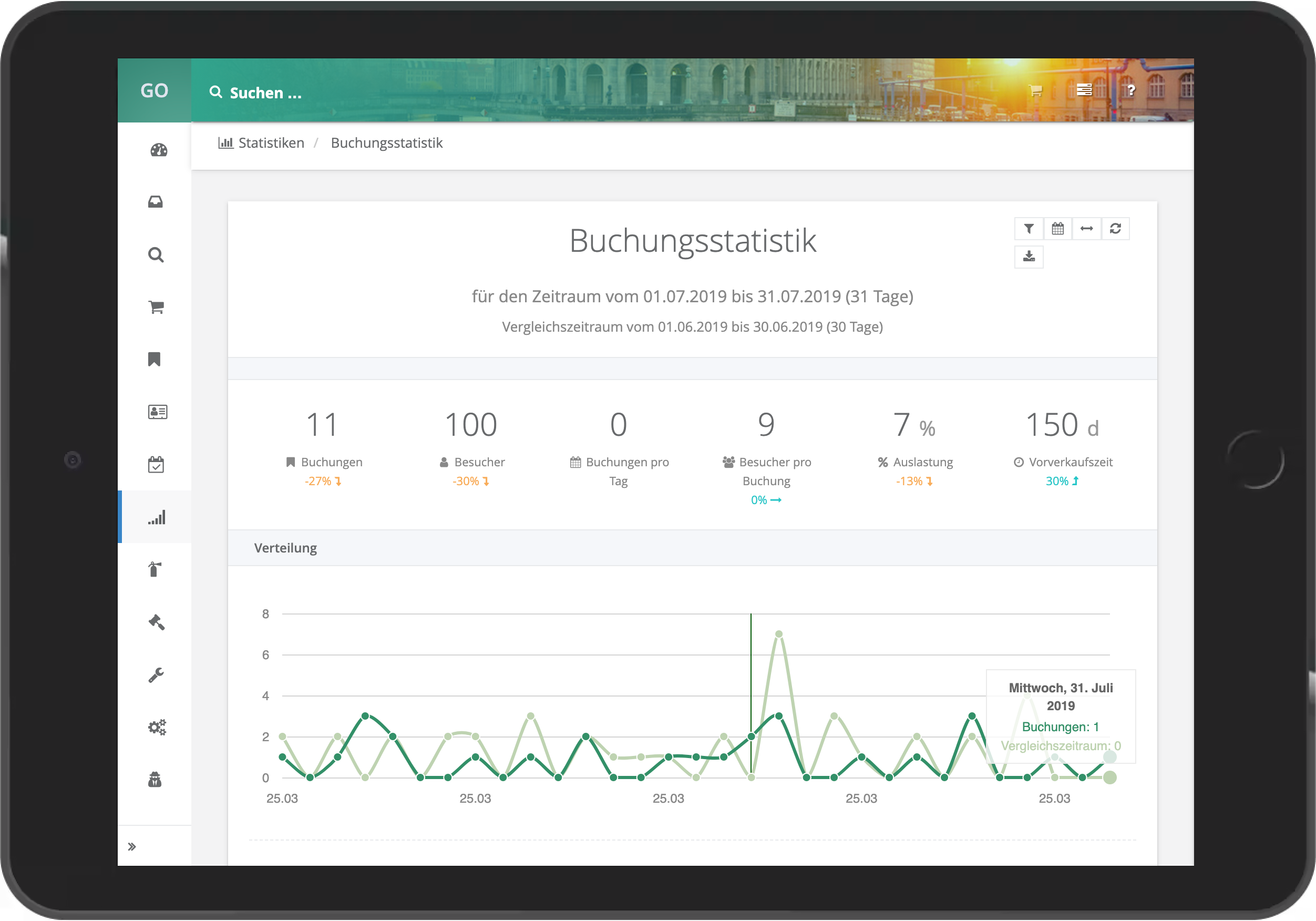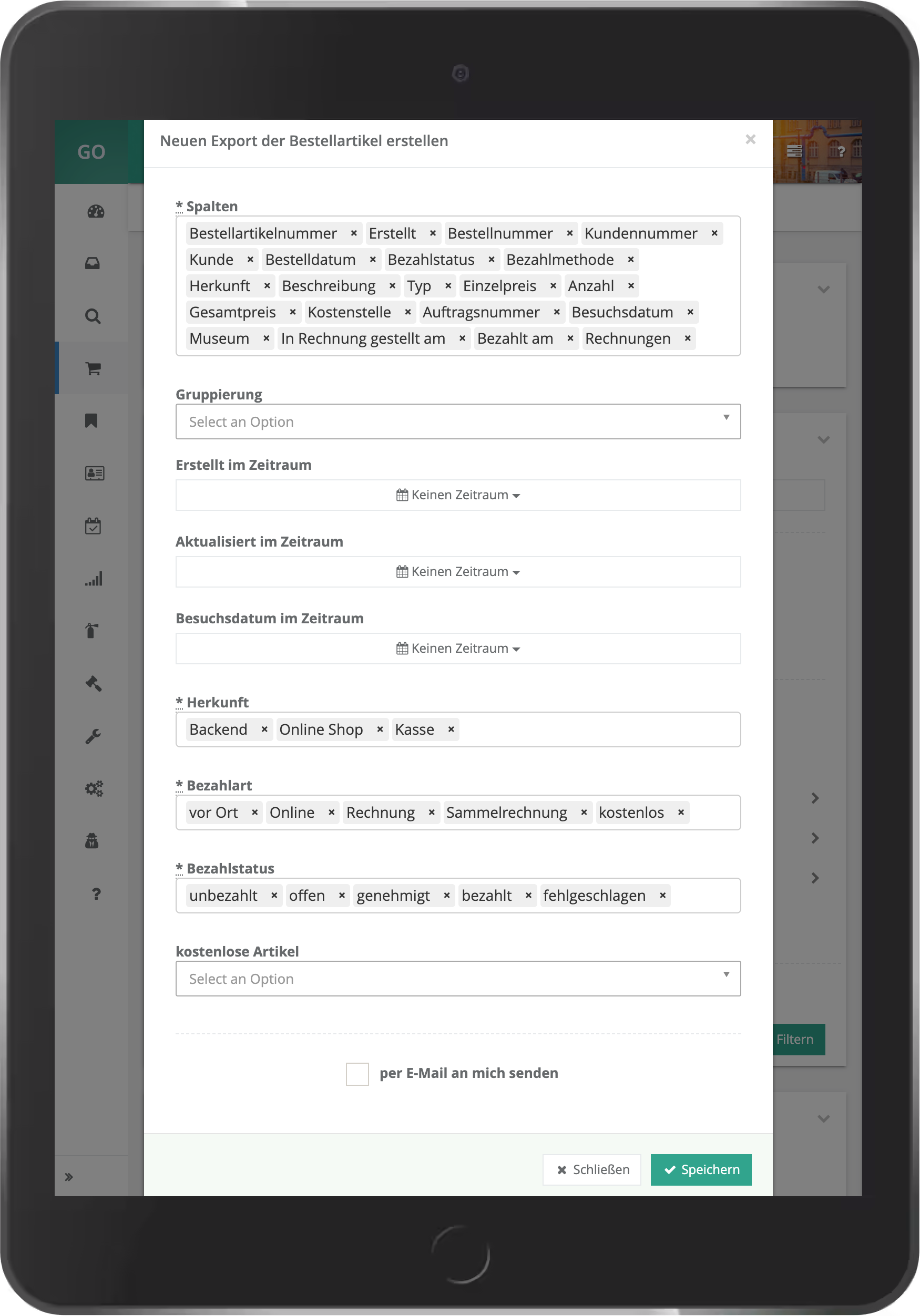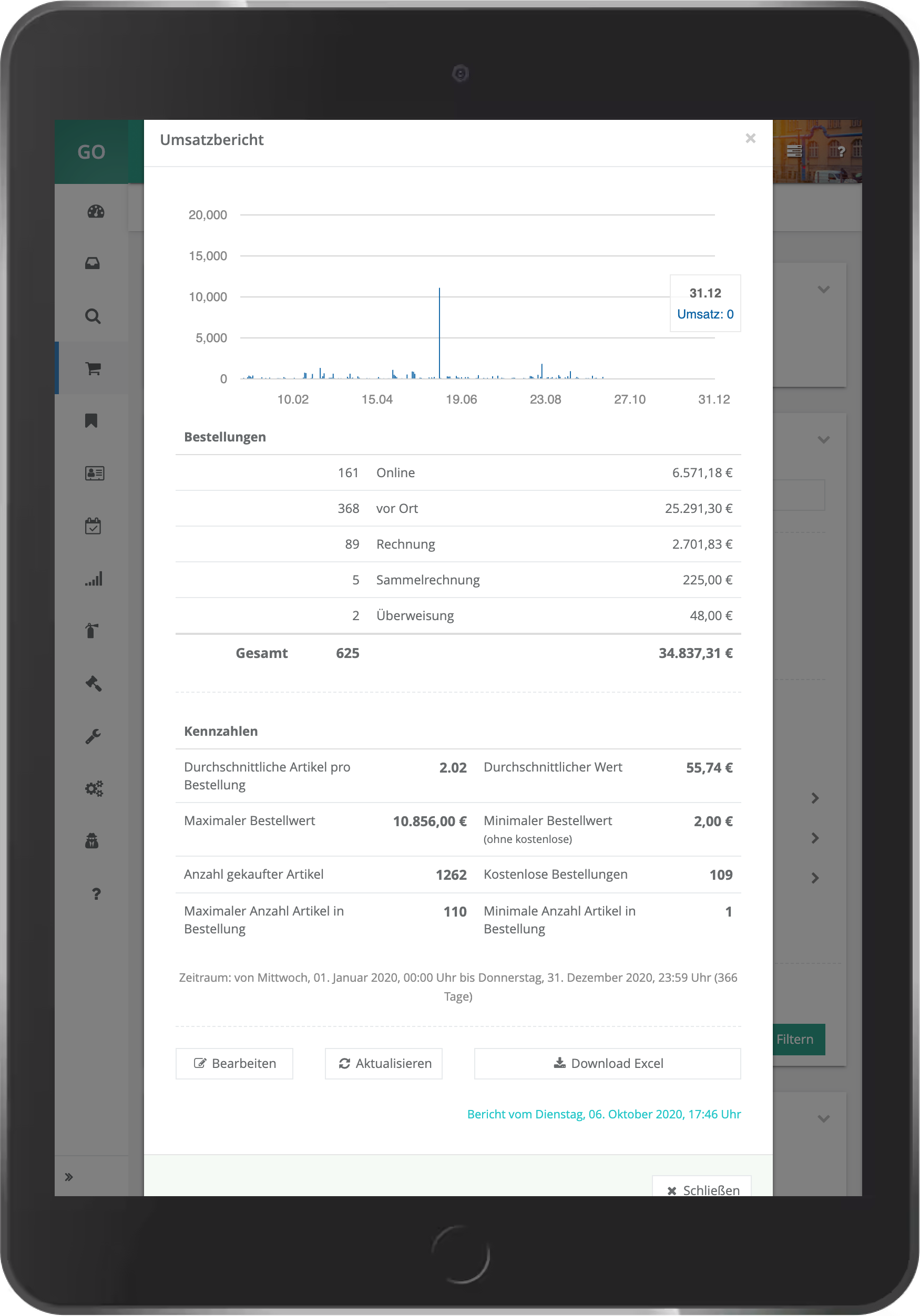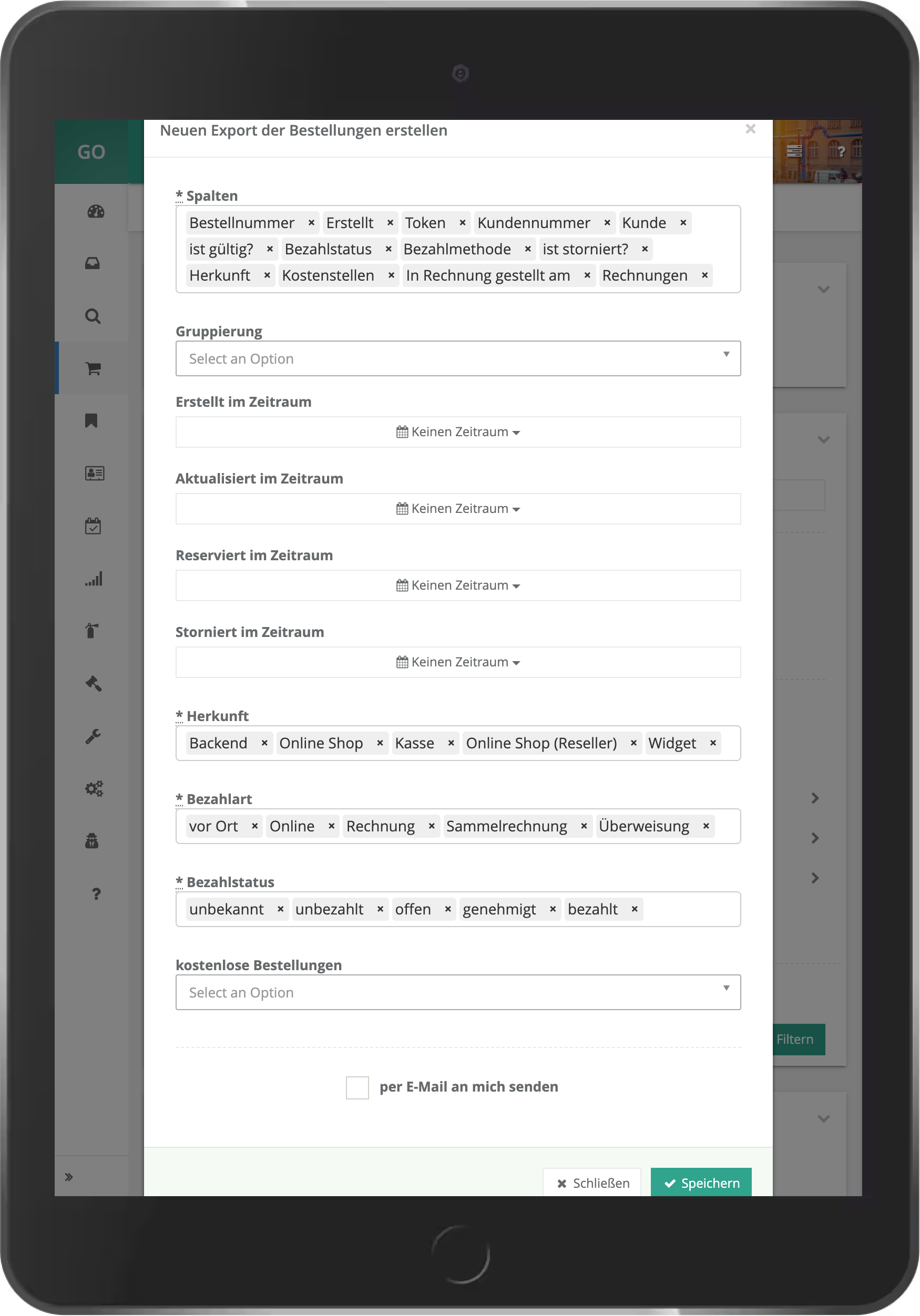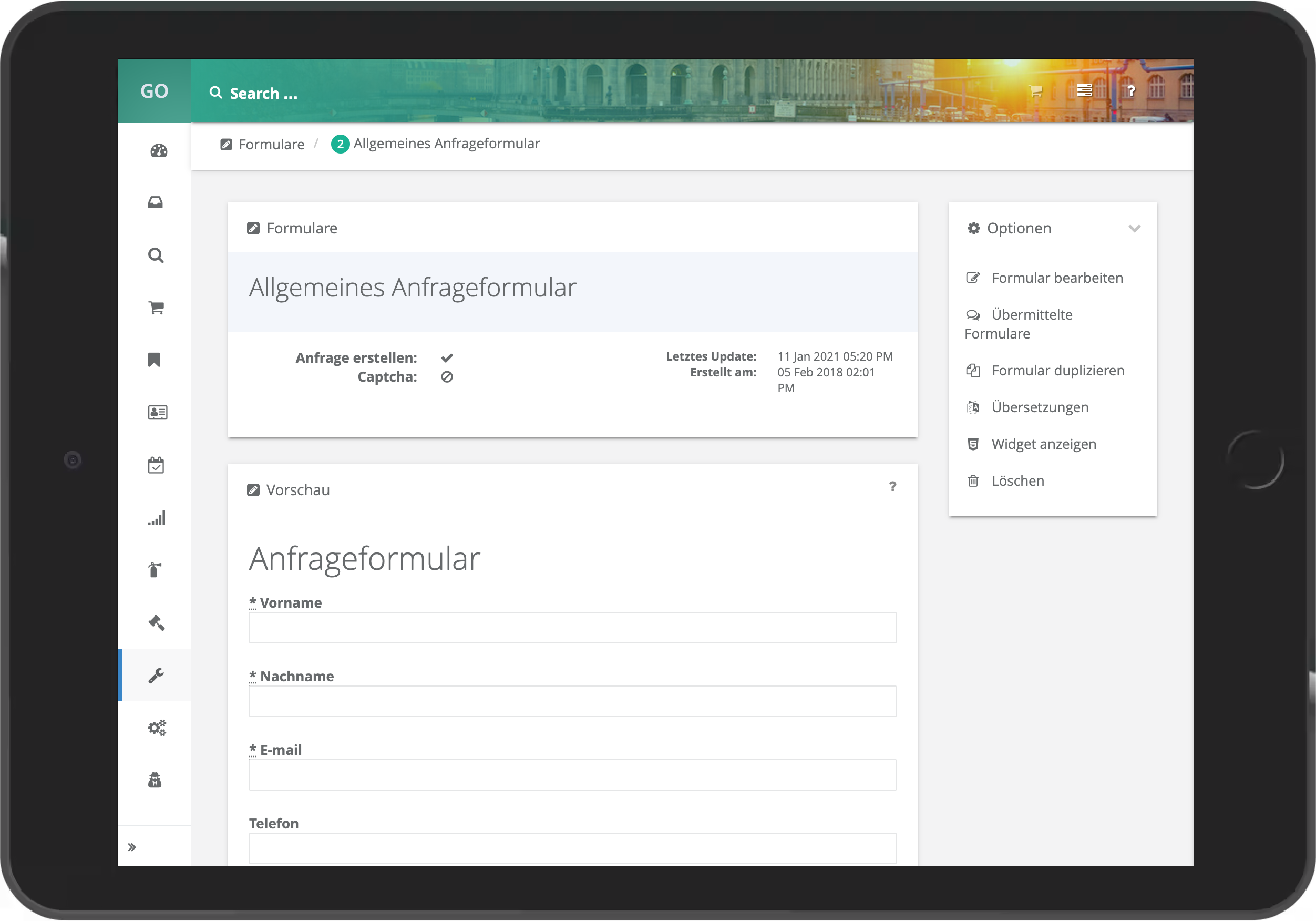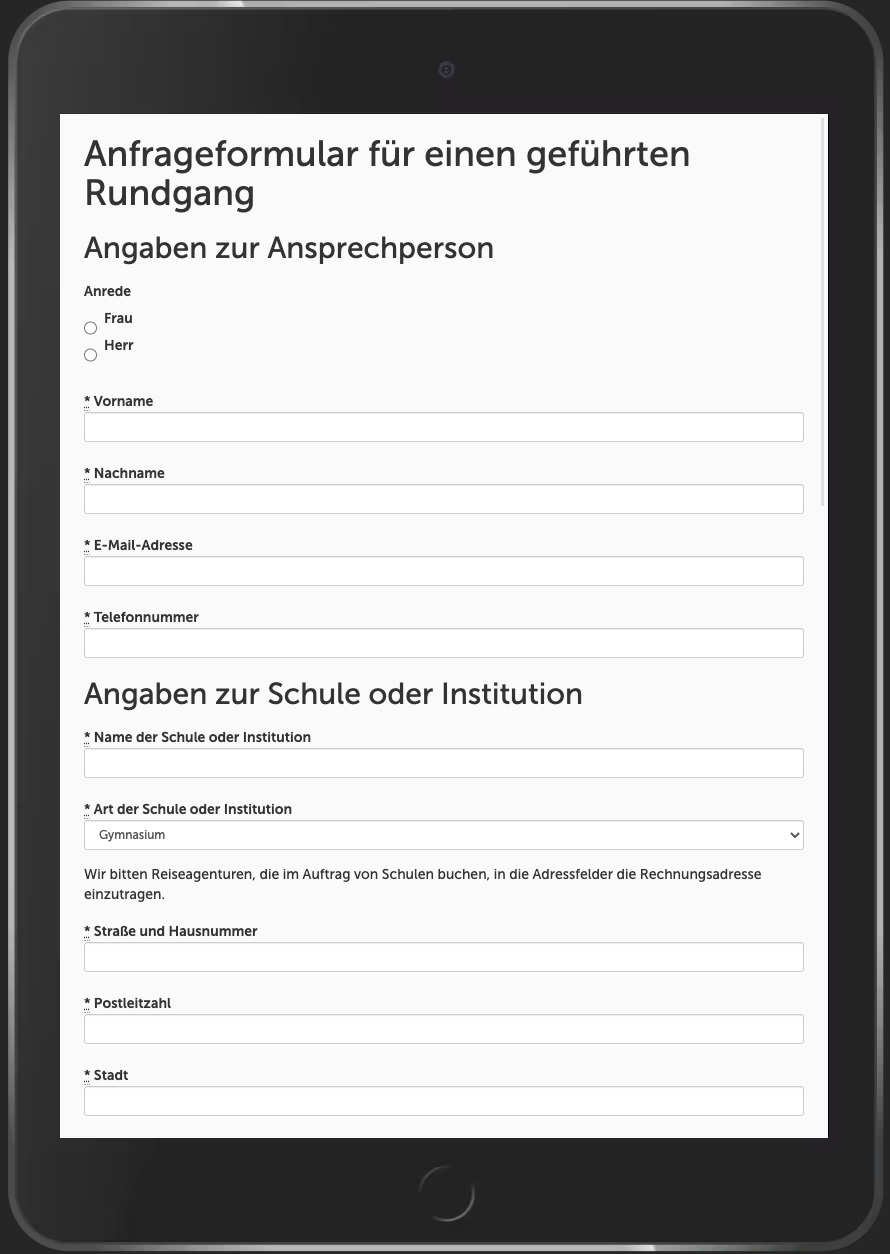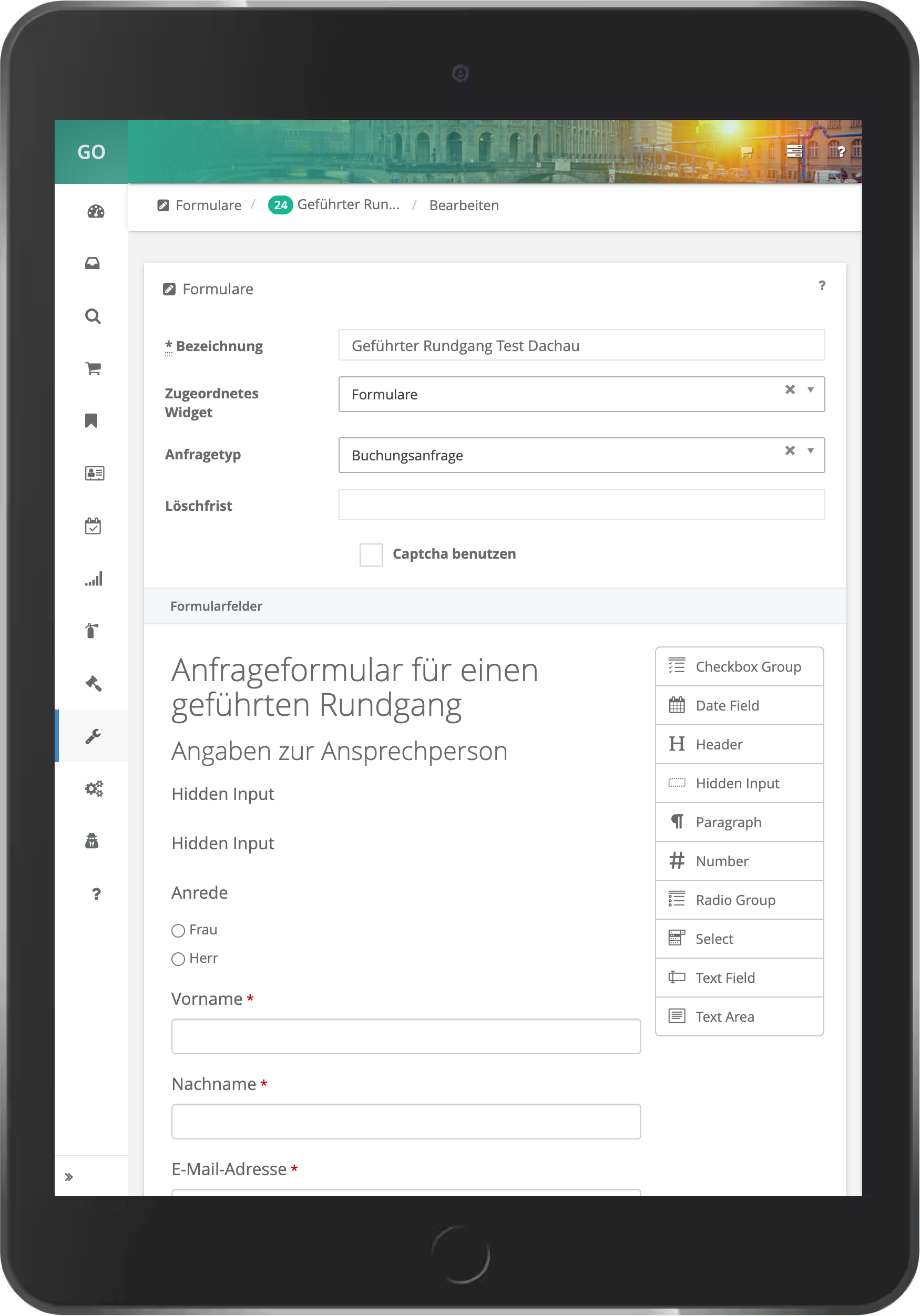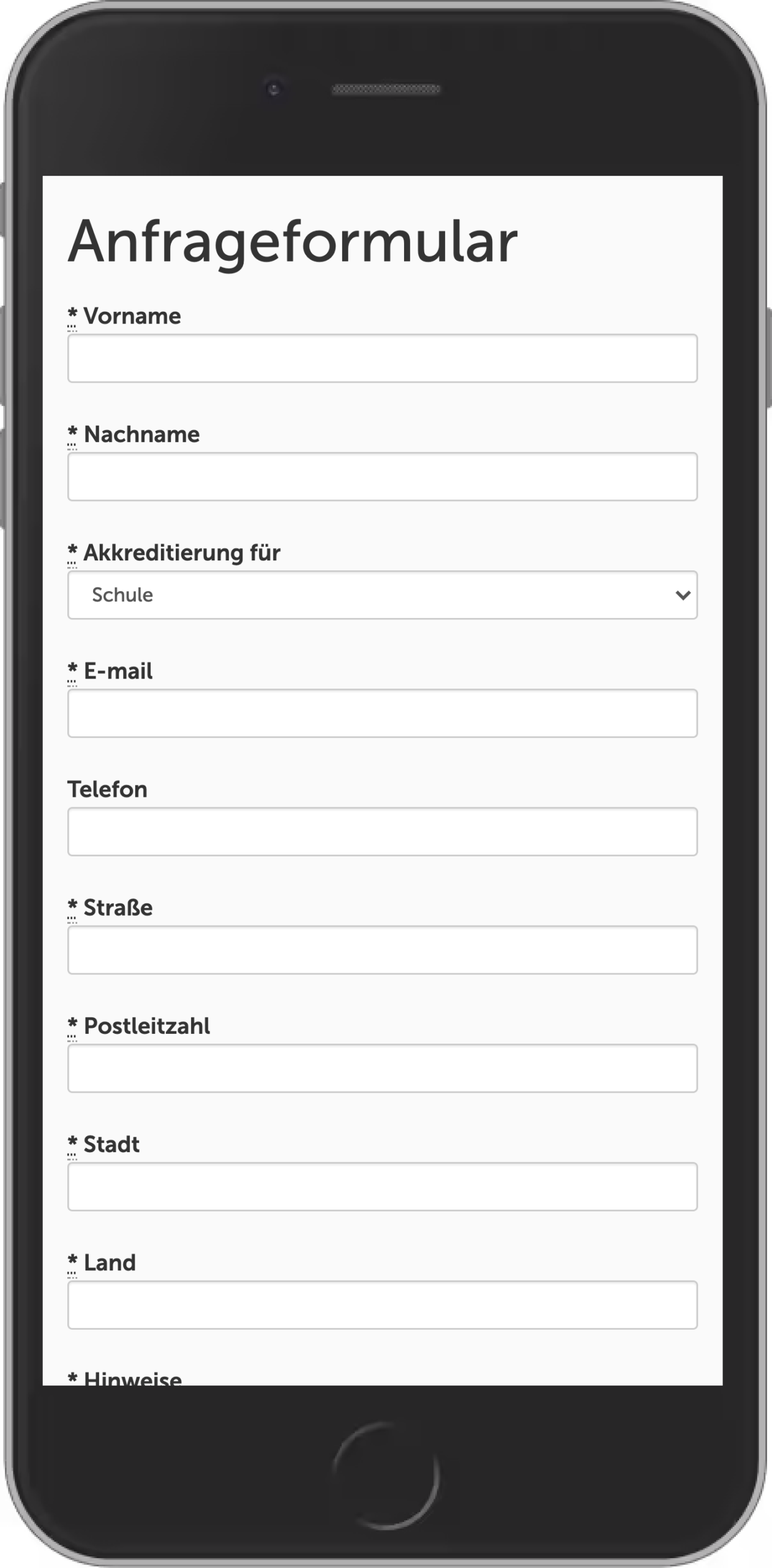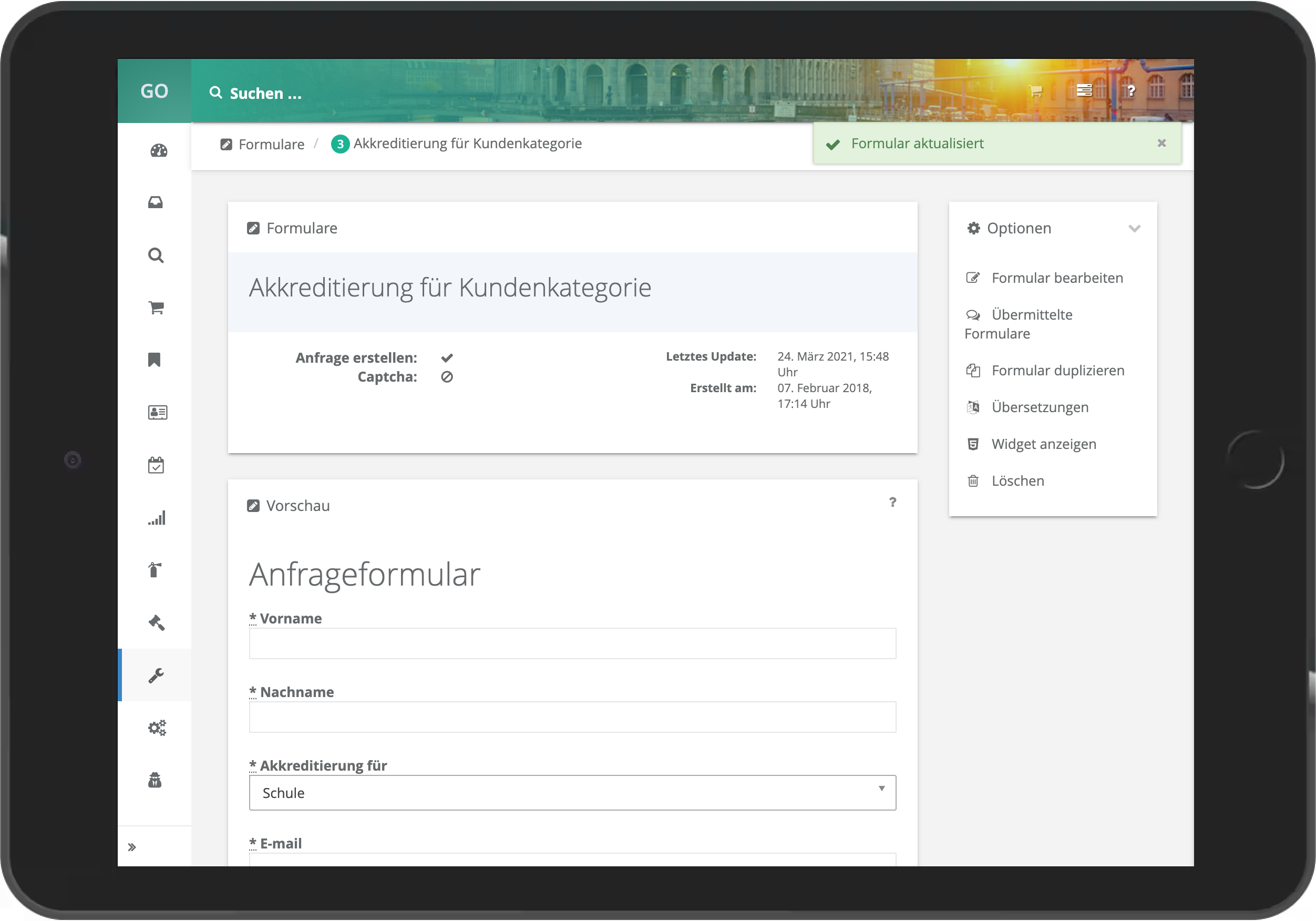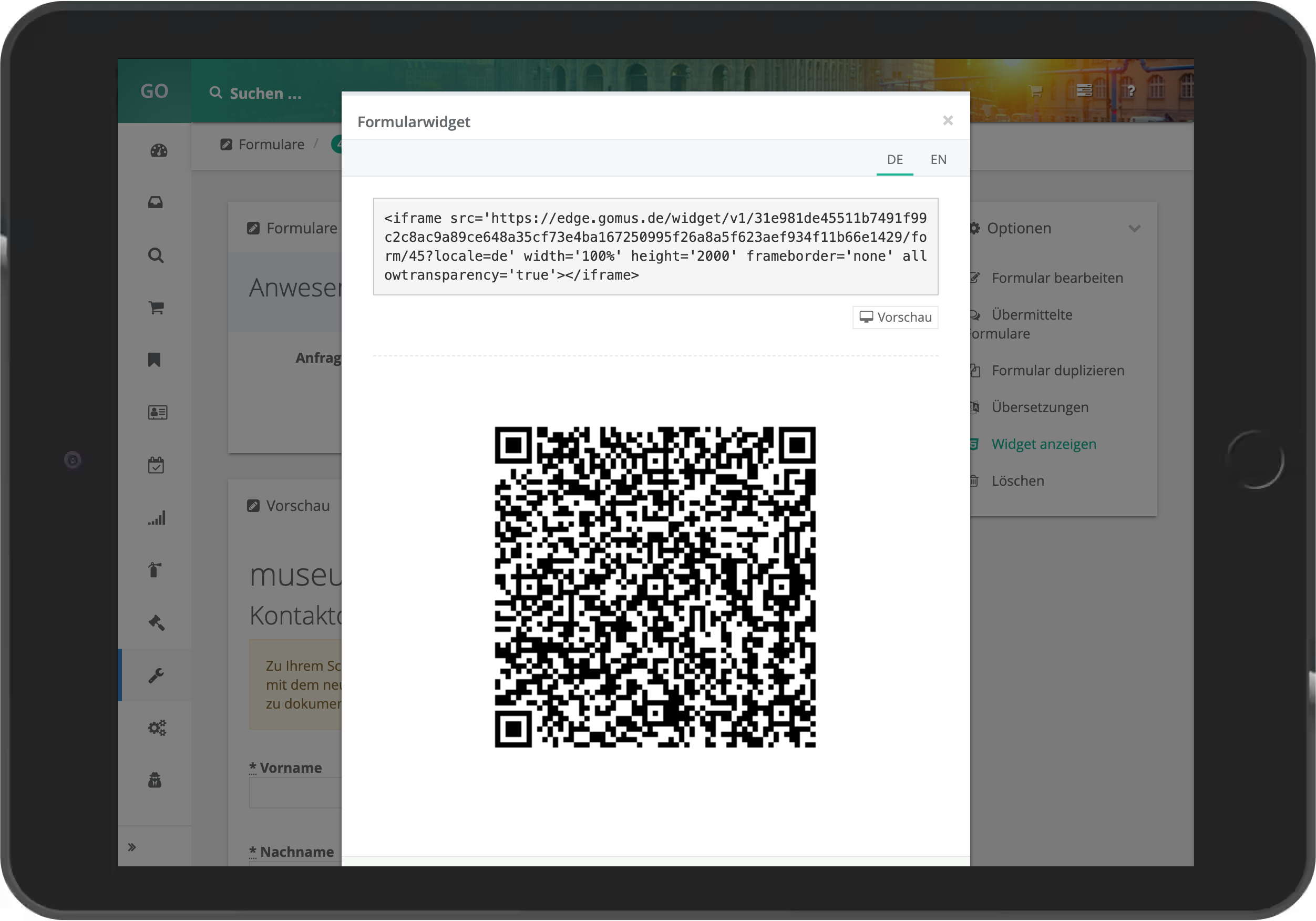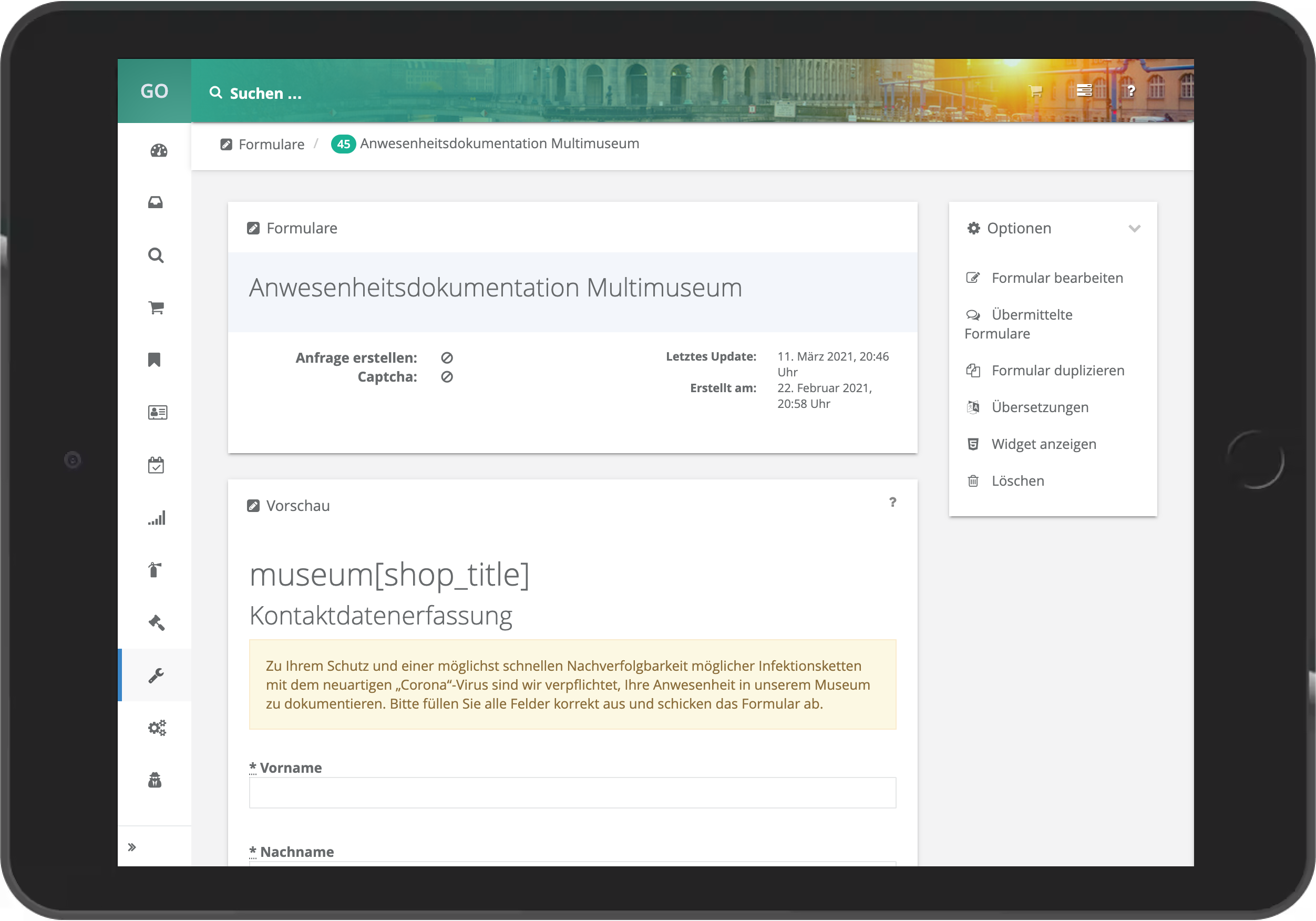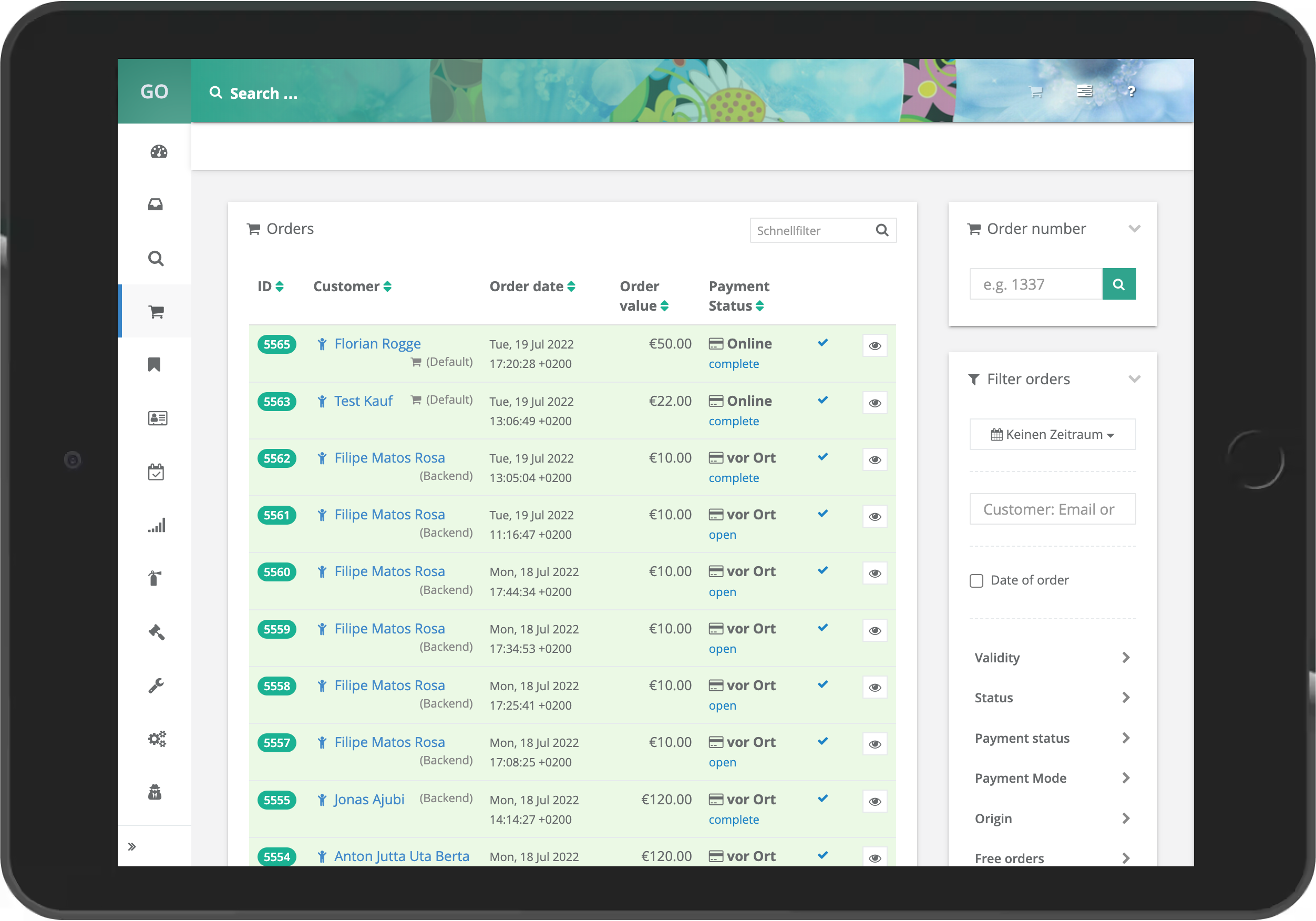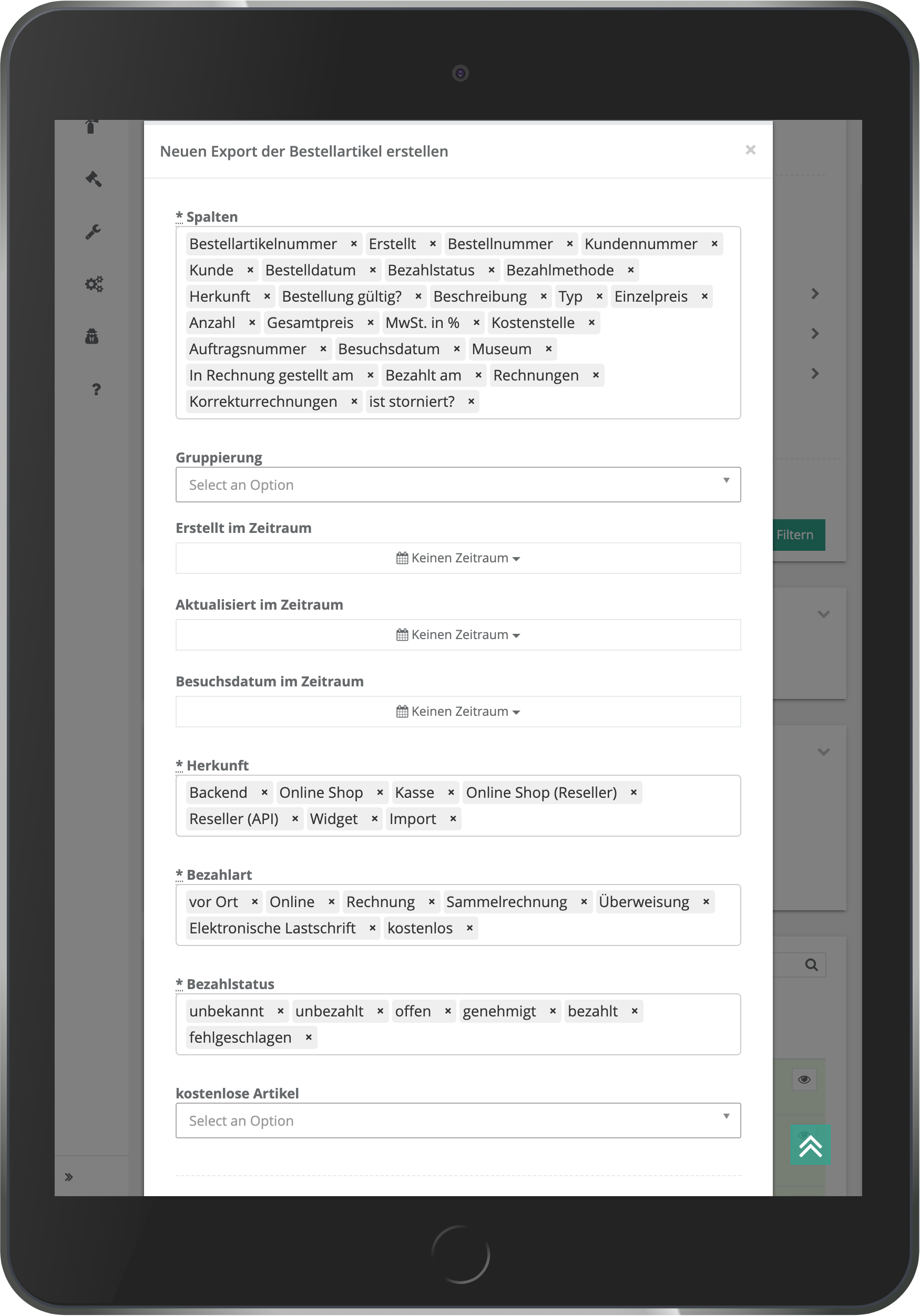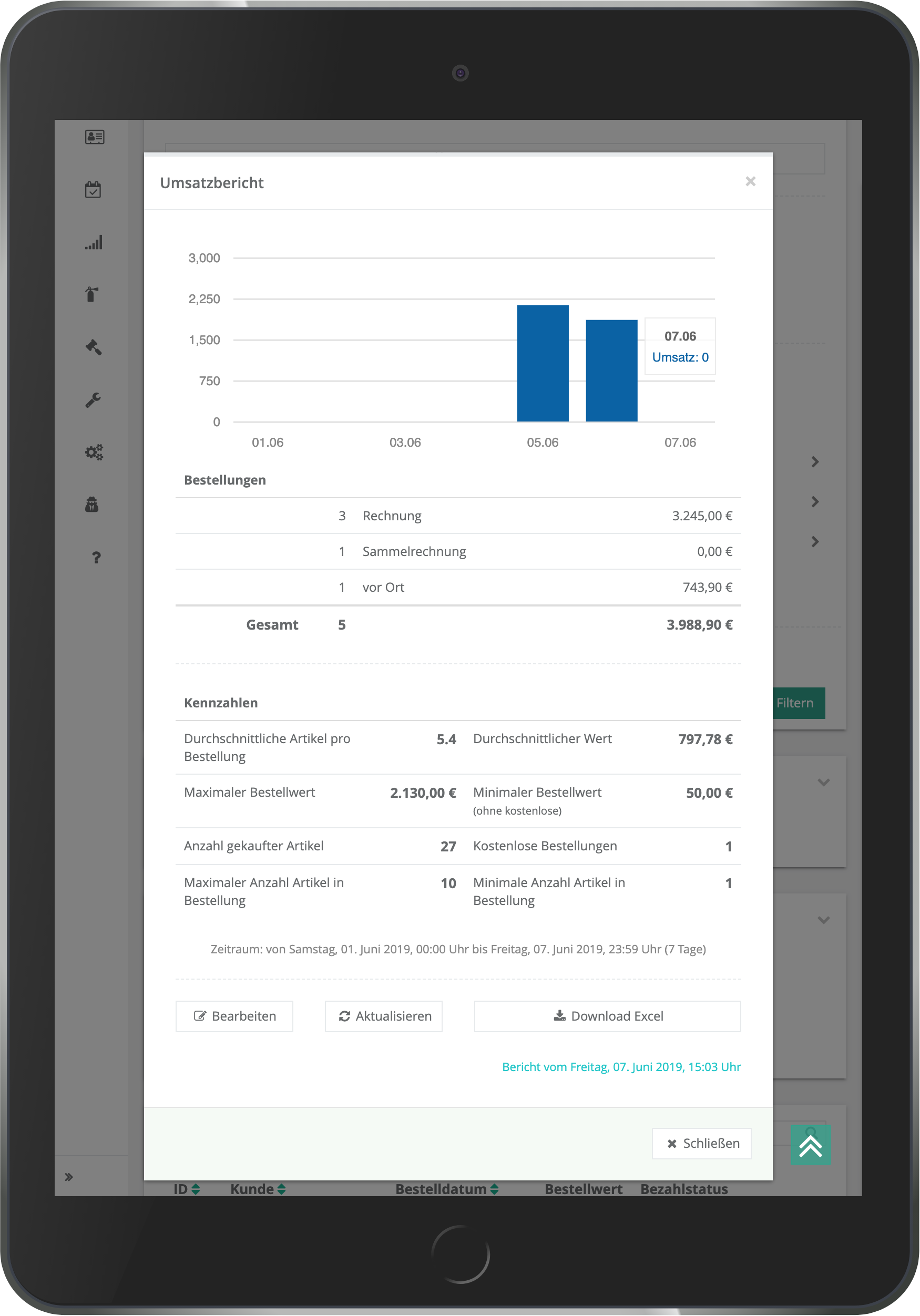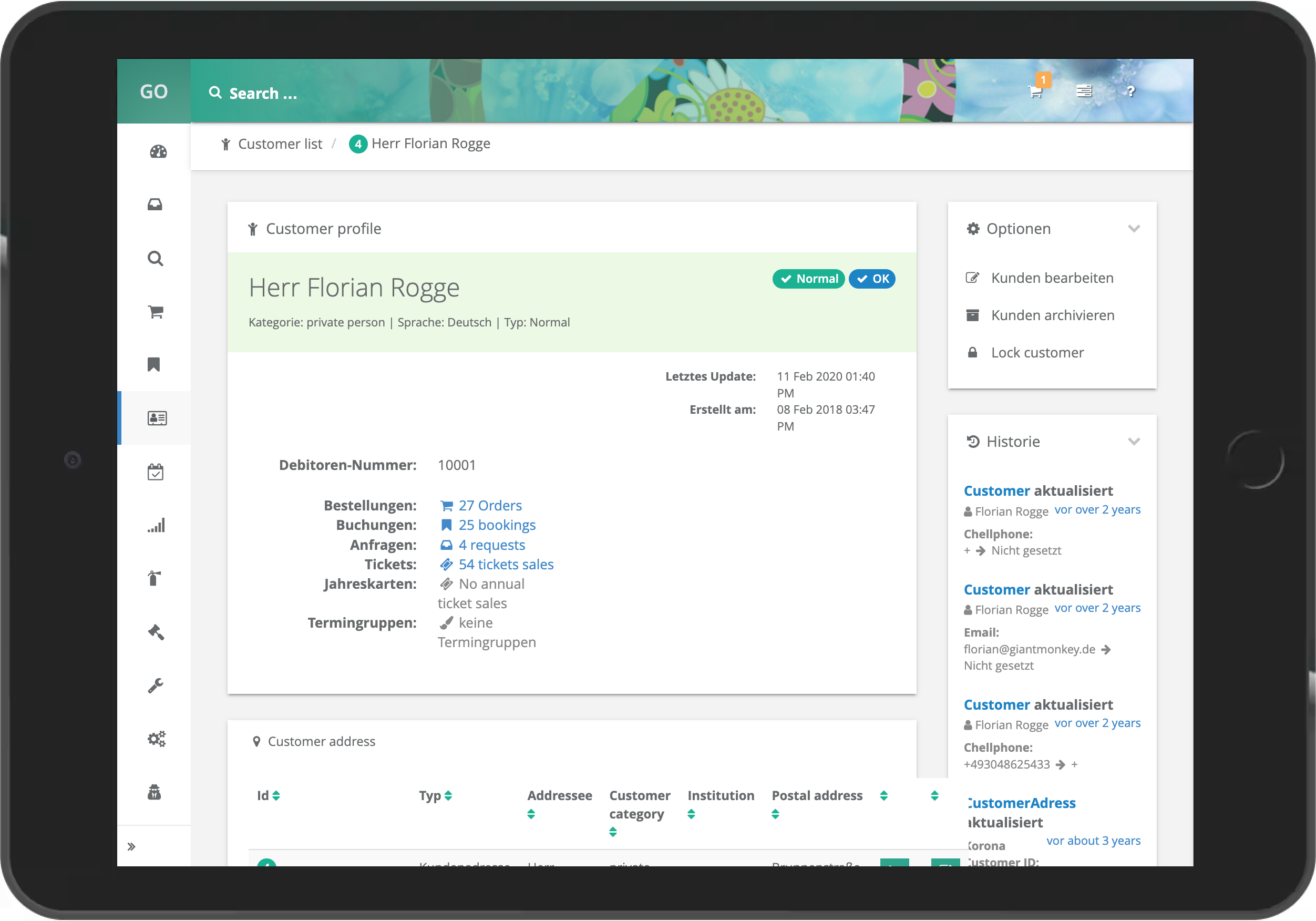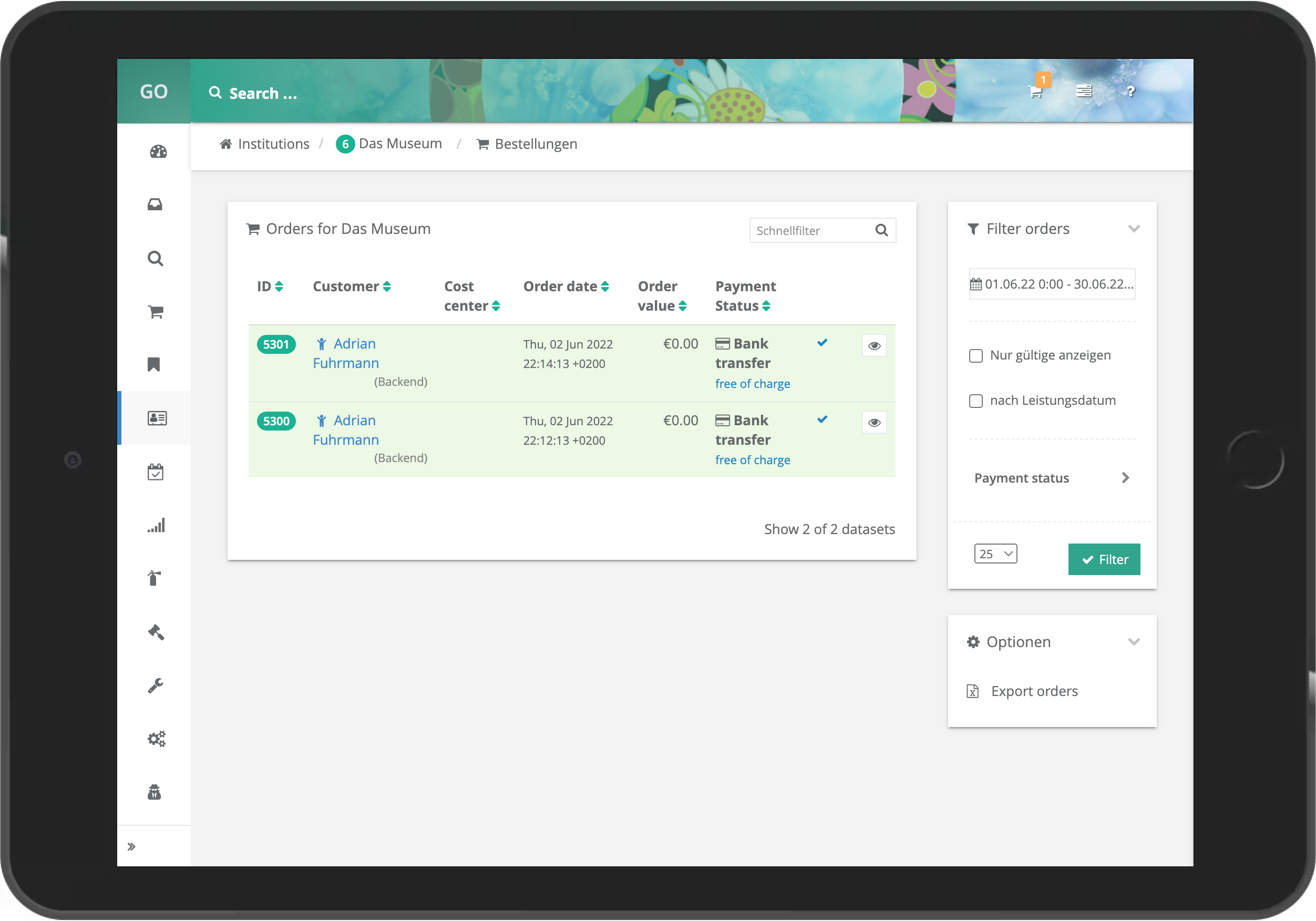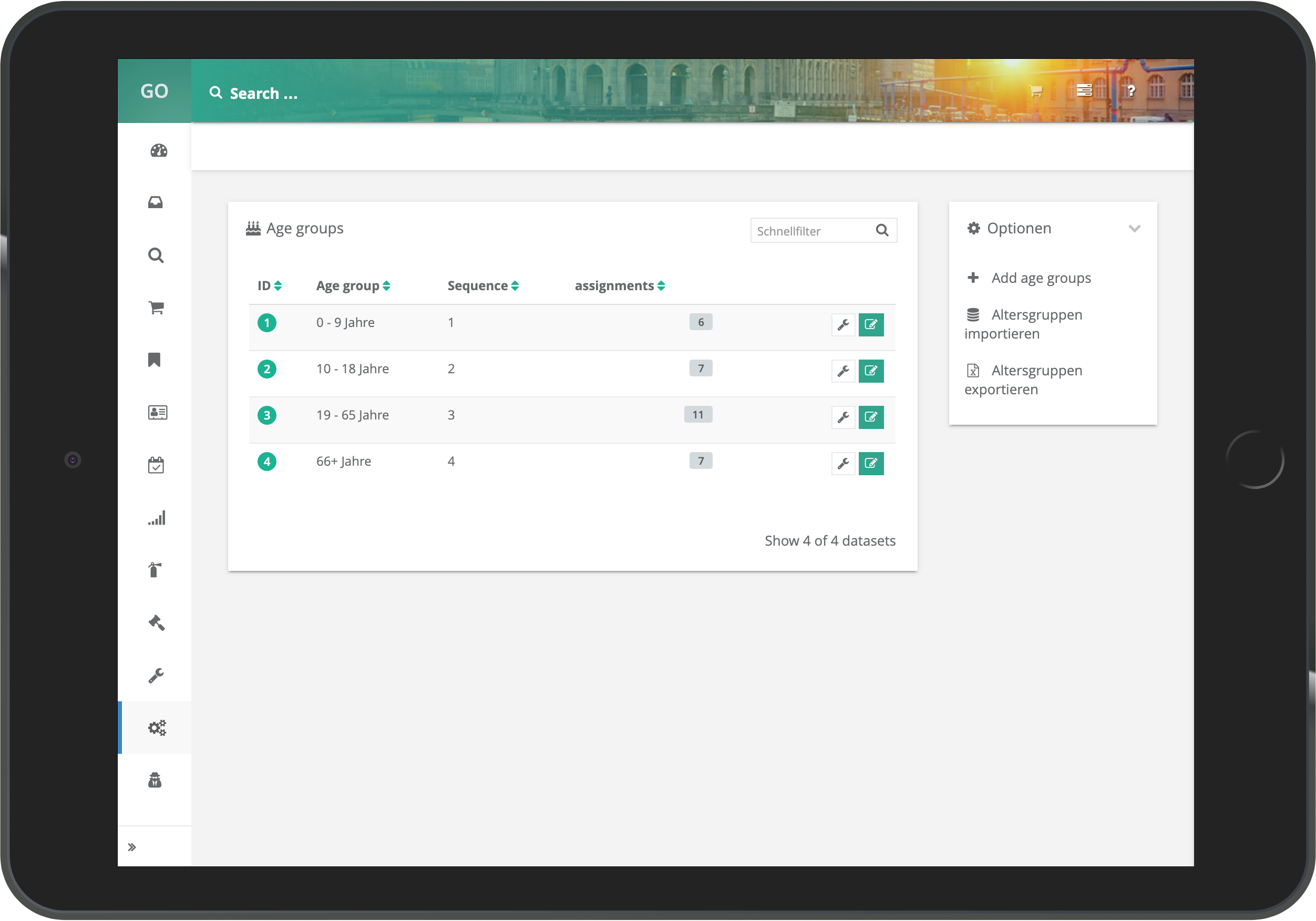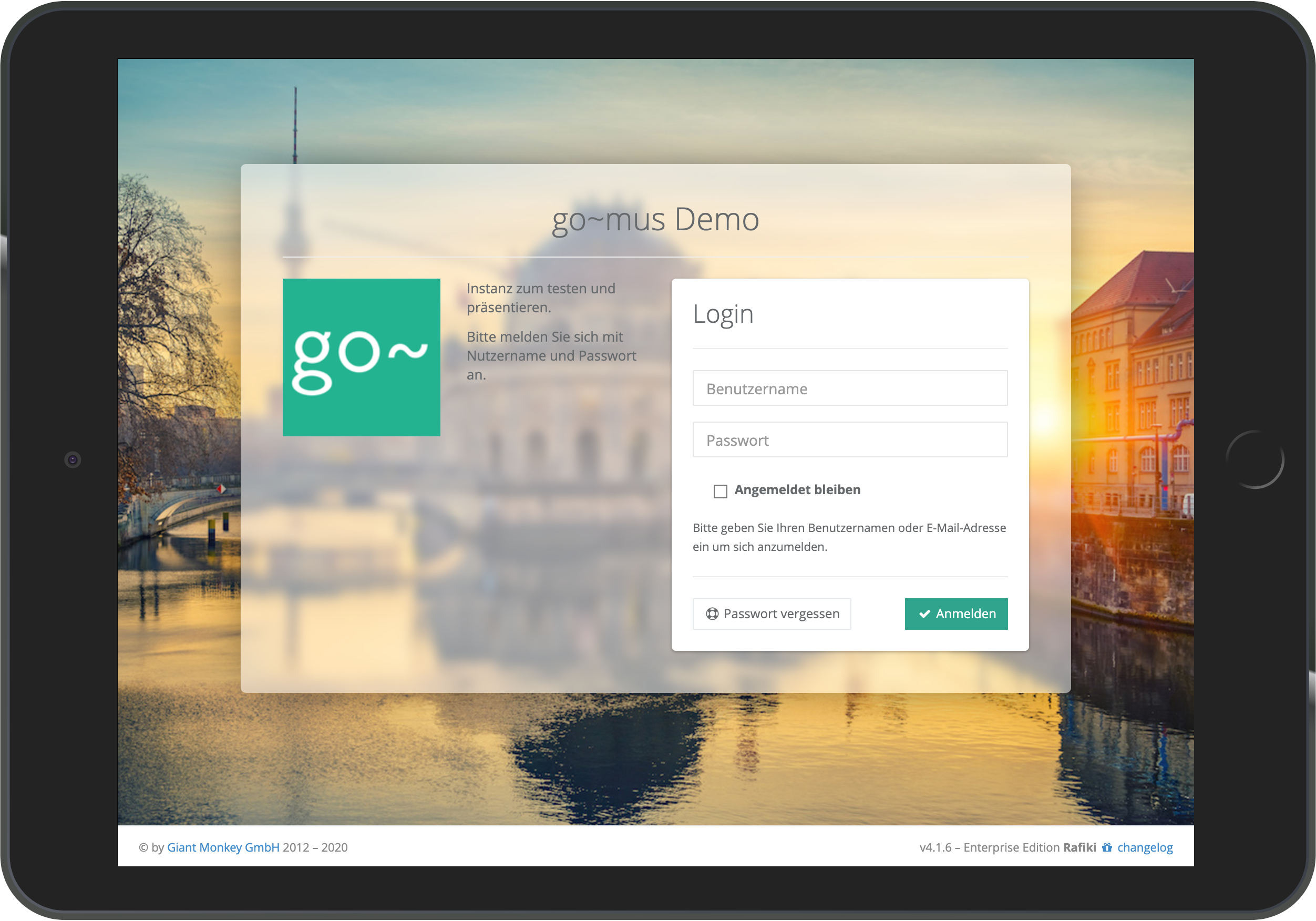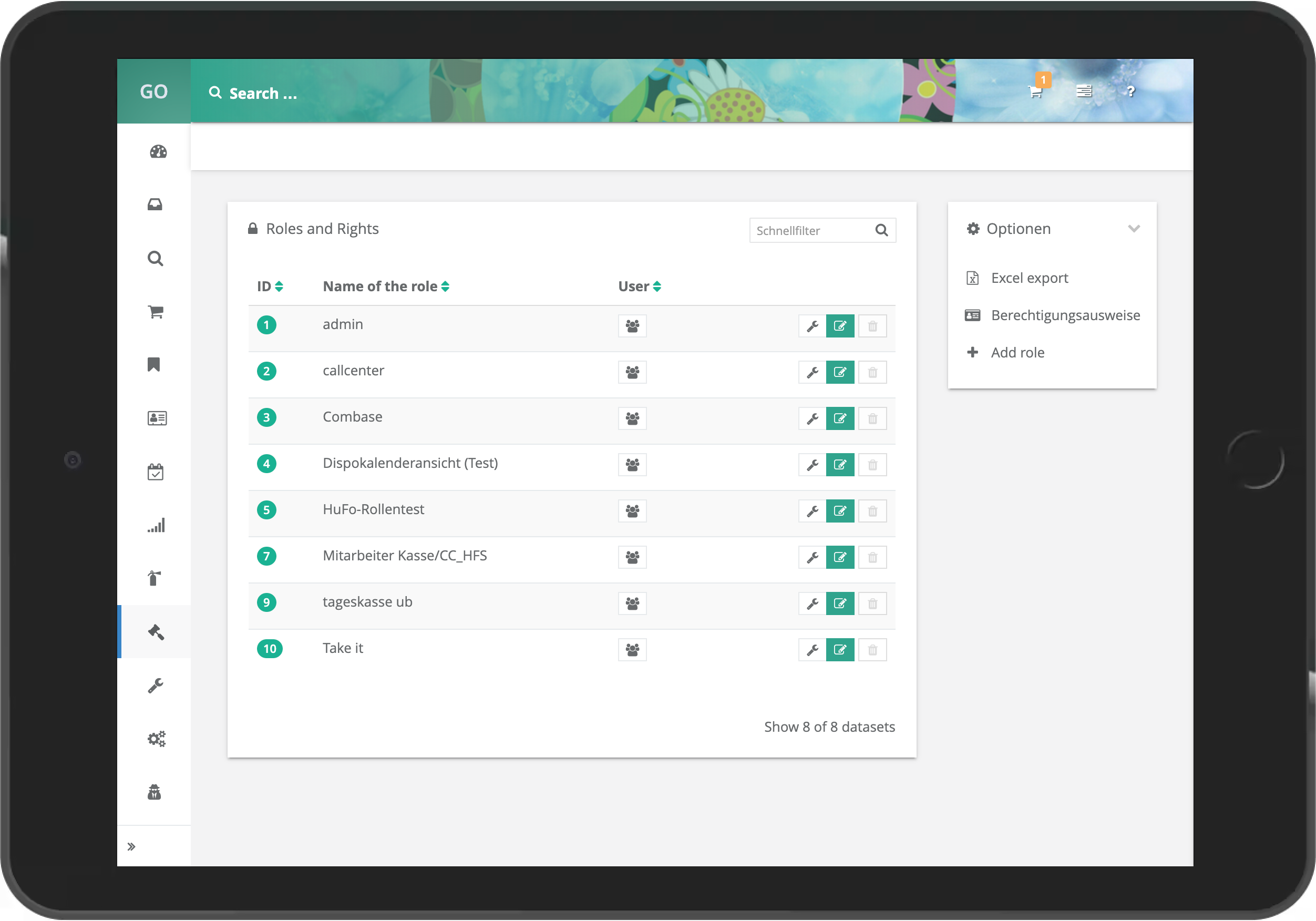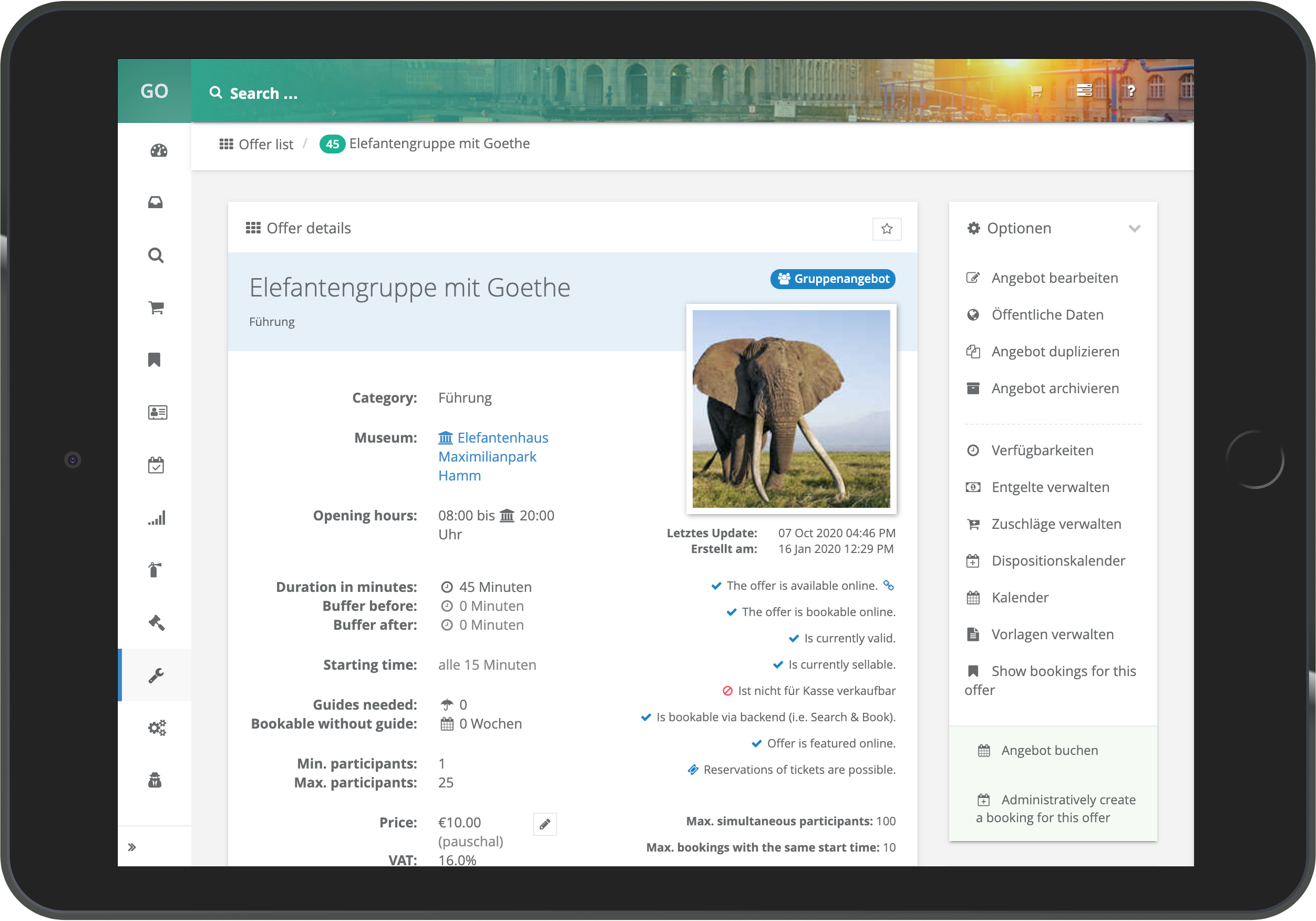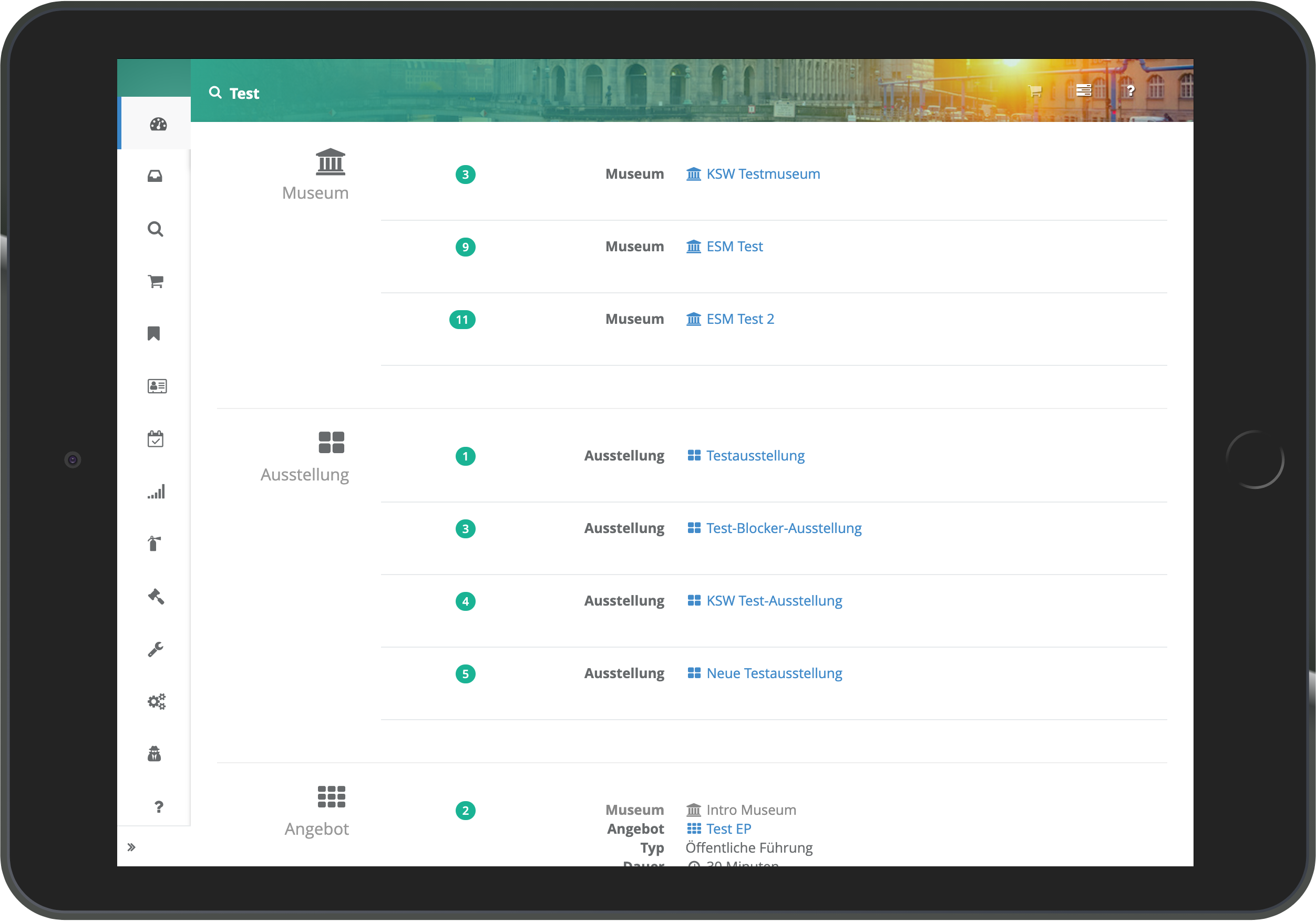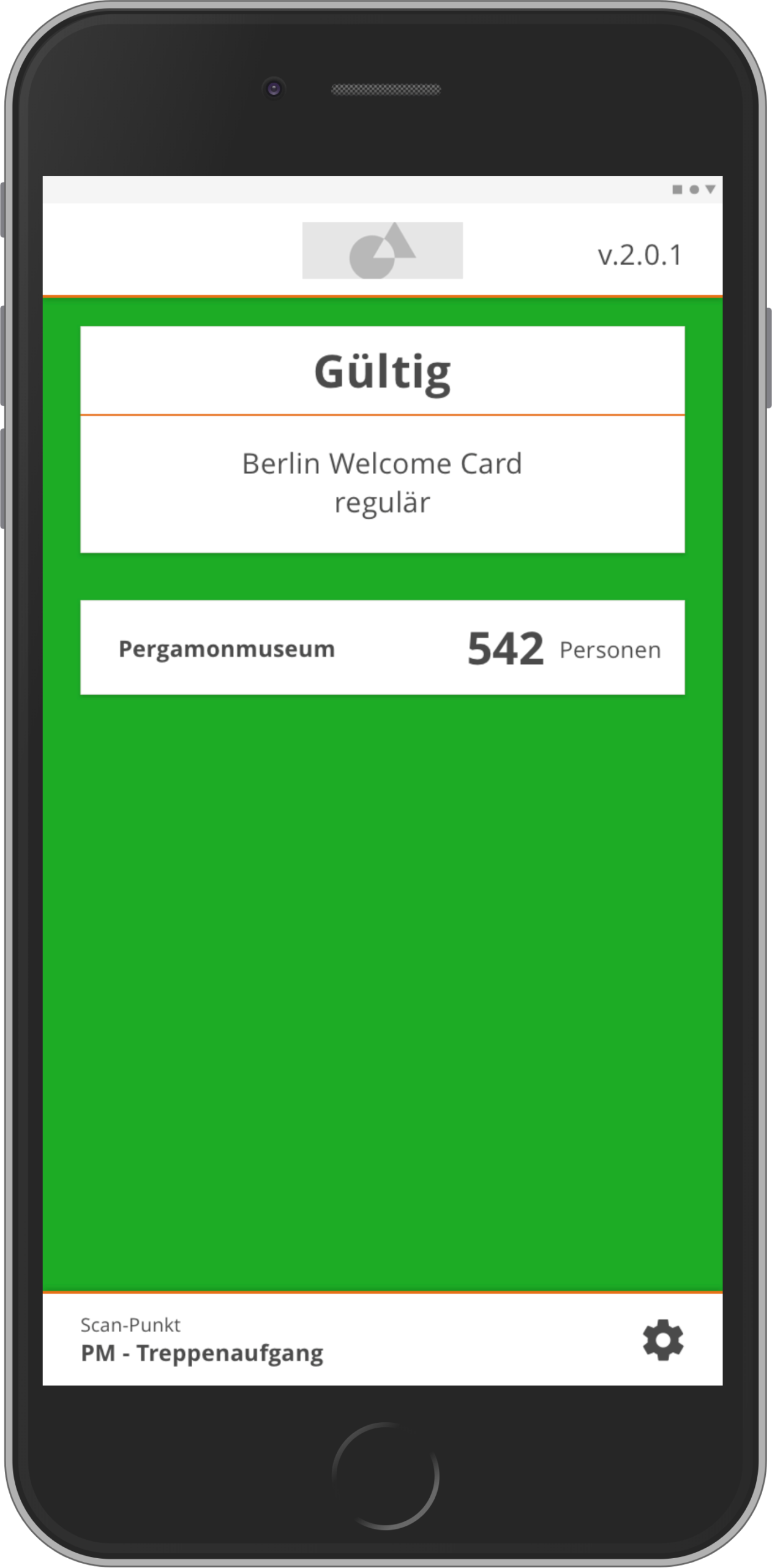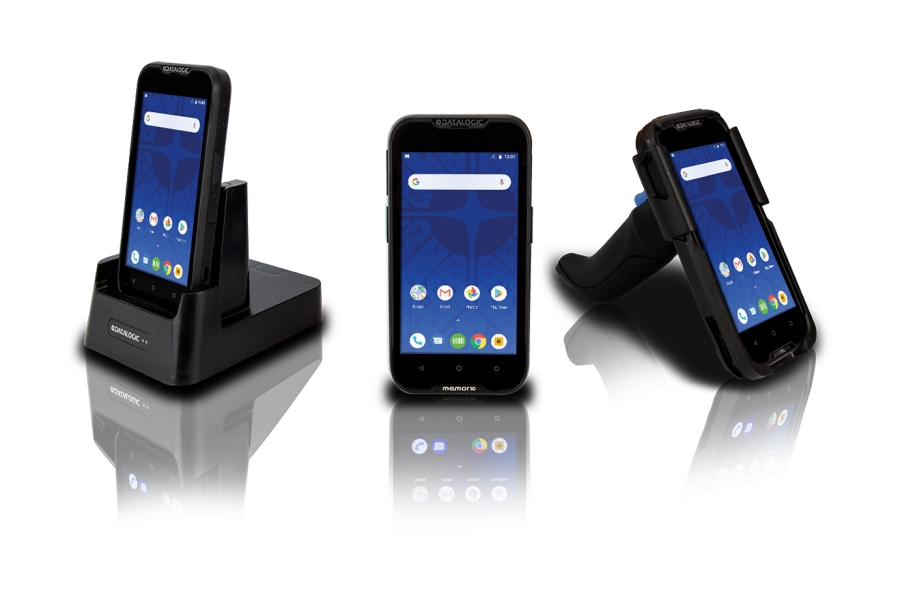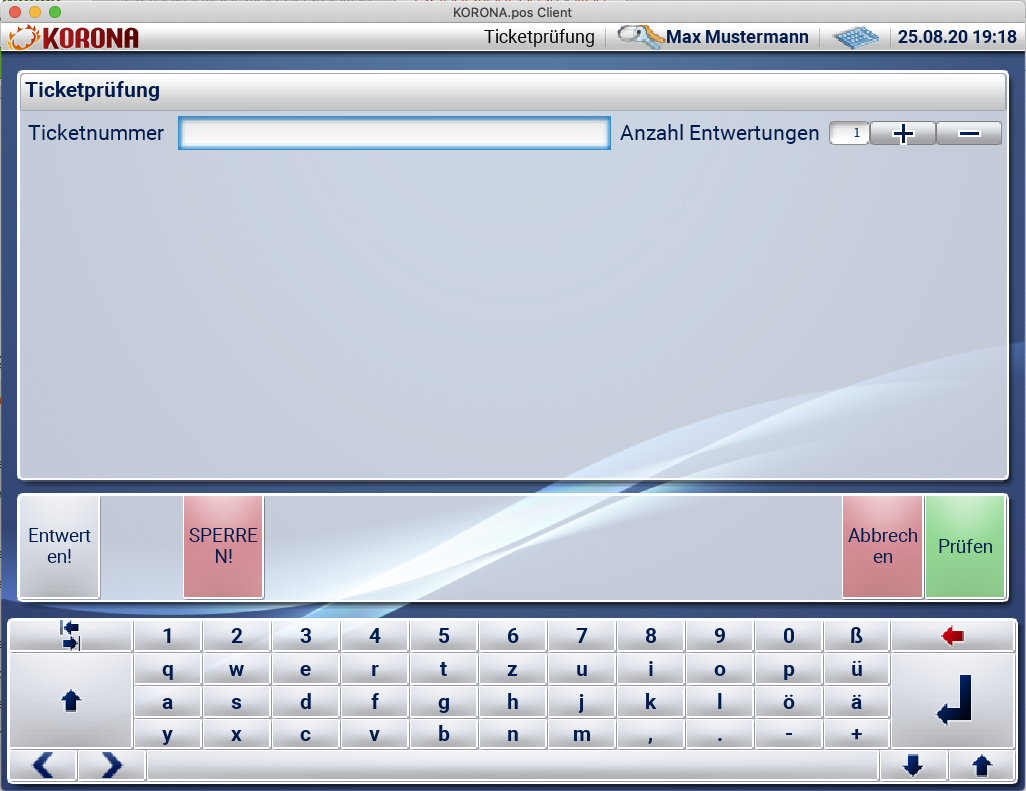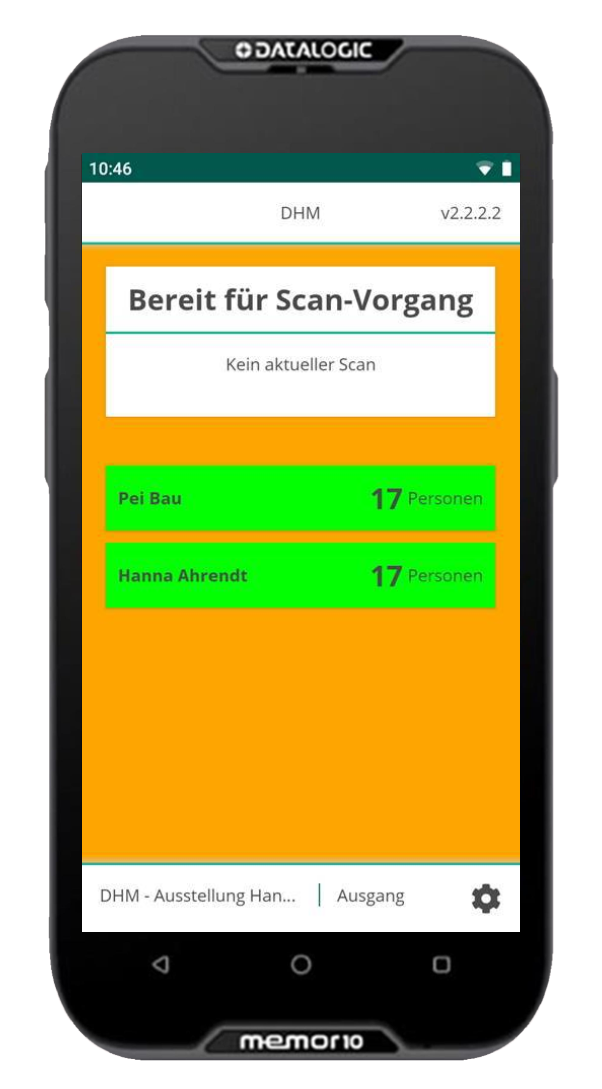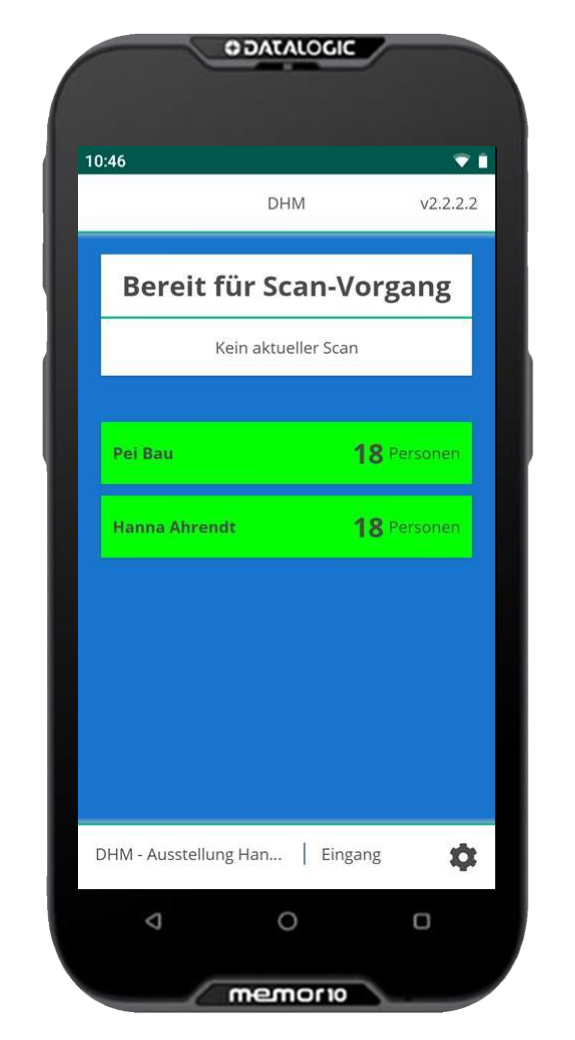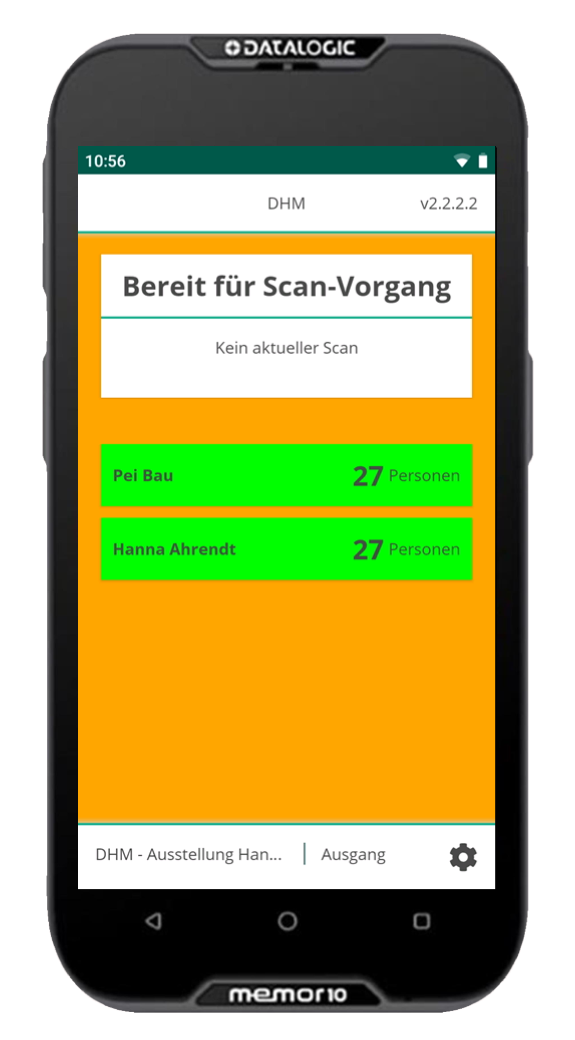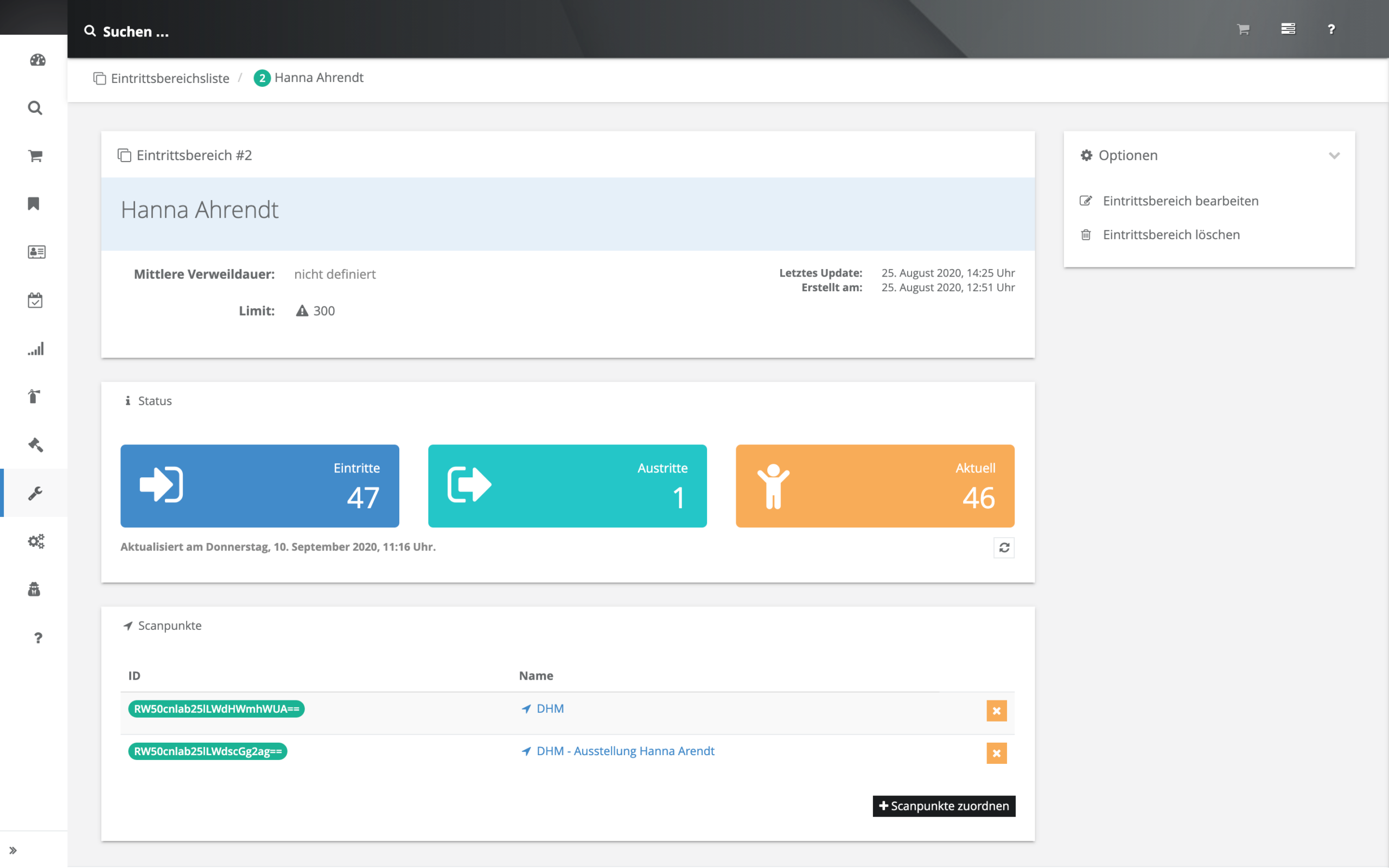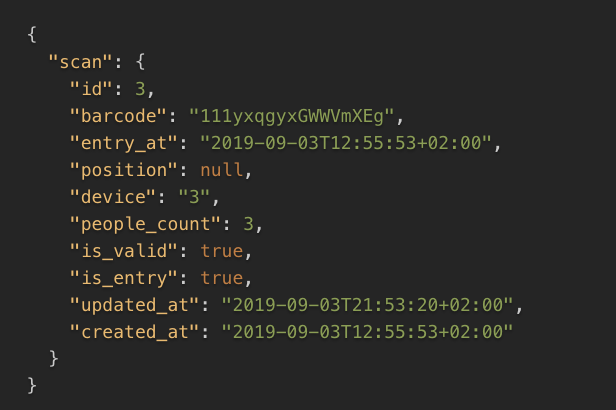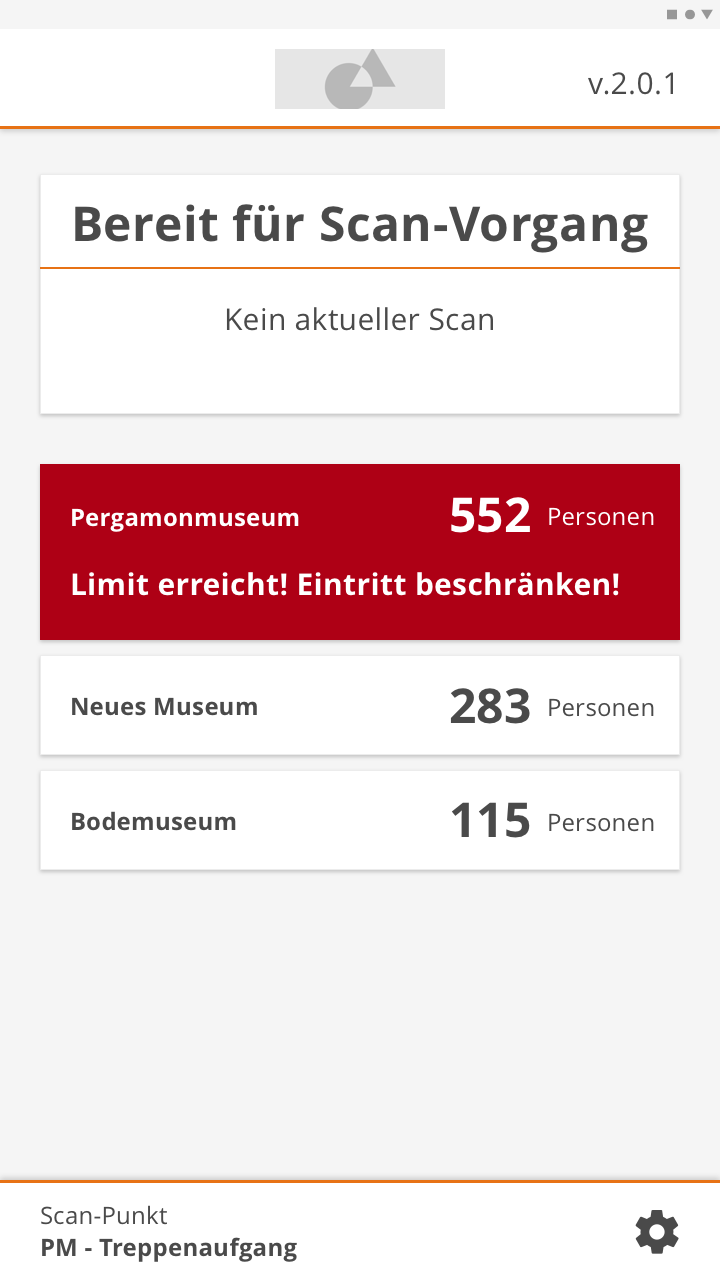Templates Function
Templates Function
Administration of templates for E-Mails, PDF-attachments, Passbook/Wallet-Tickets and ical-files.
One of the main functions included in every go~mus Edition is the Templates function.
It allows you to manage the templates that are used in communication with users, guides and especially customers.
Templates for e-mails, PDF attachments, Passbook tickets and calendar files can be managed.
Individual templates can be created for each museum, exhibition and offer, and extensive attachments can be defined.
In this way, you can address every target group adequately and, if required, send all desired documents automatically upon successful booking.
Functions
go~mus uses E-Mail to communicate, whether you create new guides in the backend and send them credentials or if customers purchase tickets online and have them shipped after successful payment. Consequently the administration of e-mail templates is especially important.
For all situations that require sending an E-Mail to a customer, user or guide, go~mus provides individual global templates. They can be adapted to match the museums need in regards to content and tonality of the E-Mail. Unless more specific templates are created for individual museums, exhibitions or products, these global templates will be used for all contexts.
go~mus also allows you to create individual templates per museum, exhibition or product. This allows you to adapt tonality and contact of your communication to the relevant target group.
go~mus provides many predefined placeholders that allow you to reference data in the templates.
Since go~mus can be integrated with several E-Mail-Servers, it is also possible to select individual E-Mail-accounts per template. Furthermore the BCC and reply-to addresses can be defined per template.
Die Details einzelner Datensätze werden in Detailansichten verwaltet. Auch hier garantiert konsistente Gestaltung, dass BenutzerInnen sich jederzeit gut zurecht finden.
The most important information is displayed directly in the profile of the respective data set, which users can see at first glance.
The options available to a particular user according to roles and rights in relation to the data set are always displayed on the right.
Assignments of other data to this record are made in the lower part of the web page.
Basic Module - Annual Tickets
Annual Tickets
Management and sale of annual and other season tickets.
Base modules define saleable products in go~mus. Annual tickets are one such product group.
go~mus allows you to manage annual tickets and sell them through all connected sales channels.
For annual ticket sales, the system provides robust processes for personalization and production, as well as for monitoring shipping or pickup.
Functions
You can manage any number of annual tickets in go~mus and sell them via the connected sales channels.
The name, validity period, price and sales channels can be customized.
Annual tickets that have been activated for online sale can be purchased there by all customers.
After purchase, customers receive a link for independent online personalization of the purchased tickets. Once the personalization process is complete, the tickets, hence admission cards can be produced and mailed or deposited for on-site pickup.
Annual tickets can also be sold at the cash desk on site. The sale at the cash desk is very simple.
Only personalization at the cash desk has various disadvantages. This is because personalization takes time and requires the connection of suitable printers at all cash desks as well as the provision of suitable card blanks.
That’s why our clients usually outsource personalization to a dedicated workstation.
Customers buy an annual ticket voucher at the cash desk and this is exchanged for the actual annual ticket at the annual ticket counter during the personalization process.
The cards can be produced and issued immediately.
Regardless of the sales channel through which the annual tickets were sold, go~mus provides support for the processes involved in producing and mailing or depositing the tickets.
For all annual tickets whose personalization has been fully completed, go~mus automatically generates print data in accordance with the agreed layout for annual tickets.
Tickets, hence cards that have been printed are automatically marked as ready for dispatch. After dispatch or deposit in the museum, the cards can be marked as “dispatched”.
Basic Module - Tickets
Tickets
Manage and sell daily and time slot tickets across all connected sales channels.
Base modules define products which can be sold in go~mus. Tickets, i.e. admission tickets for museums or exhibitions in the form of day and time slot tickets, are such products.
You can cover the management and sale of group offers and single visitor offers with dedicated go~mus modules.
The go~mus ticket module allows you to create any number of tickets and quotas. In addition, you can assign tickets to museums or exhibitions and individually define saleability, validity, time slots, sales channels and advance sales times.
By default, tickets are delivered as Print@Home tickets in PDF format. If you wish, you can also use the Passbook module to enable delivery as a Passbook ticket.
Functions
A ticket gives access to one or more museums or exhibitions. They can be sold with go~mus via the cash desk, online shop, backend (visitor service) and reseller sales channels.
With the time slot function you define the time period within which visitors possessing a ticket get access. Time slots can be defined in go~mus for between 15 minutes and 12 hours. Tickets without time slots are considered as day tickets.
You can control internal authorization concepts by assigning tickets to museums or exhibitions. You can also create external filters, e.g. in the online shop or at specific interfaces.
Grace periods allow you to control rigid time slot concepts in conjunction with ticket scanners or turnstiles in an accommodating manner.
The function to define a certain number of possible entries allows you to create multiple tickets. It also allows you to link admissions to other concepts, such as external catering, where visitors must leave the museum.
For the sale of group tickets, you can of course define the minimum number. Likewise, you can define the maximum number of tickets that can be purchased.
You can mark a ticket as “reduced” and thus automatically advise the supervisory staff to show the reduction certificate when scanning the ticket.
With a quota, you define the number of tickets that can be sold per time slot and the distribution of this number among the sales channels.
For this purpose, the tickets for which the quota is to apply are assigned to a quota.
You can define different types of quota rules to control the saleability of the assigned tickets:
- Weekday rules (all selected weekdays)
- Calendar day rules (a specific calendar day)
- Holiday rules (all holidays defined under Holiday)
go~mus allows you to sell tickets through the following sales channels: Online shop, cash desk, backend, reseller.
With the help of the quota sales channel control, you can define the respective ticket numbers that can be sold for pre-sales and daily sales, down to the exact percentage.
In this way, you can ensure that a certain number of tickets is held at the cash desk for spontaneous visitors on site. Resellers should only sell the designated quota, so that overall, however, an optimal capacity utilization is achieved.
Basic Module - Events
Basic Module - Events
Management and sale of individual visitor offers (public tours, readings, concerts, etc.)
Base modules define sellable products in go~mus. One product group that can be managed and sold with go~mus is that of individual visitor offers.
Single-visitor offers are different from group offers and are characterized by creating appointments in advance. Many visitors can book partial quotas of the total quota of the appointment.
This makes it possible to map a variety of offers, like public tours, readings, concerts and many more.
The event module allows you to create any number of different offers with any number of dates and offer them through the connected sales channels.
Customers receive booking receipts for events (event tickets) as Print@Home tickets in PDF format.
Functions
Every event managed with go~mus is based on a template, the offer. Based on the offer, dates for the offer, i.e. the actual events, can be created with little effort.
This applies to individual events as well as to event series.
All events (dates of such a single-visitor offer) share the following characteristics:
- Duration
- Constant assignments
- Room assignments
- Guide assignments
- Figure
go~mus offers different possibilities to determine prices and costs of an offer. In doing so, go~mus always falls back on so-called pricing items. These can come from a connected merchandise management system or be defined directly in go~mus and contain, in addition to the price, above all the taxes.
The following approaches to pricing single visitor offers exist in go~mus:
Flat rate
Single-visitor offers are rarely priced as a flat rate. However, in rare cases, this approach may be needed or a combined approach of flat price and surcharges may be suitable.
For this purpose, the pricing item is simply assigned to the offer and then applies to all dates of the offer upon registration, regardless of the number of participants.
Graduated prices
As a rule, events are priced per person.
To do this, simply create the tariffs/scale prices, describe them, assign pricing articles and activate sales channels.
If a room including seating is assigned to an offer, i.e. the dates of the offer take place in a room with a seating plan, the prices of the offer categories of the seatings can be defined.
Surcharges
Regular pricing structures often contain exceptions. One of the ways to map them in the system are surcharges. Surcharges can be defined as optional and mandatory and apply per group or per attendee. Furthermore, it can be defined whether surcharges should also be booked in the online shop. There are surcharges based on a price that customers have to pay and based on a fee that has to be paid to guides.
go~mus allows the following types of surcharges:
- General surcharges: Any surcharges can be mapped here. Since there are no underlying rules, this is best suited to represent optional additional services.
- Sunday surcharges: This can be used to automatically calculate a surcharge for all bookings to which the surcharge applies and which take place on Sundays.
- Customer foreign language surcharge: This can be used to pass on higher guide fee costs for foreign language tours to customers.
- Foreign language surcharge guide fee: This can be used to automatically calculate a surcharge on the guide fee for all bookings in foreign languages (all languages except German).
- Special surcharge fee: Special surcharges on the guide fee can be booked here.
- Language surcharge: Unlike foreign language surcharges, language surcharges can also be charged on bookings in German.
- Weekday surcharge: This can be used to automatically calculate surcharges if bookings are made on certain weekdays.
- Participants surcharge: Depending on the number of participants, these surcharges allow the definition of a combined price structure. This consists of a flat basic price and a participant-related pricing if the number of predefined participants is exceeded.
- Time-based surcharge: Time-based surcharges are only applied if the start time of the booking falls within the defined period.
Such surcharges can be created globally, per museum, per exhibition and per offer and are considered hierarchically by go~mus.
Payment methods
go~mus allows to define per offer which payment methods are available.
This does not include the payment methods offered by the payment service provider in the online shop. Since these cannot be defined on an offer-specific basis, they are defined globally in the backend of the payment service provider.
However, it is possible to configure, for example, whether an offer can be booked on account or on “on-site payment”.
Guide fee
In addition to the prices, the costs are also defined in the offer.
The guide fee can be defined per booking or per hour. This value is automatically used for the fee calculation when booking the offer.
From the offer, hence the event template, appointments have to be created. For the creation of individual appointments, go~mus offers a weekly and daily calendar view.
This enables to check why no appointment can be created at a certain point in time. Thus makes it possible to quickly and purposefully make adjustments to the settings or clarify resource conflicts.
In this way, individual appointments can be created quickly and efficiently, taking into account the configured resource requirements.
For regular appointments and appointment series go~mus offers a series appointment generator.
This allows to create up to 50 regular appointments per run.
During the creation, the holidays managed in the constants of the system can be used as exclusion or inclusion criteria.
The title, subtitle and description of the events can be entered in the languages managed in the system, so that the online shop displays the events correctly in all the languages stored.
The title, subtitle and description can be enriched using various placeholders. The following placeholders are available:
- [[COUNT]] Counter as number
- [[ROMAN_COUNT]] Counter as roman number (I, II …)
- [[ALPH_COUNT]] Counter as alphabetic character (A, B …)
- [[LALPH_COUNT]] Counter as alphabetic character (a, b …)
- [[DATE]] 02.07.2021
- [[TIME]] 12:20 o’clock
- [[WDAY]] Friday
- [[DATE_TIME]] Friday, 02 July 2021, 12:20 p.m.
This way, regular dates such as public tours can be created quickly and reliably and labeled in a comprehensible way.
In addition to controlling the sales channels, the saleability of group offers can still be controlled by the following parameters:
- Periods for validity: Enables the temporal control of the bookable dates (For when can it be bought).
- Periods for saleability: Enables the temporal control of the saleability (When can it be sold)
- Shop Assignments: Enables multi-shop instances to control in which online shop which offer is sold.
- Institutions: Allows to enable the purchase of offers only to customers who belong to specific institutions.
go~mus enables the sale of single-visitor offers through the following sales channels: Online store, Checkout, Backend, Reseller.
For each offer it is possible to define through which channels it can be sold.
Additionally, it can be defined which scale price is available through which channel. For more information, see Prices and costs.
Registrations for appointments of individual visitor offers require the prior creation of appointments.
The same resources are considered for the creation of these appointments as for group offerings.
Relevant resources may include:
- Museum
- Exhibition
- Room
- Offer
- Availability
Availability controls the basic time availability of resources. Availability is defined in 15-minute blocks.
The configuration of availabilities allows a very individual control of the bookability of offers via so-called availability rules.
Alternatively, availabilities can be blocked or released.
Limiting factors
In addition to the availabilities, the bookability of offers can be controlled via so-called limiting factors.
Limiting factors exist analogous to availabilities on all levels of resource management, i.e. for museums, exhibitions, rooms, offers but also for guides.
The following limiting factors are available for single-visitor offers:
- Max. simultaneous participants
- Max. Number of bookings at the same start time
- Max. Number of simultaneous bookings
- Max. Number of bookings on the same day
- Max. Total number of bookings
- Max. Number of bookings per order
go~mus allows you to freely define so-called constants within different categories.
These constants can then be assigned to offers (group and individual visitor offers) in order to categorize them. Furthermore, this enables filtering on the website, in the online shop and in the backend.
The following constants are available:
- Age groups
- Class levels
- Restrictions
- Visitor categories
- Keywords
- Languages
- Target groups
Via the so-called public data, text can be maintained in all activated languages within freely definable fields.
The texts are then printed on PDF templates, displayed in the online shop and output via the API.
The text can be HTML formatted, so it can contain links, images, formatting and more.
Public data can be maintained for museums, exhibitions, rooms, offers and tickets.
Examples for public data of an offer:
- Title
- Subtitle
- Description
- Meeting place
- Image title
- Image description
- Image copyright
Basic Module - Groups
Basic Module Groups
Management and sale of group offers via all connected sales channels
Basic modules define saleable products in go~mus. Group offers, i.e. offers for groups of visitors that bundle content, costs and resource requirements, are such products.
The group module allows you to create any number of group offers, assign museums or exhibitions, define space requirements, guide requirements, saleability, validity, time slots, sales channels and presale time individually.
Visitors receive a booking receipt as a PDF document by e-mail when booking group offers.
Functions
Each offer must have a defined name. This is primarily used for internal orientation. The external presentation can be configured individually per language via the public data of an offer. More about public data below.
Each offer must be assigned to a museum. This assignment is also the basis for filters in the backend and online shops as well as for access restrictions of the users. Bookings of offers can be evaluated on the basis of the museums.
Furthermore, each offer can be assigned to an exhibition. This assignment also enables corresponding filtering in the backend and online shop. It also ensures inherited resource requirements when rooms are assigned to the exhibition. An evaluation of the bookings of offers based on exhibitions is also possible.
Offers must be assigned to offer categories. This results in the possibility of filtering, but certain attributes of the offer categories are also inherited.
An image can be uploaded for each offer, which is used in the backend and online shop. Furthermore, a color-coded identification can be made, which is used in calendar and list views and makes it easier to find bookings of certain offers again.
go~mus offers different possibilities to determine prices and costs of an offer. In doing so, go~mus always falls back on so-called pricing items. These can originate from a connected merchandise management system or be defined directly in go~mus and contain primarily the taxes in addition to the price.
Flat rate
Group offers are usually priced at a flat rate, i.e. no matter how many people participate, the price is always the same.
The corresponding pricing item is assigned to the offer and then applies when the offer is booked, regardless of the number of participants and the sales channel.
Price per person, graduated prices
This type of pricing is mostly used for single-visitor offers, but can also be used for group offers. In this model, the price of the booking depends on the number of participants per price category/scale price.
For this purpose, the possible scale prices are created, linked to pricing articles and the sales channels available for the respective scale price are defined. For example, the scale price “Free, press” can only be booked by the visitor service, but not by the online shop or the cash desk.
Charging tables
Some institutions work with a usage and fee schedule. This usually defines prices and charges of the offers based on certain parameters.
go~mus makes it possible to create such fee schedules and to ensure the pricing of the offers on the basis of these schedules. For this purpose, a price and guide fee can be entered for each cross product of offer category and customer category, which go~mus then takes into account for all bookings of corresponding offers by specific customers.
Such fee orders can be created globally, per museum, per exhibition and per offer (then only allows definition of costs per customer category) and are taken into account hierarchically by go~mus.
Surcharges
Regular price structures are often broken by exceptions. One of the ways to represent them in the system are surcharges. Surcharges can be defined as optional and mandatory and apply per group or per participant. Furthermore, it can be defined whether surcharges should also be booked in the online shop. There are surcharges on the price that customers have to pay and on the fee that has to be paid to guides.
go~mus allows the following types of surcharges:
- General surcharges: Any surcharges can be mapped here. Since there are no underlying rules, this is best suited to represent optional additional services.
- Sunday surcharges: This can be used to automatically calculate a surcharge for all bookings to which the surcharge applies and which take place on Sundays.
- Customer foreign language surcharge: This can be used to pass on higher guide fee costs for foreign-language tours to customers.
- Foreign language surcharge guide fee: This can be used to automatically calculate a surcharge on the guide fee for all bookings in foreign languages (all languages except German).
- Special surcharge fee: Special surcharges on the guide fee can be booked here.
Language surcharge: Unlike foreign language surcharges, language surcharges can also be charged on bookings in German. - Weekday surcharge: This can be used to automatically calculate surcharges if bookings are
- made on certain weekdays.
Attendee surcharge: This surcharge in conjunction with the flat-rate basic price enables pricing structures with a fixed price for up to a certain number of attendees and attendee-based pricing for all attendees above the threshold. - Time-based surcharge: Time-based surcharges are only applied if the start time of the booking falls within the defined thresholds.
Such surcharges can be created globally, per museum, per exhibition and per offer and are considered hierarchically by go~mus.
Payment methods
go~mus allows to define which payment methods are available for each offer.
This does not include the payment methods offered by the payment service provider connected to the online shop. Since these cannot be defined on an offer-specific basis, they are defined globally in the backend of the payment service provider.
However, it can be configured, for example, whether an offer may be booked on account or on “on-site payment”.
Guide fee
In addition to the prices, the costs are also defined in the offer. The guide fee can be defined per booking or per hour. This value is automatically used for the fee calculation when booking the offer.
Unlike for individual visitor offers, the bookability for group offers is not determined by predefined dates.
The bookability of group offers depends on the time availability and resource utilization of all required resources.
Decisive factors can be:
- Museum
- Exhibition
- Room
- Offer
Availability
Availability controls the basic time availability of resources. Availability is defined in 15-minute blocks.
The configuration of availabilities allows a very individual control of the bookability of offers via so-called availability rules.
Alternatively, availabilities can be blocked or released.
Limiting factors
In addition to the availabilities, the bookability of offers can be controlled via so-called limiting factors.
Limiting factors exist analogous to availabilities on all levels of resource management, i.e. for museums, exhibitions, rooms, offers but also for guides.
The following limiting factors are available:
- Max. simultaneous participants
- Max. Number of bookings at the same start time
- Max. Number of simultaneous bookings
- Max. Number of bookings on the same day
- Max. Total number of bookings
In addition to controlling the sales channels, the saleability of group offers can still be controlled by the following parameters:
- Periods for validity: Enables the temporal control of the bookable dates (For when can it be bought).
- Periods for saleability: Enables the temporal control of the saleability (When can it be bought)
- Shop Assignments: For multi-shop instances, enables to control in which online shop which offer is sold.
- Institutions: Allows to enable the purchase of offers only to customers who belong to specific institutions.
go~mus allows you to freely define so-called constants within different categories.
These constants can then be assigned to offers (group and individual visitor offers) to categorize them, as well as to enable filtering on the website, in the online shop and in the backend.
The following constants are available:
- Age groups
- Class levels
- Restrictions
- Visitor categories
- Keywords
- Languages
- Target groups
Via the so-called public data, text can be maintained in all activated languages within freely definable fields.
The texts are then printed on PDF templates, displayed in the online shop and output via the API.
The text can be HTML formatted, so it can contain links, images, formatting and more.
Public data can be maintained for museums, exhibitions, rooms, offers and tickets.
Examples for public data of an offer:
- Title
- Subtitle
- Description
- Meeting place
- Image title
- Image description
- Image copyright
Calendar Function
Calendar Function
Calendar views of bookings and external dates. Views for day, week, month and calendar subscriptions
Another function included in all go~mus editions is the calendar function. It displays bookings in calendar views for day, week and month.
Indicators for notification status of customers as well guides allow a quick and easy overview on first glance. On hover go~mus displays extensive details to every booking.
This allows you to get a quick overview as well as a detailed drill down.
Funktionen
This calendar displays bookings in a clear monthly view. The degree of details provided per booking is low, only booking number and time as well as color indicators for booking state and notification of guide and customer are displayed on first glance.
Mouse over displays detailed information about the selected booking.
go~mus provides calendar subscriptions for guides and users. They allow subscribing to bookings and displaying them in the native calendars from Outlook, Google, Apple etc. In contract to a simple calendar export, a subscription will be updated when the relevant booking in the system is changed.
Users can decide whether they want to subscribe to:
- All boookings
- All external dates
- All bookings of a certain product category
That way the educational department can subscribe to all bookings of e.g. guided tours while the event department would subscribe to events only.
In addition to the global monthly calendar and the given filters, go~mus also provides individual calendars with daily, weekly and monthly view for every museum, exhibition, product and room.
Every one of these calendars allows you to subscribe to the dates displayed therein. That way it is possible to subscribe only to dates of bookings that use a certain room or relate to a certain exhibition.
Together with the means to control user roles and permissions and their ability to access one or several museums, this provides means to restrict calendar viewing privileges to the necessary minimum.
Reporting Function
Reporting Function
Visual and tabular evaluation of data of visitors, bookings, orders and ticket sales
An important function that is included in all go~mus editions is the reporting function. It provides exports and reports for data related to the basic modules (tickets, events, groups).
Functions
All bookings of events and group tours as well as ticket sales are always encapsulated in an order. All invoicing is always based on the order. Order reporting therefore focusses on payment methods, sales channels and revenue.
The visitor statistic provides visual and tabular evaluation of bookings focussing on the visitor and his/her indicators. Through preselects a reference time span as well as a comparison period can be selected quickly and easily. The visitor statistic then compares the two and provides information on relative changes.
The booking statistic provides visual and tabular evaluation of bookings with a focus on the bookings and their characteristics. Through preselects a reference time span as well as a comparison period can be selected quickly and easily. The booking statistic then compares the two and shows relative changes.
Special Module - Forms
Forms
Creation and management of forms for customer requests and contact tracing
The forms module offers a full fledged forms generator which allows users to create individual forms. go~mus provides these forms as iframe so that they can easily be integrated into the website. The forms can be used to provide customers with a channel for general inquiries, booking requests as well as entering their personal information in the context of contact tracing.
Features
Many institutions provide contact forms on their website to allow their customer to inquire about any given information directly via the website without having to publish an e-mail-address.
There are dedicated services for such contact forms, such as Wufoo and others.
The forms module allows you to create individual forms via drag&drop. These forms are provided by go~mus as iFrame and can easily be integrated into your website
Inquiries made with these forms create customer requests in go~mus that can be handled accordingly directly on go~mus.
go~mus +shop allows you to sell tickets, group tours and events online.
Sometimes it might not be desirable to allow customers to purchase certain products. This can be the case, when these products require certain scarce resources such as certain rooms or dedicated guides.
For larger groups using the online-shop might also not be ideal, as the shop is made to sell certain products for one group for a certain time, but not for finding available slots for several groups or complex programs consisting of several products.
To enable customers to inquire about such products and programs without having to transfer lengthy e-mails into go~mus manually we offer forms for booking inquiries.
Inquiries made via these forms are captured as booking requests in go~mus and can be handled using group splitting and the program planner. When customers accept the resulting proposed program, its elements can be transferred from the non-binding inquiry into one or several binding orders. More about this in Advanced Module – Requests.
In addition to general inquiries and booking requests go~mus also enables you to provide forms for accreditation to certain customer categories or institutions.
This is relevant because go~mus allows you to price products with a fee table based on customer category and product category. For a teacher to be able to buy a group tour online at the correct price, this customer needs to belong to the relevant customer category. Since belonging to a certain customer category can result in reduced prices, customers can obviously not simply select their customer category..
Accreditation forms hence allow customers to request accreditation to certain customer categories or institutions.
GDPR compliant handling of personal data of participants was already important before SARS-Cov2 and go~mus provided meaningful functionality in that regard. With Covid and the obligation to capture personal data of all visitors this importance has further increased.
go~mus separates customer data and participant data categorically.
The museum as responsible entity in the sense of GDPR may only keep personal data of data subjects as long as justifiable in their GDPR records of data processing activities. Customer data, at least in Germany, is further subject to GOBD (Principles for properly maintaining, keeping and storing books, records and documents in electronic form and for data access, as provided by the German tax authorities). The museum is hence compelled to keep that data for 10 years. Personal data of participants is not covered by these principles and can hence be deleted after a reasonable time.
Customers also aren’t always participants, even if they book just one ticket, therefore just capturing the customers data might not fulfill your obligations.
The forms module allows you to create forms for capturing participant data. These forms can have a context, e.g. an event or an exhibition, allowing you to deliberately trace participants of certain contexts. The forms are provided by go~mus as iFrame and QR-Code. The iFrame allows you integrate the form on any given page of your website. The QR-Code can be printed on posters or displayed on screens in the entrance area. When a visitor scans it with their phone, the form for contact tracing will be displayed and the customer can enter their personal data. This data will be stored in go~mus in a dedicated view for contact tracing. Accessing this view requires dedicated permissions. Participant data is presented to authorized users and can be deleted, anonymized, changed and exported.
Orders Function
Orders Function
Management of orders of all customers from all sales channels
Orders are at the core of your customer relations. They touch on invoicing, rescheduling, cancellations and all customer communication. The corresponding orders function is therefore included in all editions of go~mus.
These features ensure that users stay on top of orders and related processes.
Features
The list view of orders shows orders according to the filters the user sets.
The following filters are available:
- Time frame
- Date of order / date of visit
- Validity
- Status
- Payment status
- Payment mode
- Origin (sales channel)
- free / fee based
The list also allows you to search for orders by customer name and e-mail address.
The detail view of an order gives an overview of the most important details of the order and provides access to relevant options related to the given order.
Depending on the permissions of the user they will have access to the following features and links:
- Cancel order
- Change order item
- Cancel oder item
- View order history
- Send, access, print documents
Together with the billing module the order detail view also provides invoicing.
The order detail view furthermore provides drill down access to related data sets, such as customers, ticket sales and bookings.
Powerful export generators provide means to export orders and order items. The export is provided as .xls-file.
Structure and order of columns in the export can be defined freely.
Grouping of items can also be configured.
The time frame that needs to be exported can also be defined.
Furthermore users can filter the data by several parameters.
Finally there is an option to send the export per mail after it has been created. Given the creation of exports can take some time (especially when a lot of columns are exported and the time frame is long) this allows users to continue their work and automatically get notified after completion of the export.
Reports on orders are essential. They provide key insights into the performance of the institution as a whole, of certain products and sales channels.
go~mus provides an easy to use revenue report that displays relevant KPI visually and numerically.
The report data can also be exported as .xls-file.
Customers Function
Customers Function
Management of customer categories, customers, institutions and addresses
Customer categories, customers, institutions and addresses are essential to the management of customer relations. They are managed by the features of the costumer function which is included in all editions of go~mus.
Features
Customer categories allow segmentation of the customer base. Since this segmentation is done differently everywhere, customer categories can be freely defined in go~mus.
Offers can be priced in go~mus by means of a charge table, among other things. The charge table makes it possible to set prices per customer category and offer category. Accordingly, the definition of customer categories can also be the basis of the price structure.
Orders are initiated by customers. Customers are persons managed in go~mus. Only for orders of the sales channel checkout, usually no customer data is collected or existing customers are assigned.
Even if an order is placed for an institution (company, association, organization, etc.), a person (customer) is always responsible in go~mus. The connection of the customer to the institution can be set and is visible. It is also possible to display all associated customers and all orders of all customers belonging to the institution.
A customer belongs to a customer category and is assigned to an address.
Even if orders are triggered by a person (customer) in go~mus, institutions of all kinds can of course still be mapped.
A customer can have an address at the institution and order with this address. The order then belongs to the institution and is discounted accordingly if a discount is assigned to the institution.
In order to be able to quickly and reliably answer inquiries from customers regarding Art. 15 DSGVO (Right of access of the persons’ data subject), the go~mus “Disclosure Cases” feature helps.
Here, requests from customers can be entered and managed. go~mus provides reports on the collected data to answer the question.
Users Function
Users Function
Management of users, roles and permissions
The management of which user gets what kind of access to what data is done via users, roles and permissions. The corresponding Users function is therefore included in all editions of go~mus.
These features ensure that access to content and functionality is managed quickly and reliably.
Features
Access to go~mus is only possible with password-protected login for previously registered users.
The users are managed in the backend. The assignment of rights, roles and museums determines who can access which content and functions and how.
It is possible to activate two-factor authentication.
Details of data sets are displayed in detail views. Again, consistent design ensures a satisfying user experience.
The most important information is presented in the profile of the data set, which is visible right away.
Users see the options available to them given their roles and permissions on the right hand side.
Relations to other data is configured in dedicated sections of the bottom part of every detail view.
In addition to the definition of rights via roles and individual rights, the access of users to individual museums can be restricted.
Institutions with multiple museums and museum services, provide employees to access only the content of the museum they work for. While employees of museum services or another cross-museum entity can access the content of all or many museums.
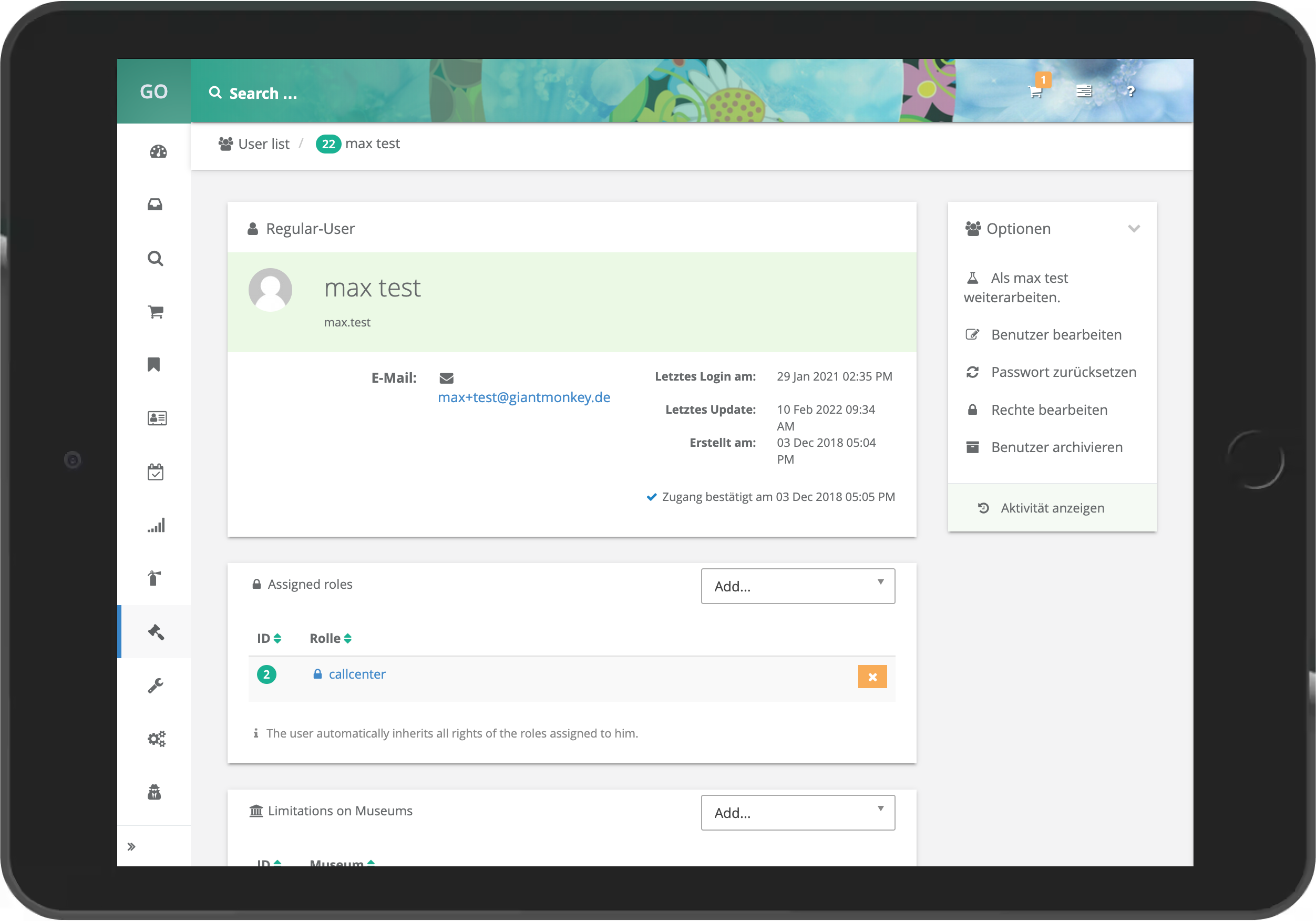
Base Data Function
Base Data Function
Management of base data in list and detail views
One of the functions included in every go~mus edition is the Base Data function. It allows you to create basic data of your institution, such as the address or the core data of your exhibitions and offers. These in turn are summarized in corresponding list views. Furthermore, each created data record can be opened and displayed in a detailed view.
In addition, the “global search” function ensures that users always find the desired content quickly.
Features
All data in go~mus is organized in list views. Consistent design ensures that users always find what they are looking for.
Extensive filters in these list views guarantee that users will keep an overview of all the data.
Sorting and search functionality make sure that users will be able to navigate to the desired data in no time.
Details of data sets are displayed in detail views. Again, consistent design ensures a satisfying user experience.
The most important information is presented in the profile of the data set, which is visible right away.
Users see the options available to them given their roles and permissions on the right hand side.
Relations to other data is configured in dedicated sections of the bottom part of every detail view.
Global search queries all relevant data sets, meaning customers, orders, bookings, museums, products etc.
Placed in the header bar it is always available and allows you to navigate to the desired data from wherever you are.
For efficient and quick search it employs sophisticated search technology ensuring results are displayed already after little search input and also if there is a typo.
Constants are the framework of go~mus. The defined structures are available as categories, filter criteria and search features in go~mus.
Define structures matching your own in the following areas:
- Age groups
- Product categories
- Salutations
- Visitor categories
- Disabilities
- Holidays
- Guide skills
- Guide categories
- Inventory categories
- Customer categories
- Countries
- Tags
- Languages
- Titles
- Target groups
go~mus + entry | Access control
Reliable access solutions are just as essential in museums as they are in all other visitor contexts. The requirements vary with size, concept and general attitude. Whether tickets are validated at the POS, staff validates tickets via visual inspection, an app is used for validating or a turnstile is set up, go~mus + entry enables you to do reliable access control.
go~mus can connect existing infrastructure or supply you with new hardware.
go~scanner
go~scanner is our Android based Scan-App. It communicates with your go~mus instance to validate tickets and booking confirmations. It can be used on smartphones as well as industry scanners.
go~scanner can validate 1D- (barcodes, e.g. Code39) and 2D-Codes (e.g. QR-Codea) as well as NFC chips on tickets and booking confirmations from paper and displays.
Smart phones can be a cheap entry into access control for your venue.
While mobile phones don’t have high performance imagers to read 1D- and 2D-Codes, when used under good lighting conditions scanning with the camera of your smart phone will do just fine.
It is usually difficult to restrict access to other apps on smart phones but that might be an advantage on less busy days.
Battery life can vary a lot and is usually not as good as with an industrial scanner but newer devices have high battery capacities and allow for a sufficiently long usage.
Wir liefern go~scanner auf Wunsch auch auf professionellen Industrie Scannern aus. Diese bieten einige Vorteile gegenüber Mobiltelefonen, sind aber in der Regel auch etwas teurer.
Industrie Scanner verfügen in der Regel über eine höhere Akku-Kapazität. Insbesondere bei langen Öffnungszeiten oder vielen Besuchern ist das ein großer Vorteil.
Imager in Industrie Scannern können 1D- und 2D Codes zuverlässiger und schneller von allen Medien (Papier, Bildschirme) lesen. Das ermöglicht schnellere Kontrolle und größeren Abstand zwischen Aufsicht und Besucher.
Die höhere Schutzklasse der Industrie Scanner garantiert besseren Schutz gegen Sturz, Staub und Wasser und sorgt so für längere Lebensdauer der Geräte.
Für Industrie Scanner ist Zubehör wie Ladeschalen, Mehrfach-Ladeschalen, ergonomische Griffe, Holster uvm. verfügbar.
Manche Museen setzen auf Vereinzelungsanlagen für die Zutrittskontrolle.
Wir können solche Systeme anbinden oder auf Wunsch auch gemeinsam mit einem Partner solche Systeme liefern. Wir arbeiten hier mit Systemen der Axess AG.
Häufig bietet sich ein Mittelweg an, bei dem das eigentliche Drehkreuz erhalten bleibt, aber der Scanner und die Logik darin sowie das Besucherdisplay getauscht werden.
In vielen Museen ist eine separate Ticketkontrolle nicht möglich oder erforderlich.
Für Tickets, die Online verkauft werden kann die Validierung mit einem an der Kasse angeschlossenen Scanner ermöglicht werden.
So können Tickets auch ohne zusätzlichen Personal- und Materialeinsatz zuverlässig und komfortabel kontrolliert und entwertet werden.
Egal ob separate Ticketkontrolle oder Kontrolle an der Kasse, häufig ist es sinnvoll, dass Tickets, die an der Kasse verkauft werden, direkt entwertet werden.
go~mus + entry zusammen mit go~mus + kasse ermöglicht genau das. Tickets werden beim Druck direkt entwertet, sodass diese Besucher nicht zusätzlich durch die Ticketkontrolle müssen.
go~mus + entry cloud | Access control plus
In addition to the access control add on go~mus also provides additional access control functionality with its Entry Cloud add on.
go~mus + entry cloud provides additional features to go~mus + entry, such as defining entry ares, entry points, ticket area access, average time of stay and area capacity.
This allows you to cover even the most complex access concepts.
go~mus + entry allows you to designate ticket scanners and turnstiles as points of either exit or entry. This allows you to capture the exact visitor count exactly, regardless of the number of entry and exit points an entry zone has.
For ticket scanners the mode can be switched in a password protected menu in the scan app or by scanning a configuration code. The mode is displayed and can be signaled with a background color in the scan app.
go~mus + entry cloud can capture visitor entries and exits per entry zone and can calculate a visitor count per entry zone. Ticket scanners with the go~scanner app can display this count of one or many entry zones. This allows supervisors to direct visitors to less crowded areas based on accurate and current information.
The visitor count can be an exact calculation given the entries and exits to and from a specific entry zone. This is most often the case, when turnstiles are in place but can also be achieved with ticket scanners. Depending on the amount of entry zones and entry points as well as the amount of visitors this can require a lot of staff and scanners.
When only entries are captured go~mus + entry cloud allows you to calculate visitor count per entry zone based on average time of stay which can be defined per entry zone. This achieves a good estimate of the actual visitor count with less staff and hardware.
